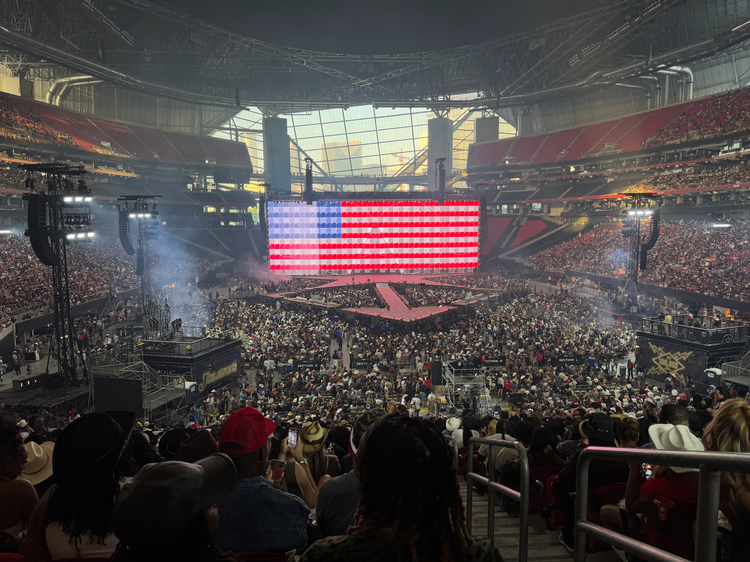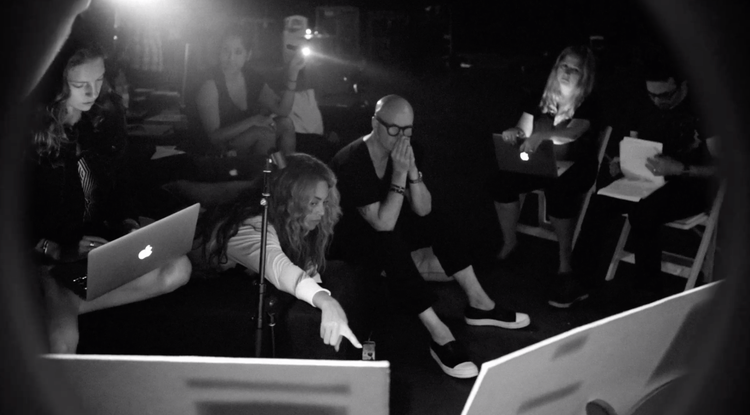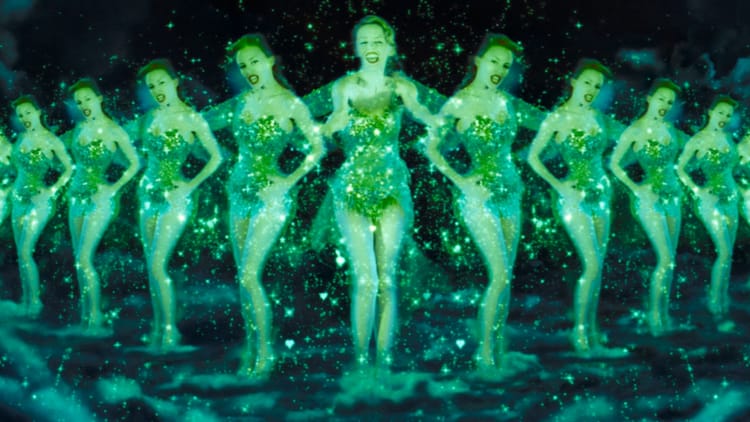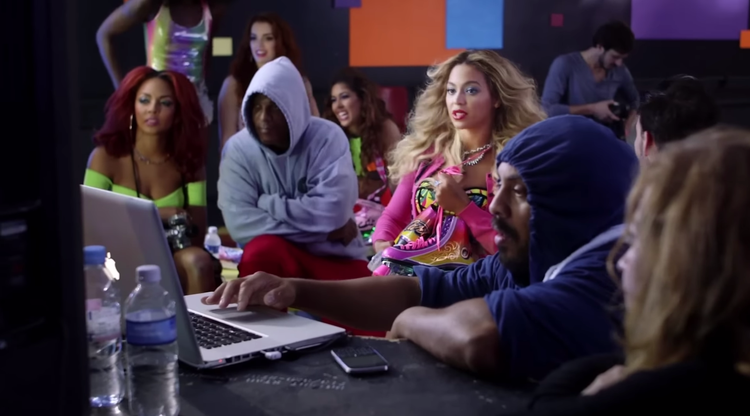A Moving-Image History of Parkwood Entertainment, Vol. II
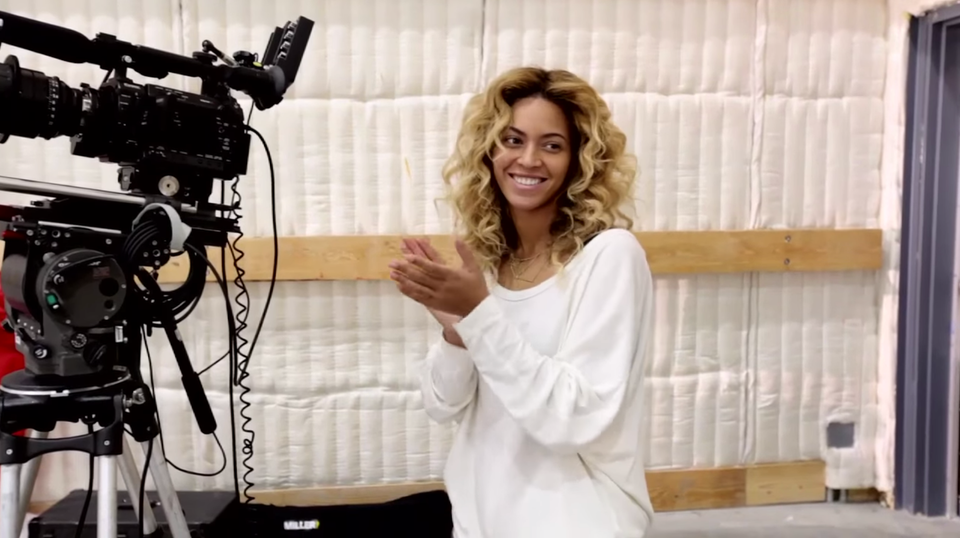
This is the second of a four-chapter series on Beyoncé’s Parkwood Entertainment and its extensive film output.
In this chapter, I follow the company—initially called Parkwood Pictures—on its early filmmaking adventures, from Cadillac Records through the 4 era. It’ll make the most sense if you’ve read the previous chapter, where I dove into the years that led up to the company’s founding. There had also been an introduction, where I explained how this series came to be and what I’m hoping to achieve with it.
This project is being published for free, but please subscribe if you’d like to know about new chapters as soon as they drop. You can read more about this newsletter here.
There’s a passage in Soul Survivors, the 2002 Destiny’s Child autobiography that I quoted from at length last time around, where 20-year-old Beyoncé writes of her admiration for Madonna—not her artistry, exactly, but her ability to spin professional hiccups to her advantage. “She is a mastermind of the music business,” Beyoncé argues in the book. “Every obstacle ever placed in her path, she’s picked up and run with it—all the way to the bank.”
What the young star says next suggests that this is an observation based on more than a decade and a half spent paying attention to the older one. “MTV banned her video?” Beyoncé writes, referring to when the network denied the scandalous “Justify My Love” (1990) any airplay:
Okay—she sold it! If anybody said something bad about her—like when the press found out about her posing for nude pictures—her response was something like, “Yeah, I did. *And*?” It’s one of the reasons she has been so successful. She’s turned all the negative things into positive things. And that’s what I try to do.
I quote this passage in part because in the next chapter, 30-something Beyoncé will draw a link between her own Parkwood Entertainment and Maverick, the company Madonna co-founded in 1992 that helped her—to paraphrase Beyoncé—be a powerhouse and have her own empire. But I mostly cite it because the story of Parkwood, like that of Maverick, is really a story about control (to borrow phrasing from a different idol of Beyoncé’s). Madonna’s company didn’t specifically stem from Playboy and Penthouse publishing her nudes from before she was famous, nor MTV being less than game when she’d just made one of her greatest videos. Nevertheless, it and Parkwood would be united by a basic idea: guaranteeing yourself some power in an industry hell-bent on humbling you.
If the story of Parkwood is one about control, then Beyoncé spent much of the previous chapter desiring more of it—only having so much say over the release dates and quality of the movies she appeared in, being disappointed with how someone else’s camera crew broadcast a performance, having to pay a third party to use footage of herself, watching rumours about supposed beef with one of her co-stars escape her grasp, and finding herself booted off of an Oscar ballot. For the first decade of her career, every triumph had seemed to come with a requisite humbling.
That’s no less true of the chapter below, but the humblings over the half a decade I cover will feel less and less consequential as the infrastructure around Beyoncé solidifies. Storms are storms, but they’re easier to weather—or at least navigate with dignity—if you’ve already got certain walls up.
Though you’ll often see people locate Parkwood’s origins in the early 2010s, Beyoncé and I both tend to go with 2008, the year she turned 27. As is her wont, she’d begun that one with a secret: while in Paris in December shortly after the conclusion of the Beyoncé Experience, she and Jay-Z had gotten engaged on the fourth of the month, his birthday. And as she’d later share in a documentary, they celebrated by catching a nude cabaret show at Crazy Horse.
In the run-up to this wedding that the world wouldn’t be looped in on, Beyoncé made her first big splash of 2008 on the Grammys stage in February. Following an introduction by Cher, she performed a mostly-spoken tribute that positioned her as a sort of concoction of Black women stars past. “When I was a little girl, I dreamed of being on this stage,” she began, “but I knew I needed all the right elements.” She then proceeded to list them one by one—Donna Summer’s beat, Mahalia Jackson’s spirit, and so forth.
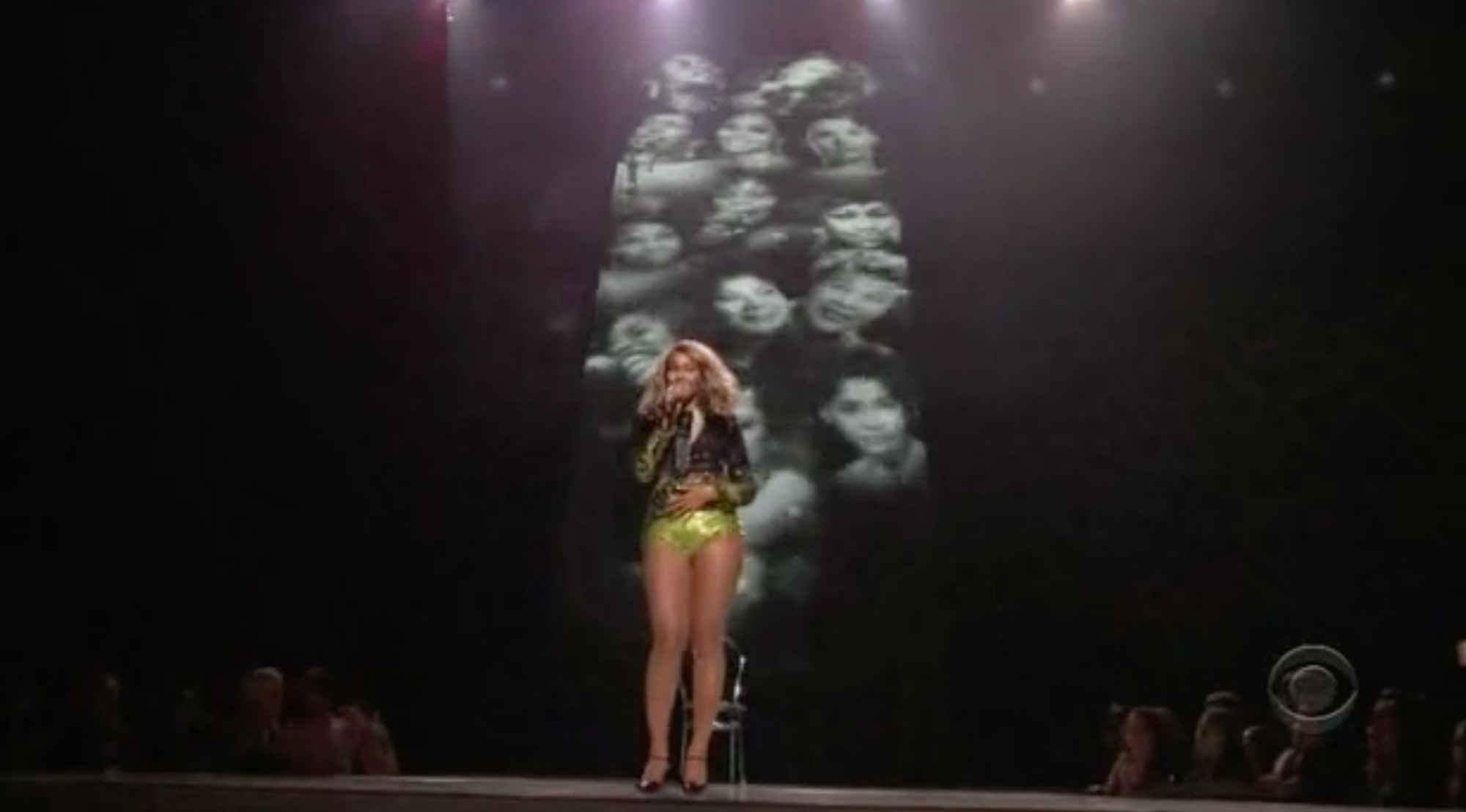
If Beyoncé named 13 women, most were/are best known as musicians, but almost all happened to have some kind of relationship to cinema. We’ve talked a bit about Janet Jackson, Whitney Houston, and especially Diana Ross’s connections to that world; Aretha Franklin and Donna Summer had their own, very different ones. Another notable inclusion was Lena Horne, a screen legend at least a dozen ways but also one of numerous Beyoncé idols who’d starred in The Wiz (1978).
Mahalia Jackson, for her part, made several film appearances in the late ’50s and early ’60s, including in Douglas Sirk’s Imitation of Life (1959), which Beyoncé will later in this story be (somewhat dubiously) rumoured to be remaking. There’s also the matter of “Take My Hand, Precious Lord,” a song closely associated with the gospel legend that had particular significance for the Knowleses; Beyoncé will not only perform it in the next chapter but release a short film about performing it. Even if some of these dots only connect accidentally or with the benefit of hindsight, they still connect.
“But there is one legend who has the essence of all of these things,” Beyoncé continued, before asking the Grammys audience to give it up for a 14th name, whom she simply called “the Queen” before exiting the stage. From there, Tina Turner—who, at the time of her death in 2023, boasted a 56-year screen career—kicked off a medley of greatest hits. And eventually, she called “Ms. Beyoncé” back out onstage to duet “Proud Mary,” the song Beyoncé had performed for her at the Kennedy Center a few years prior.
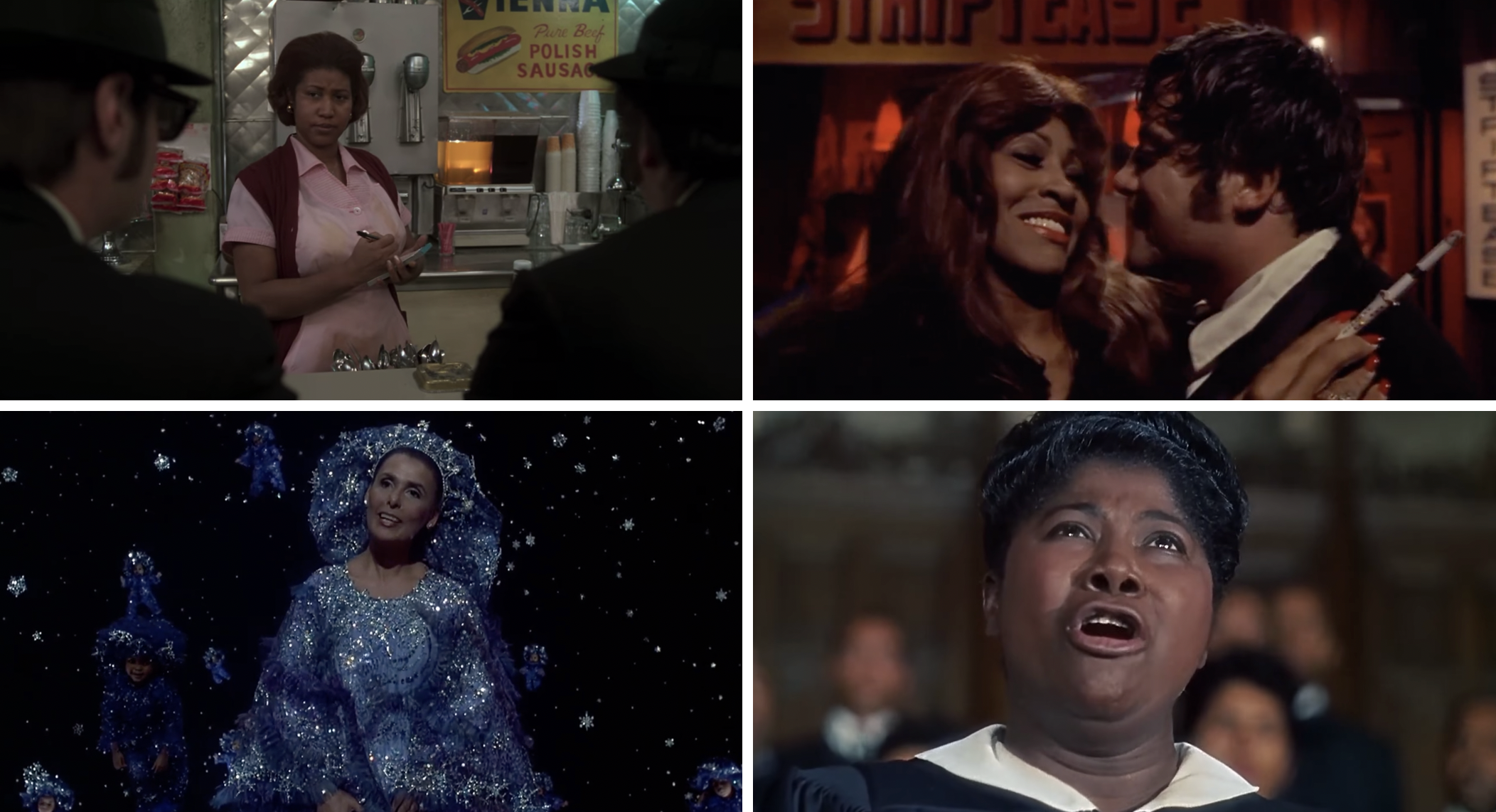
“I can’t believe that just happened,” a flustered Beyoncé told one reporter after the show. “I’ve always wanted to be so much like her, and now I’m just so excited ‘cause I have her blessing.” In all, the star would spend much of 2008 in this mode: not just drawing connections between herself and various performers she admired, but actually seeking and—for the most part—securing their endorsements.
A little after the Grammys came announcements that Beyoncé would soon be shooting a pair of new movies, both of which she’d wrap ahead of her third solo album expected later that year.
The one she’d make first, set for a December release, was Darnell Martin’s Cadillac Records (2008), broadly about music executive Leonard Chess (Adrien Brody) and his famed Chess Records. We follow Chess, a Polish-Jewish immigrant trying to make something of himself in Chicago, as he gets into the business and crosses paths with a horde of blues and rock legends—Muddy Waters (Jeffrey Wright), Howlin’ Wolf (Eamonn Walker), Chuck Berry (Yasiin Bey, then still Mos Def), and more. As with Dreamgirls (2006), Beyoncé would be playing a take on a real-life icon, this time a talented and troubled Etta James, a love interest of Chess’s in the film—and “the first African American woman to cross over on the radio,” as Beyoncé would say.
With Cadillac Records, writer/director Martin was making her return to theatres after a substantial gap; following her critically acclaimed debut, I Like It Like That (1994), she believed that she’d been “blacklisted in the industry for speaking out against racism and misogyny,” as the New York Times put it. She apparently wrote her vision of James with Beyoncé in mind, and though the prospect of playing the then-living legend was terrifying, the star signed on. “Darnell brought something out in me,” she’d say, “and I think it was because she’s a woman … She knew how to talk to me, and I knew what she meant.” Indeed, in almost a decade of appearing in narrative features, Beyoncé hadn’t yet gotten to work with a woman director on any.
Etta James was a grittier role than she’d ever pursued; aside from several emotional and sometimes raunchy dialogue scenes, there’d be a particularly unglamorous one where the character is revived after a heroin overdose. But as one piece explained, “[Beyoncé’s] mother, Tina, who vets all the scripts that are submitted to her, flagged this one as a keeper, noting that the hard-living, emotionally scarred Ms. James could be the role of a lifetime.” Ms. Tina would actually claim that she “kind of twisted Beyoncé’s arm a bit to do this one,” her daughter being extremely busy in addition to scared out of her mind.
In keeping with all of these firsts, Beyoncé chose to do yet another new thing as far as narrative work and came aboard as executive producer. “The film was initially offered to her just as an acting vehicle, and it was something she really responded to in terms of material,” her film agent Andrea Nelson Meigs would tell Billboard. “But she was drawn especially to her role because of what Etta James represented in the music world, and … wanted to get involved in a more intricate way—both in development for casting and music.” The same article explained:
Beyoncé became one of the boosters for the film, helping to bring [together] all the different elements … She aided actors with their scripts, shared her thoughts on how scenes should be shot and even got involved with lighting.
Again in an echo of Dreamgirls, Beyoncé’s commitment to the role of James was supposedly exemplified in part by a change in her weight, this time in the other direction. Now, however, the star was acting at the request of her director, who’d later take multiple interviews to express her shock that her leading lady complied. (If coverage of the Dreamgirls dieting skews irresponsible from a present-day vantage, that of her weight gain for Cadillac Records is often just silly.) “She was willing to do the work,” Martin would say:
To put on the weight and not be glamorous, to go to a very ugly place and play someone she’s never been: a drug addict, abused, abandoned by her parents. She was very excited to tear her image apart. When she first saw herself on film strung out, half-naked, overweight in the bathtub… she was so *happy*.
Despite my scoffing at the body stuff, “excited to tear her image apart” is crucial and something I wouldn’t want to gloss over. The rest of 2008 would push Beyoncé into a new tier of superstardom and—at least as she saw things—artistry, and though Cadillac Records isn’t always remembered as having been part of that push, her own comments declared it a main catalyst. Already deep into work on her album, she found that the film was changing its creative direction, turning the project both more personal and experimental. “The music I made before and after the movie [was] very different,” Beyoncé would say. “I was a lot more bold and fearless after I played Etta James … I think that’s why I love doing movies so much, because it’s not just an art form. It changes my life and my music and the way I look at things.”
At the time of filming, the star occupied a weird in-between zone on her artistic and coming-of-age journeys. On the one hand, she was a fast-rising 26-year-old who’d soon be none other than Mrs. Shawn Carter; on the other, she was still professionally and reputationally someone’s daughter, known especially for her shyness and good behaviour. “Role model” remained a title that she embraced and even used herself, and I’ve read multiple things in recent months that mention her as someone Sasha and Malia Obama looked up to. It’s almost like James provided her with an excuse to start safely teasing out the actual Beyoncé at the centre of it all, whoever that happened to be. “She was a tough woman,” the star said in one interview. “She spoke her mind, she had no boundaries. She made whatever genre of music her own, and it taught me a lot about being a superstar and a gutsy woman.”
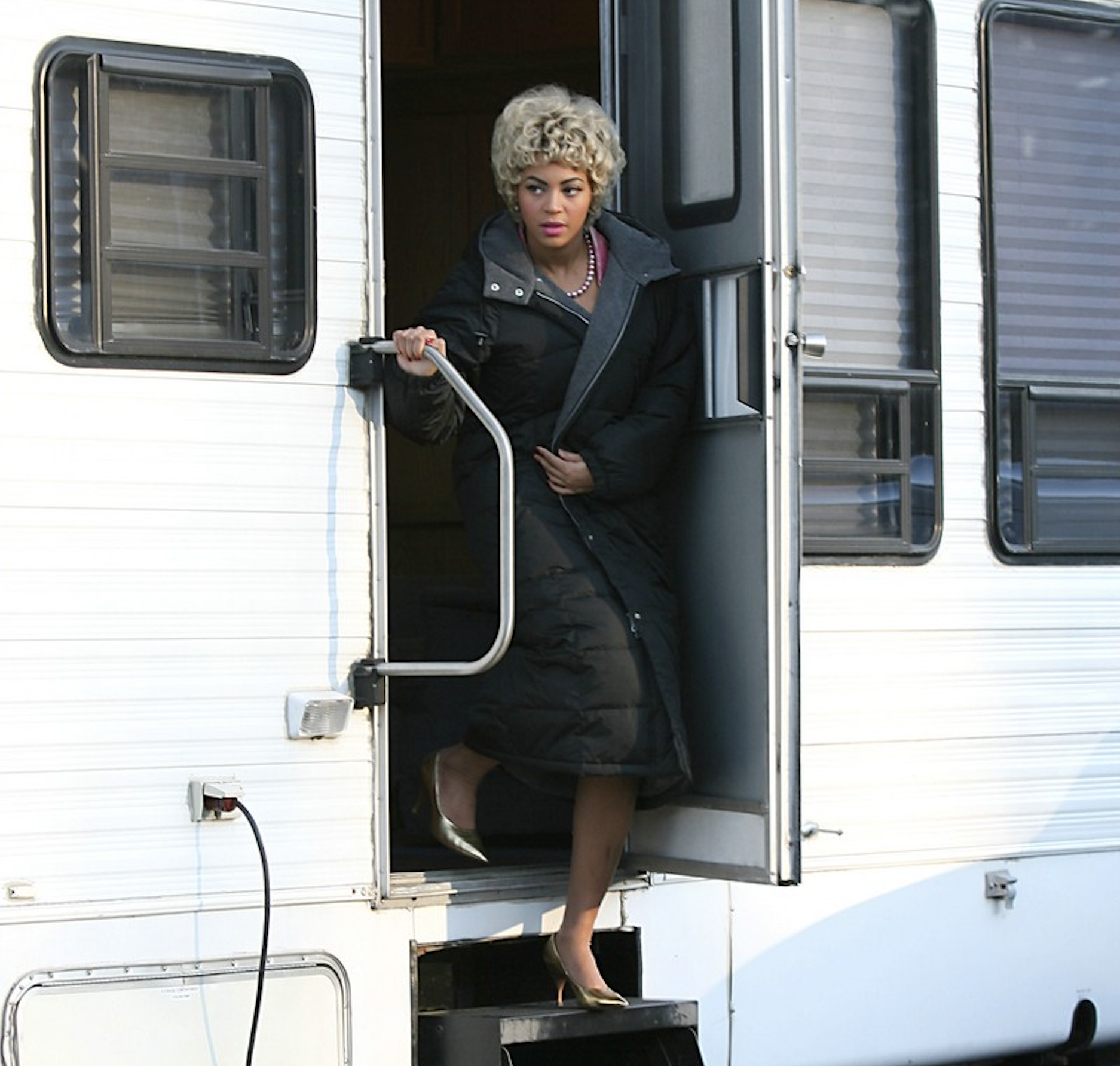
As had also been true of playing Deena, Beyoncé’s preparations for the role went beyond the superficial: she’s described learning almost everything she needed to from James’s memoir, Rage to Survive (1995), and scoured YouTube for any footage she might find helpful. But perhaps most interesting, she befriended some recovering addicts at a local Phoenix House to better understand James’s struggles with heroin. On the Cadillac Records press tour, Beyoncé would say she was very grateful to these women, and suggest that the experience had been eye-opening with regard to stereotypes. She’d also gift the organization with her salary from the film.
“I wanted to do [James] justice,” Beyoncé summarized, indicating that playing her was again a huge psychological challenge. “You couldn’t talk to me … It was one of the hardest things I’ve ever done.” Following extensive rehearsals with the cast, she knocked her scenes out in a little less than a week, apparently going home each day “with swollen eyes and with a big attitude.”
Almost immediately after completing work on the film, Beyoncé and Jay-Z were quietly married in his Manhattan penthouse on the fourth of April, or 4/4.
Upon returning from her honeymoon, Beyoncé filmed the second movie that had been announced after the Grammys: Steve Shill’s Obsessed (2009), an equal parts fun and ridiculous update of Adrian Lyne’s Fatal Attraction (1987), to be released sometime the next year. The star would be executive producing this one, too—as would her father, who doesn’t seem to have been involved in Cadillac Records beyond co-releasing its soundtrack.
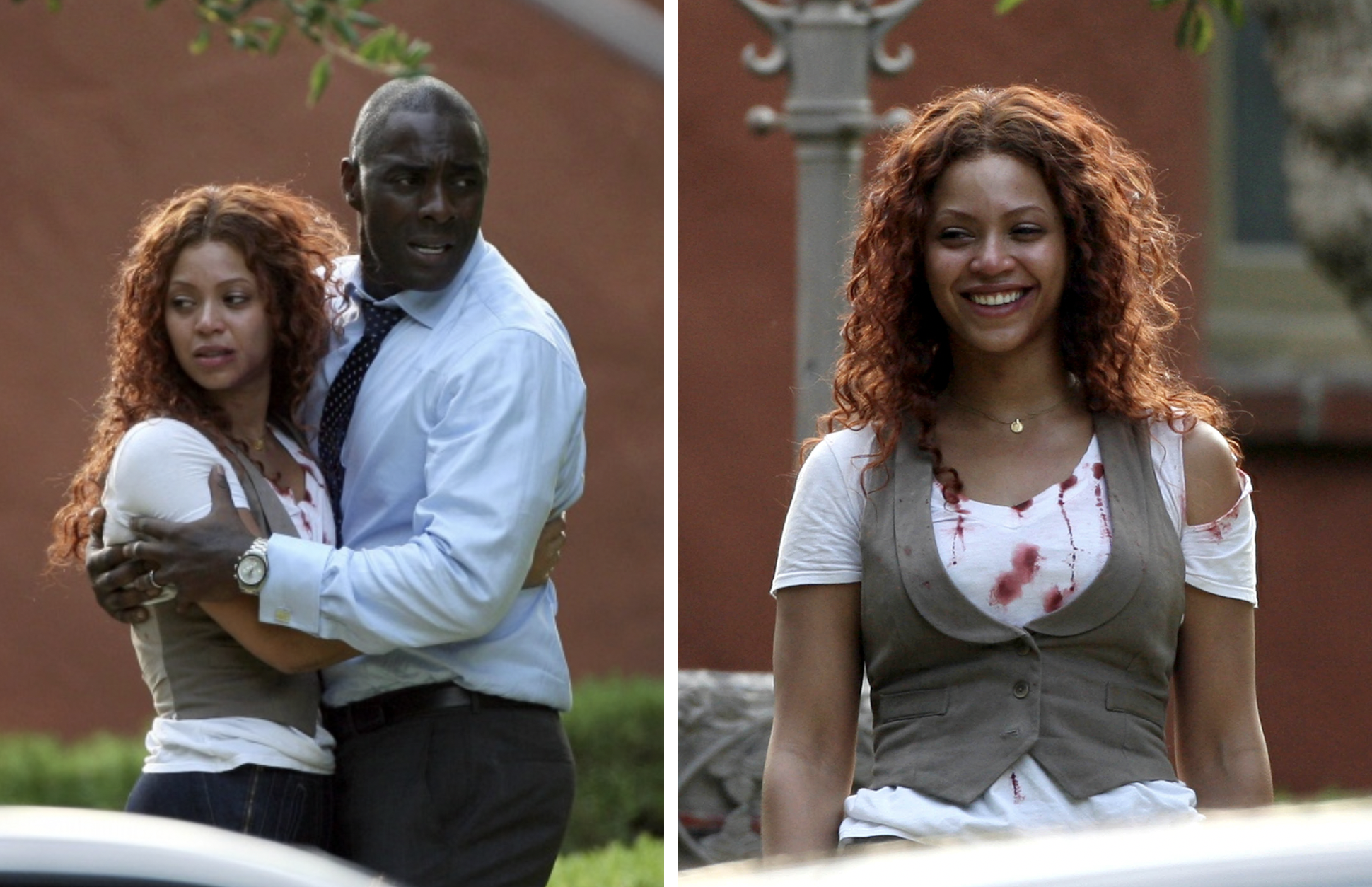
In Obsessed, Beyoncé plays Sharon, the headstrong wife—and former secretary, in a small but relevant detail—of finance power-player Derek (Idris Elba) as their family is terrorized by a temp (Ali Larter) at his company. Though the star was spotted on the film’s set in June, she spent the summer of 2008 relatively low-key as she put the finishing touches on her album.
That all changed at Fashion Rocks in September, where Beyoncé performed three times, all in the name of cancer research. Infamously, there was “Just Stand Up!,” where she was one of a dozen-plus women featured on the semi-chaotic charity single. She was also brought out during Justin Timberlake’s Motown-themed set to duet Marvin Gaye and Tammi Terrell’s “Ain’t Nothing Like the Real Thing.”
Most relevant, however, she used the event to kick off Cadillac Records promo in earnest. After donning an Etta James wig—which she also wore, for some reason, during “Just Stand Up!”—this third performance began with a Beyoncé-narrated montage of James, where she praised “music’s original bad girl” for her “platinum hair, wildcat eyes … Fellini-esque sexuality, and dangerous voice.” One of the photographs then faded out as Beyoncé’s live image faded in, the two women’s features having been overlaid, so that Beyoncé could perform “At Last,” the ’40s tune James had made her own with her 1960 recording.
Towards the end of the song came a twist: the star was helped down the stairs to where James herself turned out to be sitting in the front row. Beyoncé grabbed the blues legend’s hand, turned her around to show her the standing ovation she was receiving from the room, and gave her an excited hug. Another hard-won blessing from a performer she admired? It sure looked that way to anyone watching from home.
Beyoncé would spend the fall unrolling I Am… Sasha Fierce (2008), a two-disc concept album for which she halved herself: on one disc, she was the besotted newlywed recently renamed Beyoncé Knowles-Carter (though not yet using that name publicly), and on the other, she was the alter ego she’d created many years prior to help her give 100% onstage. “I kind of get into character like I get into character for a movie,” she explained of Sasha to one journalist.
As Beyoncé described the album concept, “I have the love songs that are probably the most innocent and pure and vulnerable songs I’ve ever recorded, and then I have the really over-the-top sexy, sassy, fiery songs that represent Sasha Fierce, and I wanted to give my fans both sides because that’s who I am.” In its promotional imagery shot by Peter Lindbergh, “Beyoncé” held a rosary in soft fabrics and minimal makeup, while the smoky-eyed “Sasha Fierce” pretzelled herself on the floor and wore a single MJ-esque robo-glove.
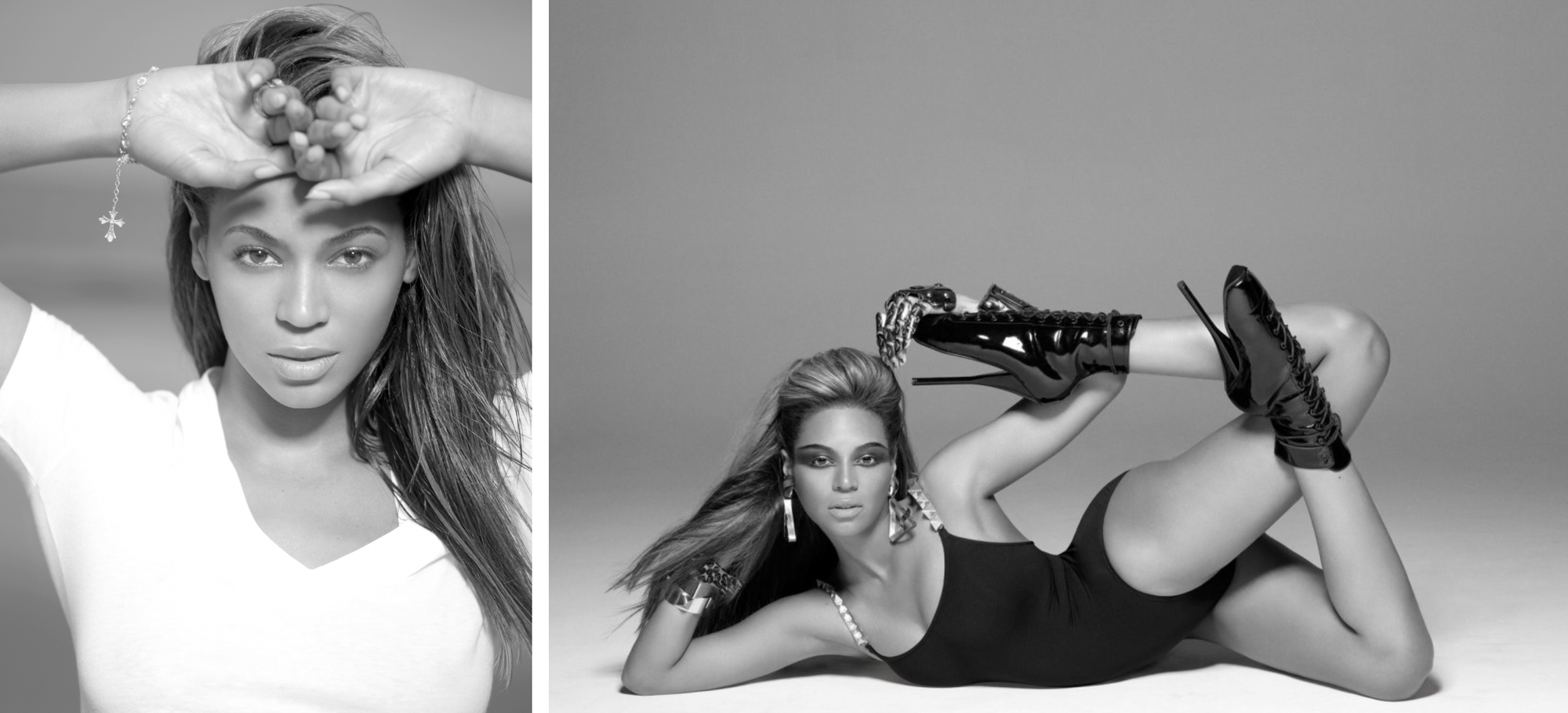
This duality was also reflected in the album’s rollout, where the first four singles were released as two sets of pairs that dropped at once; the world got “If I Were a Boy” and “Single Ladies (Put a Ring on It)” in October, and the same would happen with “Diva” and “Halo” in January. On the press tour, Beyoncé sometimes cast Sasha Fierce as the knowingly radio-safe half of the project, and I Am… as the one she felt had entered her into new territory. And though I wouldn’t have necessarily guessed this, it was the I Am… tracks that she credited to playing Etta James; there are certain interviews where she makes it sound as though the entire disc originated out of Cadillac Records. She even told one interviewer, right on the nose, “[James] gave me a better understanding of who I am.”
While most people consider I Am… Sasha Fierce to be in the bottom rung of Beyoncé’s discography these days, it’s hard to overstate how instrumental it was in cementing her as an icon. The album had nine singles, with six peaking in the top 40 and four in the top ten. Multiple lyrics from the album would enter the public lexicon, and it still generates the odd meme to this day. And while we’re going to properly get into the videos later, its most explosive one was tied up in everything from a viral dance craze, to the election of America’s first Black president, to a defining pop-culture feud of the 21st century.
For the Jake Nava-directed “Single Ladies,” Beyoncé and two dancers—all in black leotards and the classic Sasha Fierce half-up—recreated a 1969 Bob Fosse number called “Mexican Breakfast.” She was later accused of trying to pass the routine off as her own, which elided two important details. The first is how choreographers Frank Gatson Jr. and JaQuel Knight had turned Fosse’s original into one that now included J-Setting, a dance style originating with majorettes at Historically Black Colleges and Universities (HBCUs).
The other detail is the half a decade that Beyoncé had by that point spent working Fosse into her videos and tours, not to mention name-checking him in behind-the-scenes content. “Mexican Breakfast” wasn’t even the only reference to the famed choreographer and director in “Single Ladies”: the three women run up the wall in a nod to Sweet Charity (1969), and the costuming had been inspired in part by All That Jazz (1979).
But anyway, the song itself is directed at a man who blew his chance with the narrator by not proposing; at the end of the video, when we zoom in on Sasha Fierce’s robo-glove, it’s wearing a lookalike of Beyoncé’s actual engagement ring—in a sort of admission that she’d gotten married that year. “Single Ladies” kept with the album’s stated visual ethos of “natural and simple and graphic,” but its success took its makers by surprise, not necessarily intended to eclipse its splashier, costlier, dare I say cinematic twin video as dramatically as it did.
In “If I Were a Boy,” also directed by Nava, Beyoncé plays a cop toying with the emotions of the man fretting over her fidelity from home—until the characters swap bodies during a dialogue scene halfway through, in what becomes a commentary on gendered double standards in (straight) relationships. “It’s kind of like Freaky Friday,” Beyoncé had told Billboard ahead of the tandem releases, in an article that didn’t bother teasing the content of “Single Ladies” at all.
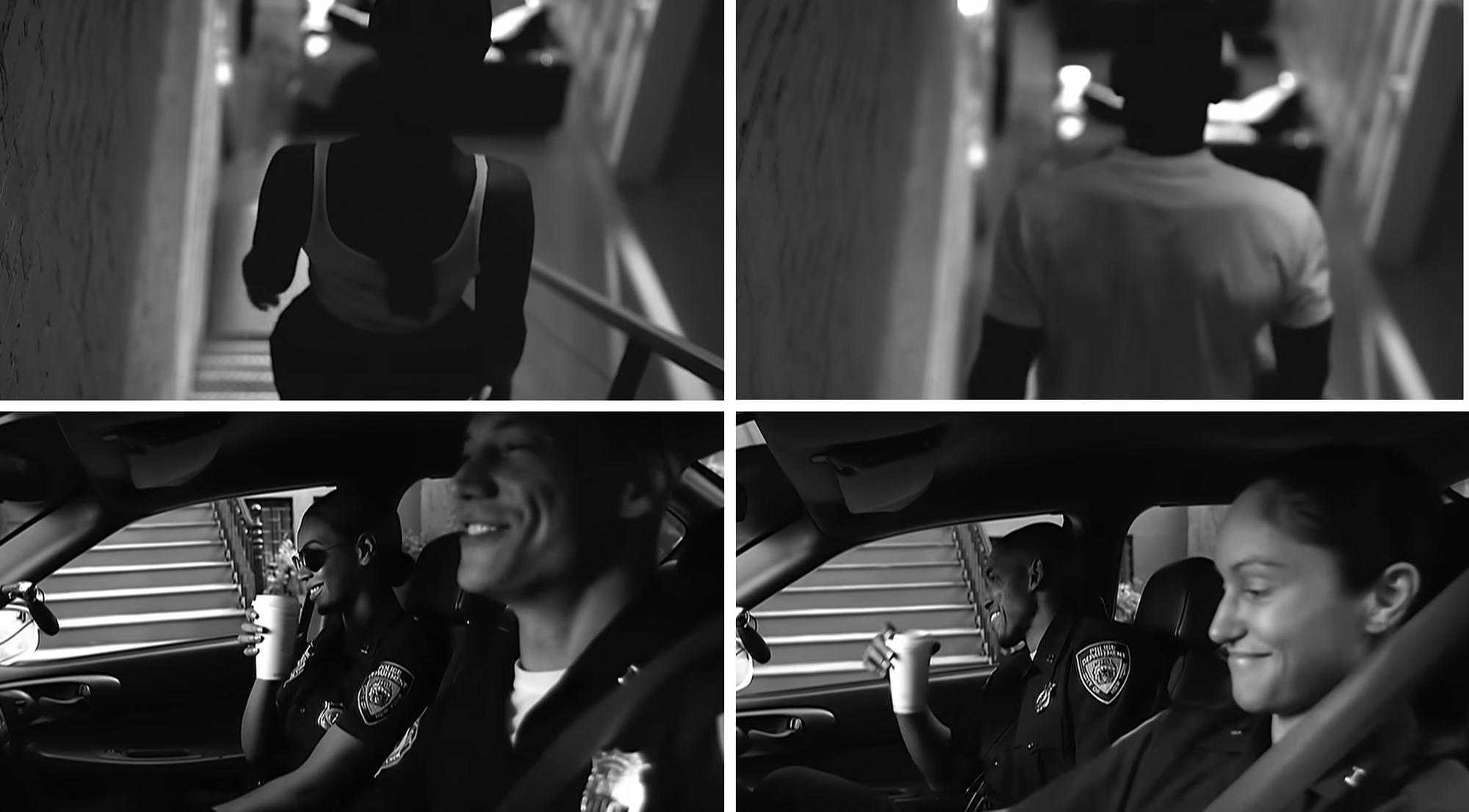
Both songs would be top-three hits, so “If I Were a Boy” obviously did just fine. But one might still extrapolate that the comparatively phenomenal “Single Ladies” better reflected what the public actually wanted from Beyoncé in 2008. Fans may not have minded her injecting her work with storylines and dialogue and some commentary—making a little movie, essentially—but most of the world was perfectly happy just to watch her sing and dance to a new uptempo.
About a month after the two releases, on the fourth of November, Barack Obama was elected the 44th president of the United States. I Am… Sasha Fierce hit stores a week later.
Beyoncé’s earliest YouTube uploads, at least that still remain on there, are from the same November. And since she’ll later choose the platform as the release method for certain films, I’ve had to decide case by case whether a given video should be considered among her filmography, or even just mentioned in this story. (It’s not always as obvious as it may seem.)
The first video on her channel is a teaser for her 2008 episode of Walmart Soundcheck. The retailer used to produce segments featuring a live set and interview with a popular artist, and you could either download these or watch them in a Walmart while you shopped.
The live bits of Beyoncé’s episode, released in mid-November, came from her set at the Bermuda Music Festival the previous month. In lieu of an interview, however, there were doc segments—just under 20 minutes combined—that pulled together videography from the past little while. Interestingly, IMDb credits the episode to Mark Ritchie, a prolific live director in the music space who’ll later be credited on a number of Beyoncé projects, both released and unreleased.
There’s a stretch of the episode where we see the star preparing I Am… Sasha Fierce, explaining in what was starting to become her trademark lulling voiceover:
I’m a human being. I cry. I’m … extremely sensitive, and my feelings get hurt. And I get scared, I get nervous, just like everyone else. And I wanted to show that on this album … Even with my videos and my photoshoots, everything’s a lot more natural and broken down.
As with the untitled Beyoncé Experience documentary in the previous chapter, there’s a segment on her commitment to charity, where virtually all of this footage comes from her 2007 tour (some of it being the Ethiopia stuff we’d seen in the previous film). Eventually, she settles in Bermuda to rehearse her festival performance… also taking the travel opportunity to shoot a campaign for House of Deréon, the clothing line she used to design with her mother.
If this is all reading vaguely chaotic, you aren’t imagining it: in the years leading up to Life Is But a Dream (2013), there were a couple of Beyoncé projects like this, where you could sense the star becoming excited about the documentary format and seemingly throwing in anything she had on hand when she got a chance to make one. By this time the next year, she’ll have realized that there’s clearly an autobiographical feature in her future, but first there would be some releases with somewhat sprawling narratives.
And in an important asterisk to what I just said, there’s a moment in the episode where she proves herself to be a flawed historian of her own life. “I decided I wanted to perform ‘At Last’ for the first time with my band,” she narrates of her Bermuda set, before following that up with a bald-faced lie: “It would also be the first time I sang the song live. I was excited to see how the audience was gonna respond to something they’ve never seen.”
Though this wasn’t the kind of revisionism that was going to hurt anyone—we’d all just watched Beyoncé perform the song for Etta James—it’s in line with something you’d have to watch out for with her in the future. There was the star’s life, and then there was her life as she presented it in her documentaries.
Cadillac Records was released in December, a few weeks after I Am… Sasha Fierce. And while it wasn’t a commercial smash, nor even really a success—it made about $9 million worldwide, meaning it didn’t make its $12 million budget back in theatres—it marked an important milestone on Beyoncé’s journey as both a gracer and maker of movies. It takes her a full hour to show up as Etta James, but she goes on to deliver what’s easily her greatest dramatic performance in a scripted film. And she recognized as much, saying, “I’m the most proud of that movie, more than anything I’ve done so far.”
Though reviews of the film were mixed, most critics agreed that Beyoncé’s performance had been something special—“devastating” according to Vogue, and “inspired and persuasive” according to Roger Ebert. Even her onetime Golden Globe competitor Meryl Streep apparently congratulated her on the ‘rawness’ of it. “It’s startling to see Ms. Knowles—one of the few pop stars left with a wholesome, good-girl image—swaggering and swearing through her performance,” wrote the New York Times. It would take another half a decade for Beyoncé to start cursing in her music, yet here she was yelling out for a “fuckin’ bottle of gin!” on the silver screen. It wasn’t any surprise that the singing bits were great, but it didn’t feel so much this time around like they’d been her saving grace.
Beyoncé’s co-stars also went on record with their praise. Adrien Brody, with whom she shares her trickier scenes, admitted that he “didn’t anticipate her being as emotionally present and connected with the role as she was.” Jeffrey Wright would call her “an evolving, complicated young woman who is going to surprise some people who think they have her pegged.”
The problem, put bluntly, was that Cadillac Records flopped—whether because it was undermarketed, or the Recession, or any of the other theories put forward in this 2008 discussion forum. In any case, the underperformance not only doomed it to a lacklustre awards season but failed to transform Beyoncé’s screen reputation the way it had potential to.
Press coverage tended to mention that the star had executive produced it, but not so much that this second role went beyond a vanity line in the credits. In the opening moments of Cadillac Records, after we get the bumpers for TriStar and Sony Music Film, there’s a third one for a mysterious company called Parkwood Pictures, the font similar if not identical to that being used on the visuals for Beyoncé’s album:
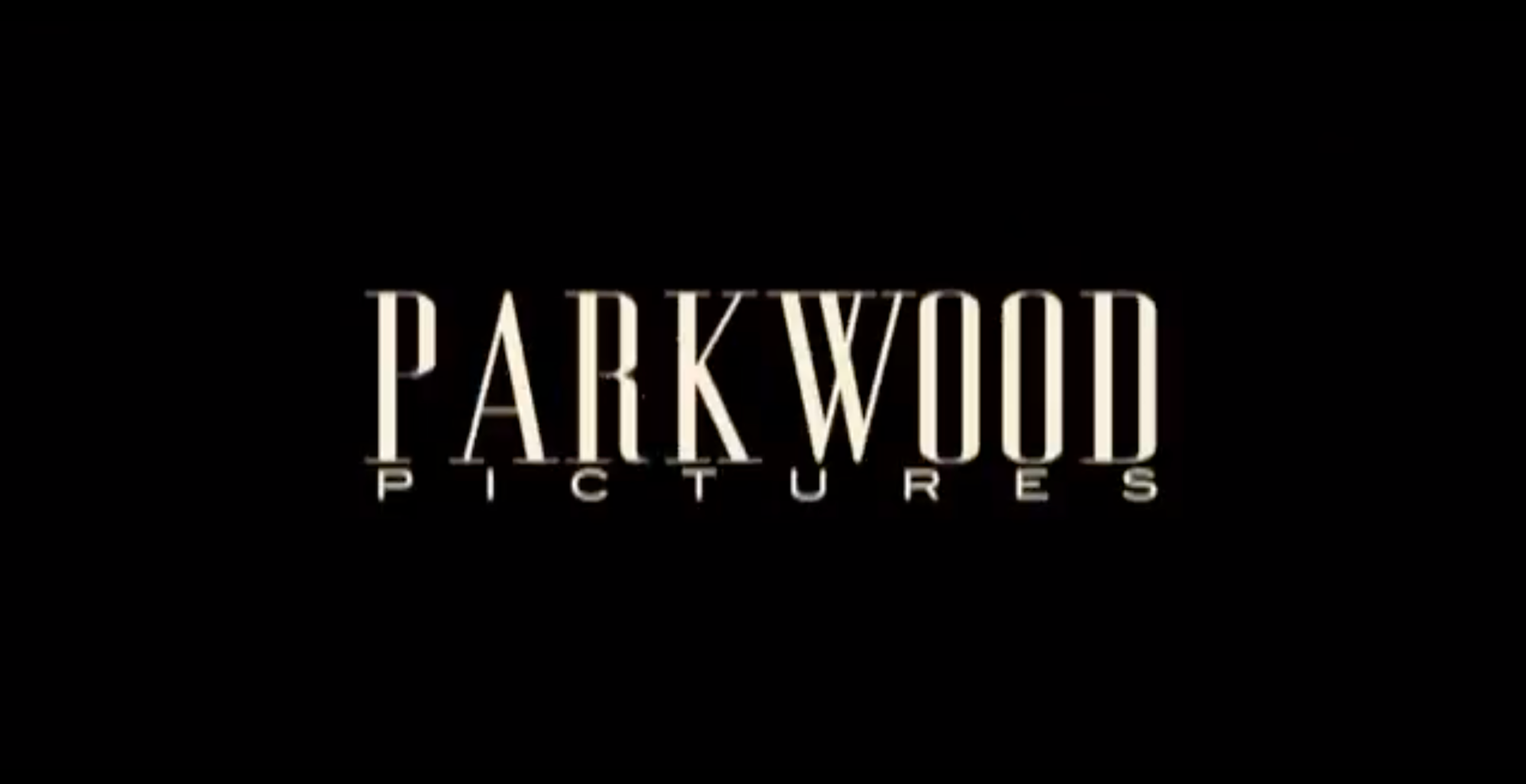
The company’s name referred to one of the streets in Houston where she grew up, in a house that’ll become more significant in this series as it starts to appear in her films with curious frequency. So no matter how long it takes Etta James to arrive in Cadillac Records, Beyoncé herself hovers over the lot of it if you’re someone to whom the name Parkwood means anything. And that’s true all the way into the credits, for which she recorded an original song called “Once in a Lifetime,” a romantic doo-wop track with slight electronic flair. (Interestingly, she’d written it with the exact same team behind “Listen” from Dreamgirls: Henry Krieger, Scott Cutler, and Anne Preven.)
Another aspect of the film that reads differently now is its parallel storyline, about how indebted white rock is to Black country blues. (At one point, the not-yet-famous Rolling Stones briefly cameo to tell Wright’s Muddy Waters that they named themselves after his song “Rollin’ Stone.”) Beyoncé’s previous movie roles had sometimes posed opportunities to go deeper into some area of Black music and/or film history—Dorothy Dandridge becoming the first Black woman nominated for Best Actress in Carmen Jones (1954), the heyday of blaxploitation, Berry Gordy and the rise of Motown. But with Cadillac Records, the lesson was right there in the text, the characters not being stand-ins or composites the way they’d been in Dreamgirls.
In one interview, Beyoncé even characterized the film as educational:
This is really an important story, and it’s great that I’m able to … share this with my generation, because it’s a lot of things that I didn’t know, and I’m sure a lot of other people don’t know, and they’ll be educated. It’s the story of rock and roll.
If I’d published this series any earlier than now, I wouldn’t have been able to mention that the Cadillac Records soundtrack includes a Mos Def cover of Chuck Berry’s “Maybellene,” a sample of which appears on Cowboy Carter (2024). The 2008 film also has a scene where Berry learns that his song “Sweet Little Sixteen” has been repurposed—“note for note,” as he complains to his Chess Records colleagues—into “Surfin’ U.S.A.” by the Beach Boys, who are themselves sampled on Beyoncé’s eighth album.
“Beyoncé clearly seeks out role models and thumbs through music history the way some people browse catalogs,” wrote Geoff Boucher in a late-2008 profile of the star. “She carefully channeled the icy perfection of Diana Ross in ‘Dreamgirls’ and jumped at the chance to perform with Tina Turner at February’s Grammy Awards ceremony. Now comes her turn as Etta James, and, on Sunday, she will seek out her hero, Streisand; Beyoncé will perform ‘The Way We Were’ at the Kennedy Center Honors and she already has butterflies.”
There may have been a bit of a sense in the aughts that Beyoncé idolized, well, everyone, but you couldn’t accuse her of having bad taste. She’d also been pretty consistent with her references since her breakthrough: Streisand’s name came up twice in the previous chapter, with Beyoncé citing her as a musician-turned-actress she admired as well as a reference for Deena Jones’s mannerisms.
Ahead of performing the theme from Sydney Pollack’s The Way We Were (1973) that December—a performance for which she dressed up as Babs, just as she’d dressed up as Turner in 2005—she told Boucher for the L.A. Times that she considered Streisand a “career model,” adding, “I want to be like her. She is just the ultimate. And I want to be an icon too.”
In the same conversation, Beyoncé also threw a very different name into the mix:
I want to do a superhero movie and what would be better than Wonder Woman? … A black Wonder Woman would be a powerful thing. It’s time for that, right? … After doing these roles that were so emotional I was thinking to myself: “OK, I need to be a superhero.” Although, when you think about the psychology of the heroes in the films these days, they are still a lot of work … and emotional. But there’s also an action element that I would enjoy.
As a reminder, the star had appeared in that one “Listen” video wearing a Wonder Woman shirt. But she told the L.A. Times that she’d become especially interested in this idea after the Met Gala in May, where Lynda Carter’s ’70s costume had been on display. As per Boucher, Beyoncé had already “met with representatives of DC Comics and Warner Bros. to express her interest in a major role in one of the many comic-book adaptations now in the pipeline following the massive success of ‘The Dark Knight,’ ‘Iron Man,’ and the ‘Spider-Man’ and ‘X-Men’ franchises.”
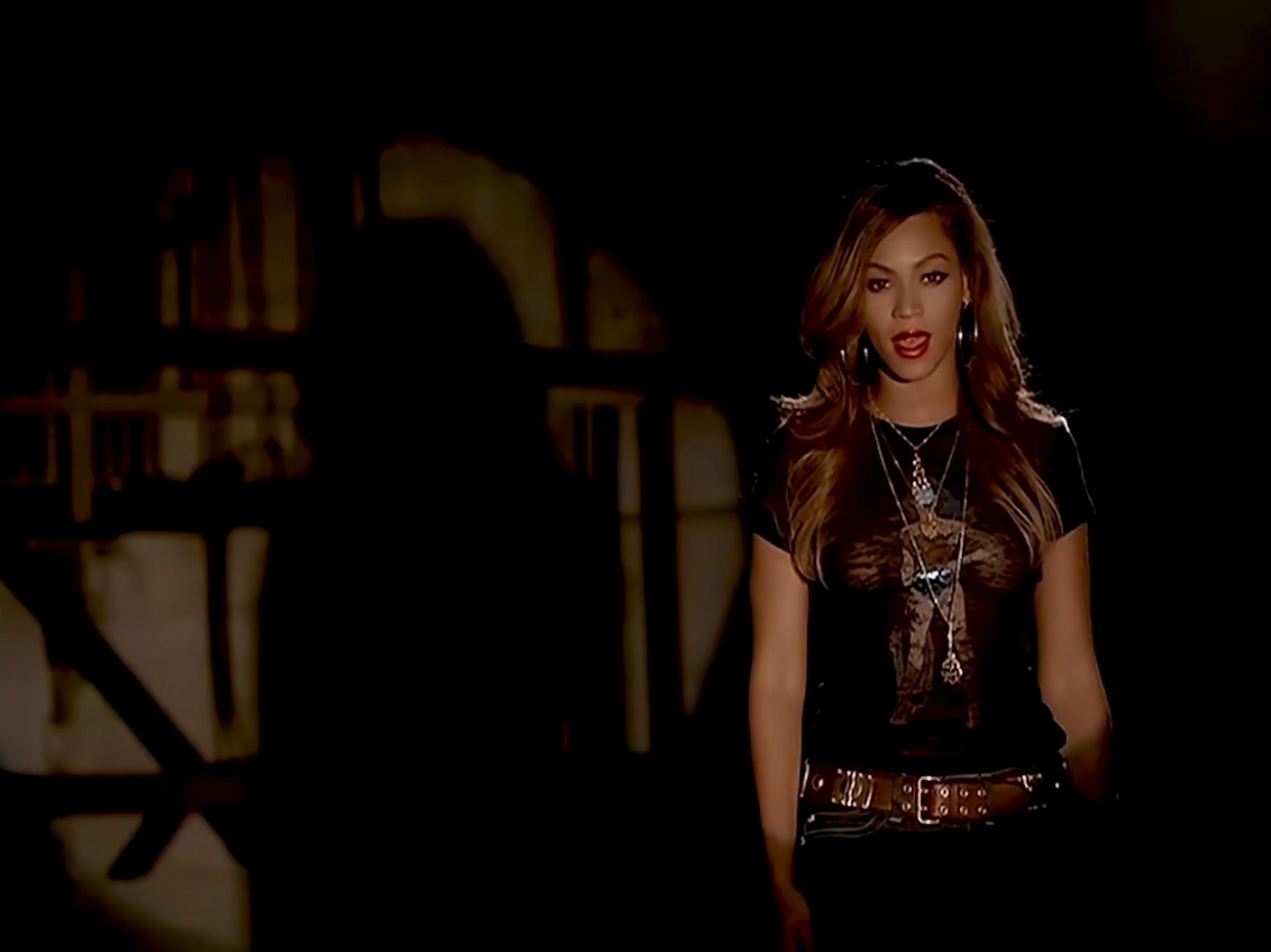
Running alongside Beyoncé’s history at the movies are all the what-could-have-beens—movies she wanted but wouldn’t get (or that weren’t made in the end), movies she may not have actually wanted that badly, movies that were hers until life intervened, movies she was rumoured to be working on that potentially never existed, and so on. That Beyoncé campaigned for a DC superhero role is the earliest what-could-have-been I’m discussing in this story—I didn’t mention last time that she’d auditioned for Josie and the Pussycats (2001), a very different would-be debut from Carmen: A Hip Hopera (2001)—but it’s somehow neither the strangest nor the most compelling.
“It sure would be handy to have that lasso,” Beyoncé concluded. “To make everybody tell the truth? I need that.”
While Cadillac Records was nominated generously by Black organizations like the Black Reel Awards, NAACP Image Awards, and BET Awards—Beyoncé received acting nods from the latter two—the film was largely shut out by major film institutions. The sole exception came from the Golden Globes, with the star nominated for Best Original Song for “Once in a Lifetime.” The award eventually went to Bruce Springsteen and “The Wrestler” from The Wrestler (2008), and neither artist would be nominated at the Oscars in February.
As in 2007, however, Beyoncé not only attended the 2009 ceremony but participated in it, helping host Hugh Jackman carry out a big tribute to musicals. The segment was the show’s sole contribution from director Baz Luhrmann, whose involvement helped explain its jukebox approach. Beyoncé was surprise-introduced with a stretch of “Big Spender” from Sweet Charity, a number she’d by that point tributed on two different tours.
While clips from various movie musicals played behind her and her co-performers, she sang bits of everything from “All That Jazz” from Chicago (2002), to “One Night Only” from Dreamgirls, to “Don’t Cry For Me, Argentina” from the Madonna-starring Evita (1996). The medley also included a quick slice of “At Last,” a song that Beyoncé was beginning to uncouple somewhat from Cadillac Records.
A month prior, she’d fought back tears to perform the Etta James classic for Barack and Michelle Obama as they shared their first dance at the inaugural ball—the love song thus recast as a paean to racial progress, as critics observed at the time. (Two days before that, she’d performed “America the Beautiful” at the official inauguration concert, eventually joined onstage by several names that have appeared in this story—Springsteen, Tom Hanks, Josh Groban—as well as names that’ll appear later, like Stevie Wonder.)
A week after the inauguration, James told a crowd that Beyoncé was “gonna get her ass whipped … I can’t stand [her], she had no business up there singing … my song that I’ve been singing forever.” Though the blues legend claimed the next week that she’d been just joking, she still admitted to “feeling left out of something that was basically mine.” (These were only the latest in a string of less-than-impressed quotes spanning about a year.)
So here we found Beyoncé in late February, killing two birds at the Oscars. The medley not only telegraphed that she remained unafraid of the Academy of Motion Picture Arts and Sciences, but that she also planned to continue performing “At Last” in whatever context she wished.
The song was included, for example, on the setlist of the I Am… World Tour, which began the next month. The tour would take Beyoncé around the world for a year; we’ll be coming back to it, but you should assume as you continue reading that she’s embarking on her most ambitious live show yet in the background of everything else.
That same spring came Obsessed, a movie that would be ripped apart by critics but do well commercially, grossing more than twice its budget. Sharon Charles, the redheaded wife and semi-reluctant homemaker to Idris Elba’s Derek, was the first role of Beyoncé’s where she didn’t play a performer. (Though “Smash Into You”—from the deluxe edition of I Am… Sasha Fierce—plays during the final scene and credits, things are left there in terms of soundtrack stuff.) According to producer Will Packer, who’d originally brought the script to the attention of Beyoncé’s team, that was the whole appeal: “This was something very different than what she had done in the past, and I know she was looking for that challenge and welcomed this opportunity … something different from that global persona that she’s [worked] hard to create.”
For much of the movie, the star’s job as Sharon is to worry about her husband from the beautiful big house they’ve just moved into, where she takes care of their son and fantasizes about going back to school. But when Ali Larter’s Lisa—a stalker with her sights set on Derek—enters the picture and starts causing marital mayhem, Beyoncé actually gets something to do.
During what’s probably the film’s second-most infamous moment, Sharon and Derek do the dialogue scene from All Too Well: The Short Film (2021), down to the hair and costuming. Unsure whether he’s cheated but knowing he’s lied regardless, she sardonically suggests a packing list for him—including “your prophylactics if you think you need ‘em”—and then screams at him to get out of her house.
The film is best remembered, though, for its climactic fight between Sharon and Lisa, a ten-minute sequence culminating in a Fatal Attraction-esque almost-death (Lisa falls from the attic into a glass coffee table on the ground floor) before an actual one (a chandelier then falls on top of her, finishing the job). Like the previous encounter, this one is rife with one-liners on Sharon’s part—“I’m gonna wipe the floor with your little skinny ass,” for example—and made extra dynamic because Sharon wants Lisa to suffer but, as it turns out, not die gruesomely in her living room while she watches.
Interviewed for Vogue around the film’s release, Beyoncé was asked by Jonathan Van Meter about the ease with which she seemed to deliver anger onscreen. “Everyone has it in them,” she responded. “I always have to be so put together, I always have to be pleasant. But sometimes I want to scream and holler, and I’m able to use the characters to release whatever pain or frustration has built up in me.”
As with all the roles in this series, I’ve done a lot of thinking about why Beyoncé may have taken this one in Obsessed, especially given the executive producing. (At one point, she arrived for work with pages of typed-up notes on the script.) She’s allowed to do things just for fun or money, though she was famously short on time and presumably not all that cash-strapped. She wasn’t starved for film offers, either; in various interviews she gave during the period covered in this chapter, she mentions having anywhere between three and ten scripts on hand.
I believe Will Packer when he says that Beyoncé was excited about playing a non-performer, but I don’t believe it was that simple. I’d even push back on the idea that Sharon was “something different from that global persona [Beyoncé had worked] hard to create,” since playing her involved the exact same duality as I Am… Sasha Fierce; depending on the scene, she’s either the loved-up wife or the fiery protector you shouldn’t mess with.
But to elaborate on that thought, one wonders whether there was some interest Beyoncé had, optically, in making a movie where she (eventually, after a brief separation) stands by her man as their marriage is threatened by an interloper. The crucial difference between Fatal Attraction and Obsessed—quality aside—is that Derek Charles, unlike Dan Gallagher, has not cheated with this woman, however much Lisa is making it look that way.
There was also a racial element that hadn’t existed in Adrian Lyne’s erotic thriller: part of the underlying tension in Obsessed comes from Lisa being a pretty white lady who’s lying left and right about her Black boss, successfully sowing doubt in the minds of his all-white colleagues and the white detective assigned to his case. (That Sharon is someone he originally picked up at work doesn’t help, either.)
Some of this might be a lot to read into a film made almost a decade before Lemonade (2016), but the years leading up to the later project were beset by cheating rumours on Jay-Z’s part—and Beyoncé had churned out quite a few bangers about ringing the alarm on men who were untrue and had mistresses.
Even if it’s ultimately a different argument, it was validating to read Jason King observe something related about Obsessed, in a 2019 piece on Beyoncé’s acting that I cited throughout the last chapter: “It served a purpose: to transgress against [her] and Jay-Z’s much publicized off-screen marital bliss. In a way, the film arguably prefigured the relationship cracks and fissures that later became the crucial themes for her groundbreaking 2016 [visual album].” Whatever the star was riffing on/setting up—even if she wasn’t riffing on/setting up anything—it was a fascinating movie to film shortly after your own wedding.
But no matter these speculations, it says something that when Lemonade came out—and when Cowboy Carter followed “Jolene” up with “Daughter,” a song about beating the hell out of a woman in the bathroom of an event—people made memes out of the bloody fight scene from Obsessed.
The star’s recent film work was one of the main focuses of Van Meter’s Vogue cover story, and it’s an interesting read as a relic of a time when you could still do actual journalism in a cover story of Beyoncé. One quick example, on Obsessed: “The best that can be said for this movie is that it is destined to become a camp classic.”
The piece, though, is altogether optimistic about her future in this second medium. Van Meter is particularly complimentary about her performance as Etta James: “Like most people, you probably missed her role in last year’s critically acclaimed Cadillac Records, and that’s a shame.” In the years since its release, the film has typically been written about this way, as the would-be gamechanger for Beyoncé’s screen career that no one saw.
“I’m finally connecting the way that I connect with music,” she says of acting. “I’m getting lost in the movies the way I get lost onstage.” There are also co-signs from Hugh Jackman, who has “no doubt she’ll win an Oscar one day,” and Baz Luhrmann, who predicts, “I’m sure that there is a dramatic cinematic life for her … It’s been a long time since we’ve seen that kind of performer, like Barbra Streisand and Diana Ross, on the screen.”
Van Meter also inquires about the dynamic between the star and her parents. Ms. Tina, as always, is positioned as the genial vetter of screenplays that come her daughter’s way. Initially, Beyoncé says of Mathew being her manager, “The best thing is having someone I trust.” But pushed a little on this, she adds, “It’s definitely tense. And if there’s one person in my life I argue with the most, it’s him. But it’s business. It’s always about business.”
“Their whole lives are not… me,” the star concludes. “But if they wanted to retire, I’m sure we would figure out who would help me.”
In June, Beyoncé released a DVD called Above and Beyoncé: Video Collection & Dance Mixes (2009), featuring the so-far six videos from I Am… Sasha Fierce. (A few more—“Sweet Dreams,” “Video Phone,” and “Why Don’t You Love Me”—would follow later.)
The project came with a 20-minute short called Behind the Scenes: The Videos (2009), directed by the star’s longtime videographer, Ed Burke. Bolstered by footage from rehearsals and shoots, she spends a couple of minutes talking about the making of each video before moving on to the next. (“Sweet Dreams” is included despite not being on the DVD, since the video wouldn’t come out for about a month. It would later get an extended making-of segment, where Beyoncé name-checks Hellraiser and talks about the cinematography reminding her of “the old MGM musicals.”)
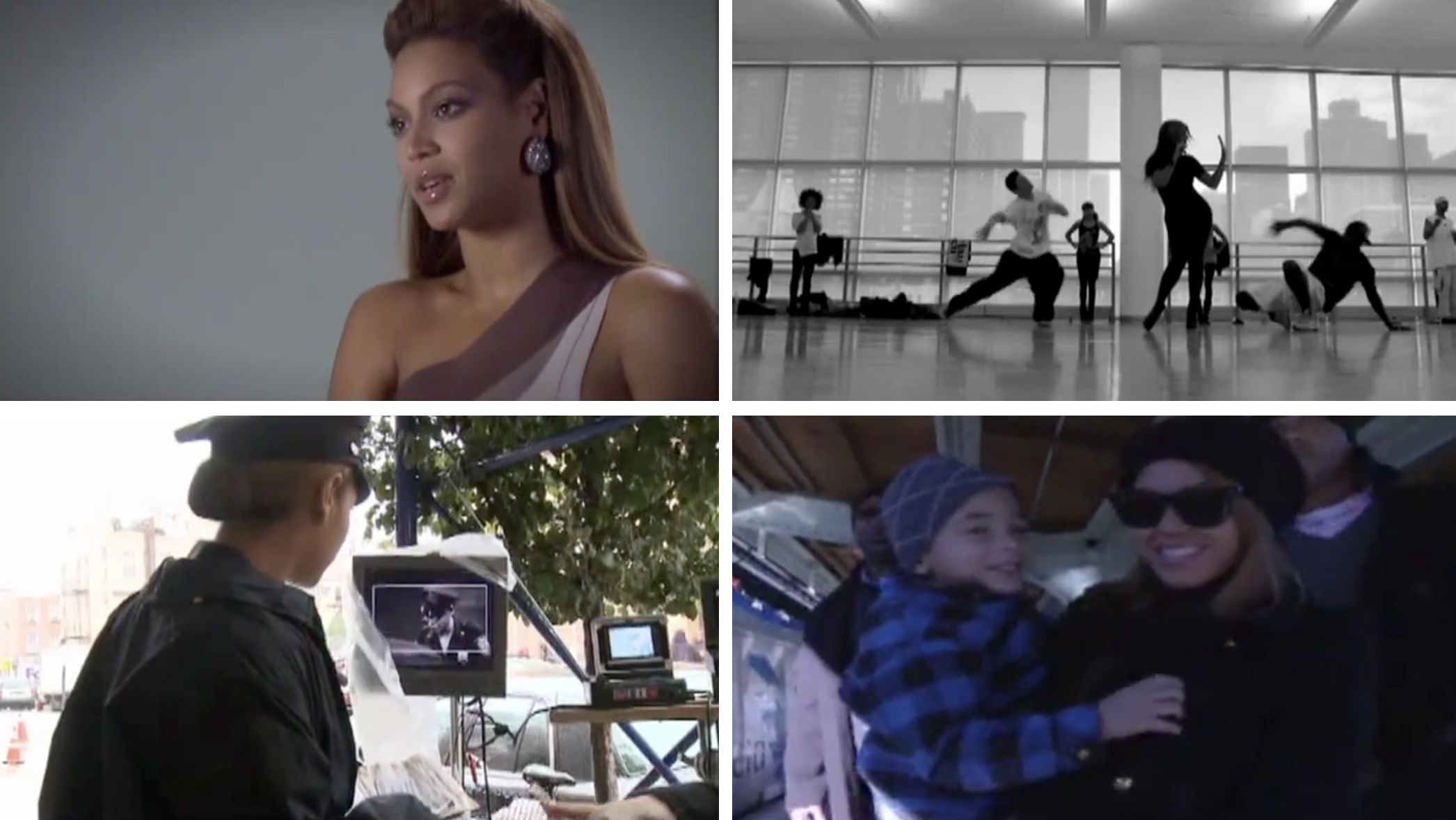
With the odd splash of colour, especially as the era progressed, the visuals for the album were almost entirely black-and-white—apparently in part to spite a market research agency that claimed fans didn’t like when Beyoncé used B&W photography. Taken as a whole, they’d largely be directed by names already familiar to us: Jake Nava (“If I Were a Boy,” “Single Ladies”), Melina Matsoukas (“Diva,” “Why Don’t You Love Me”), Sophie Muller (“Broken-Hearted Girl”), Hype Williams (“Video Phone”), Frank Gatson (“Ego”), and Beyoncé herself (“Ego,” “Why Don’t You Love Me”). The two new additions were Adria Petty (“Sweet Dreams”), daughter of Tom but an accomplished artist in her own right, and Philip Andelman (“Halo”), who’d previously done a bit of work for Jay-Z and Kelly Rowland separately.
“Halo” featured another of the album’s more ambitious concepts, but the version the world saw had been significantly defanged from the original. In the released cut, Beyoncé is an angelically beautiful woman in love with her handsome man (played by Michael Ealy, who’d turned down “Irreplaceable” a few years prior). He watches her rehearse choreography; they cuddle on the couch; they joke around while brushing their teeth. But the video’s making-of segment featured footage of a femme fatale-looking Beyoncé driving a car in the dark, and this set-up did not appear in “Halo.”
The next year, a very different cut would leak online that both explained the driving footage and told a much darker story: Ealy’s character is being tracked through the forest by a bunch of men (who may or may not be police, based on their costuming) and at least one vicious dog. Beyoncé eventually arrives at Ealy’s location and finds him lying on the ground, the dog having killed him. It seems, then, that the airy, serene footage in the official cut is actually Beyoncé fondly remembering her lost love; she can see his halo because he’s an angel, which is to say deceased. This original version may not have quite come together the way the team hoped, or maybe it was deemed too dark or even inappropriate given the national mood. (“Halo” had premiered a month prior to the inauguration.)
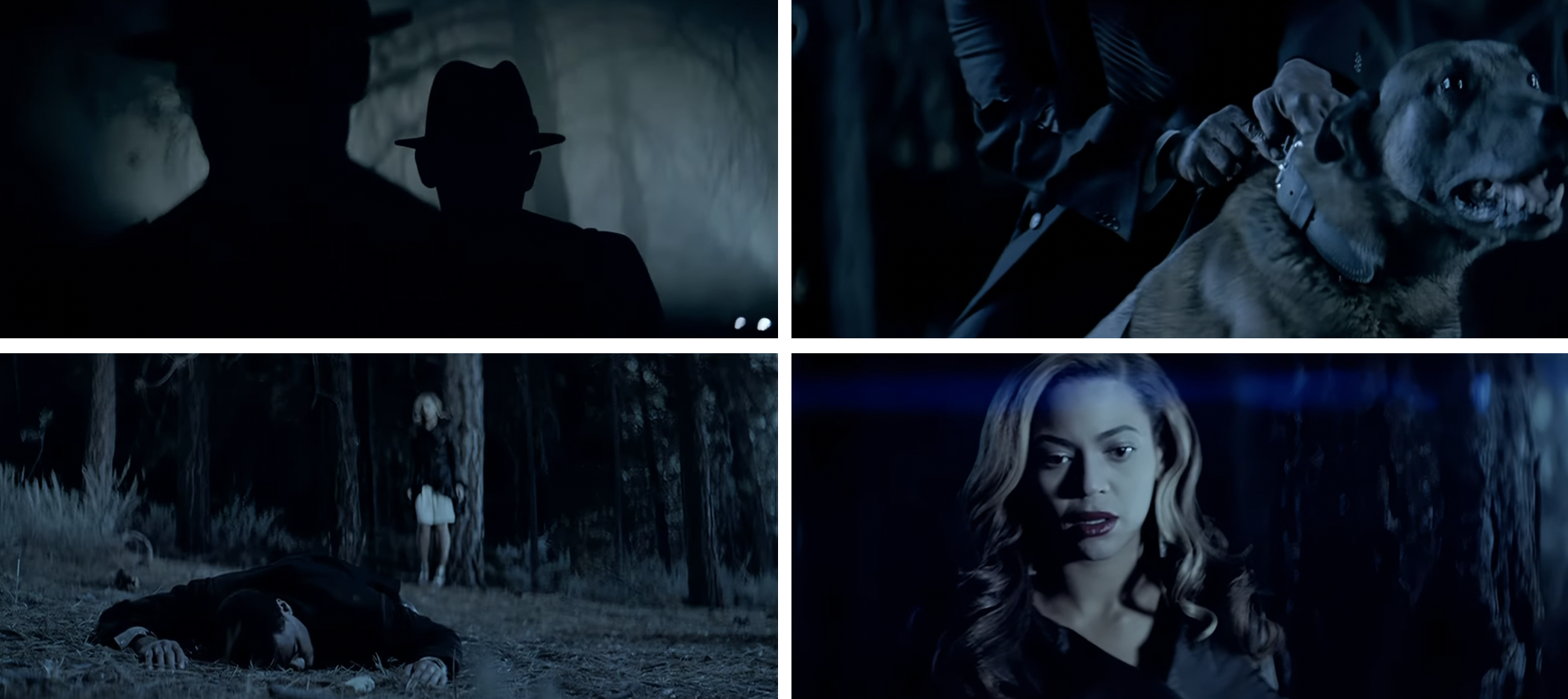
When we get to the segment in Behind the Scenes: The Videos about “Ego,” which Beyoncé co-directed with Gatson—there were multiple versions, including an original, a remix with Kanye West, and one where Beyoncé sits instead of dances—she tells us, “‘Ego’ is where I made my directorial debut.” Though we know that she’d co-directed the new entries in her B’Day anthology in 2007, pop stars who get into directing often do this kind of record-revising and -resetting, for reasons probably case-specific to each one. It’s possible that Beyoncé felt she’d done more work on “Ego” than any of those earlier videos, and it’s also possible that she had newfound reasons to lay directorial claim to this work in 2009; in 2007, she was not yet the same sort of global icon who produced motion pictures, and whose brand seemed to be getting more cinematic with each passing week. (She’ll make another “directorial debut” later in this chapter.)
Interestingly, the last few minutes of the featurette are devoted to something entirely unrelated to I Am… Sasha Fierce: Beyoncé performing during Barack Obama’s inauguration festivities. “I think my biggest payoff in my career was singing for the first African American president,” she narrates while we see footage of her carrying Julez—still little, but bigger than he’d been in the studio while his aunt recorded B’Day (2006)—around Washington, D.C. “This is why I work. This is why I’ve sacrified everything: for these opportunities.”
Though this was a very different example from Walmart Soundcheck, Beyoncé had again found herself excited to commit recent footage to a documentary, but lacking a venue more sensible than a making-of short about the videos from I Am… Sasha Fierce. Girl, just make a feature!
Days after the video album’s release, superstar Michael Jackson died of an overdose of drugs administered by his doctor (who’d later be sentenced to four years in prison). No matter your level of fandom, the world seemed to stop at the loss of the otherworldly, complicated legend. Beyoncé, for her part, was filmed weeping onstage during her tour that summer, the “Halo” segment having partly become a Jackson tribute.
The superstar’s death would still be hanging over pop culture at the VMAs in September, where “Single Ladies” was nominated for nine awards (including all six of the non-fan-voted craft ones). The show began with a longer tribute to him that featured both Madonna and Janet Jackson, beginning things on a dance-y but somber note. The VMAs crew was sure to grab a reaction shot of 28-year-old Beyoncé, one of the most vocal MJ admirers in the business.
From there, it seems to have been constant emotional whiplash for her. The first award of the night was Best Female Video, a fan-voted award that she lost to 19-year-old Taylor Swift for “You Belong With Me” (2009). It was then that a drunk Kanye interrupted Swift’s acceptance speech to declare Beyoncé’s video “one of the best … of all time,” leaving both women crying backstage. Later in the evening, Beyoncé would win Video of the Year (another fan-voted award) for the first of only two times in her entire career, but her speech was donated to Swift so that the rising star could finish her halted one.
Even for a show famous for chaos, the 2009 VMAs were uniquely batshit; that was also the night that Jay-Z saw his “Empire State of Mind” performance crashed by Lil Mama, and that relative newcomer Lady Gaga staged her own bloody demise during a performance of “Paparazzi.”
In the midst of all of this, there was something about the death of MTV icon Jackson that felt like the end of an era, or even like there was a changing of the guard afoot. While Gaga—another devotee of the late superstar—had certainly used the network to her advantage (as she did that evening), she was an artist who made MTV feel somewhat incidental to her rise, becoming best-known for making provocative, profane, sometimes disturbing videos and then simply premiering them online. And funny enough, there was really just one artist who’d spent the year wearing a single glove and performing Fosse-inspired choreography while fans cried and fainted around them, and that was Beyoncé. When she performed “Single Ladies” during the same VMAs, she wasn’t exactly tributing Jackson the way the rest of the room was (though aspects of the live arrangement seemed to nod to him); she’d long ago begun taking his teachings into the future.
With the exception of the Lil Mama thing, each of these bits of chaos—the death of Jackson, Gaga’s “Paparazzi” performance, and even Swift v. West—would have some sort of implication, in their own weird way, for Beyoncé the visual artist. There was something about Jackson’s video-making ethos that she didn’t want to see disappear with him. There was something about Gaga’s freaky-sexy hold over the room that she seemed to want in on. And there was even something about Kanye’s interruption that expedited artistic comparisons between Beyoncé and Taylor Swift.
The next month, Beyoncé was presented with Billboard’s 2009 Woman of the Year honour, thanking her parents in a quick speech before being interviewed onstage by Gayle King. She also crossed paths yet again with Lady Gaga, an idea starting to snowball in her head.
To coincide with this annual Women in Music event, Billboard ran a Q&A with Beyoncé that had been conducted in September, again paying notable attention to her screen career. “All of the work I’ve put into my films has paid off because the type of scripts I’m getting now has completely changed,” she said. “I’ve always wanted to do something darker and more dramatic because I’m much better at drama than anything else. I don’t think anyone knew that until I played Etta James.” She also mentioned how fun she’d found “doing those stunts” on Obsessed, and reminded readers of her interest in something more action-heavy.
But she then took things a step further, adding:
I also want to continue to produce films—even if I’m not in them—as well as a documentary on my life. Actually, I’d like to do a film loosely based on my father’s childhood and school years. He’s had an interesting life. But that will probably be in a couple of years.
The star had finally arrived at the idea of an autobiographical feature, thank God. But we’ll put that aside for a second, since it’s the other revelation that fascinates in hindsight.
Beyoncé’s instincts as a producer here were pretty bang-on, however challenging a film about her father’s early life would have been to see through. Born in 1952 in segregated Alabama, Mathew’s childhood was spent avoiding run-ins with the Ku Klux Klan and facing constant violence and dehumanization as he helped integrate various all-white schools. (Years later, he’d publish a memoir about all of this called Racism from the Eyes of a Child [2017].)
But the very same day that Billboard ran the Q&A—that Beyoncé had stood onstage thanking her parents for helping her build this spectacular career—TMZ reported that Mathew had been served with a paternity suit by a woman named Alexsandra Wright. In J. Randy Taraborrelli’s fascinating but flawed biography, Becoming Beyoncé (2015), in which Wright is quoted extensively, she claims that Mathew was actually handed the papers at the Billboard event.
On Halloween, Channel 4 in the UK aired a special called Beyoncé: For the Record (2009), another interview from September where Steve Jones had flown to Australia for a sit-down with the star. The director of the special was Tim Van Someren, an accomplished player in the live space, so it wasn’t exactly a project released by Beyoncé HQ. As with Walmart Soundcheck, however, much of it rests on her own documentary footage, and Burke is credited as “Additional Concert Footage Videographer.” (Other future members of the Parkwood team also appear in the credits.)
The main reason I mention the special, though, is the heightened focus on filmmaking; as with the Vogue cover story and Billboard Q&A, that’s one of the main things Beyoncé seemed to want to talk to journalists about in 2009. For instance, Jones asks the star whether she ever feels like she lost an element of her childhood doing all that work. “There were certain moments,” she admits. “I didn’t have as many friends. But thank God I started making movies and being around the same people for six months at a time, and I was able to still experience some type of… that was like my college.”
Eventually, she says:
I directed a music video and I’ve always been really involved with the production on my shows. I love all of that stuff. So I would love to eventually … direct music videos, and eventually direct maybe some films. I want to do a documentary soon. And I’d like to maybe start my own label, and start looking for other talent … I don’t know if I want to manage. But if anything, I am a really good teacher and I know a lot of things about performing, and I would love to just help new artists and young artists.
Beyoncé had again undersold the work she’d already done on the production side of things. Aside from the fact that she’d directed more videos than just “Ego,” she was truthfully weeks away from releasing her first self-directed documentary short. So what’s interesting about this quote is not just Beyoncé’s big directing plans for the future; it’s that she’d actually been directing behind the scenes, but was now starting to actively weave that into her public image.
What also makes the quote interesting, of course, is that it was delivered in late 2009—a full year and a half before the star would officially lift the kickstand on Parkwood Entertainment. “I’m still my father’s baby girl,” she explains in the chat:
I’m a very strong businesswoman. And when it comes to my art and it comes to my shows, I know every little detail and I’m very much in control. And I think, you know, it took a couple of years for my father to understand that … It’s something that we still struggle with at times.
It seems, then, that Beyoncé was conceptualizing what later became her own company long before her existing management started to create certain PR headaches for her. The Billboard event hadn’t even happened at the time of her sit-down with Jones, but here she was publicly planting seeds that her current arrangement had some room for improvement.
A more fun development of the Billboard event was that Beyoncé had decided she wanted to collaborate somehow with Lady Gaga. In September, she’d released the eighth single from I Am… Sasha Fierce, “Video Phone,” but subsequently recalled it so that it could be turned into a remix featuring her new friend.
In “Video Phone,” Sasha Fierce (subtextually) offers to live as spank-bank material in a suitor’s cellular device. Immortalizing someone onscreen is apparently her love language, and the feminist twist is that she wants footage of him, too. “You should let me put you in my movies,” she sings in the second verse, promising to “turn [him] into a star.”
The remix largely replaces this verse with a new one from Gaga, dialling up the sense of capital-C Cinema:
Hubba, hubba
Honey, baby is so sexy that he should win an Oscar
And when you miss me
Just remember that I always got you with me
I’ll be your Gene, you’ll be my Brando
I’ma put you in my movie if you think that you can handle
Gaga was another artist with a unique relationship to the film world, one that deserves its own long-form project. But for about half a year beginning with “Video Phone,” she and Beyoncé maximized their joint slay as cinephilic pop stars. Aside from the new verse, the remix begins with 50 seconds of totally new audio, teasing the original’s crunk beat but mixing it with what sounds like the score for a spaghetti Western.
In the Hype Williams-directed video for the remix, Beyoncé spends these seconds imagining Sasha Fierce as a de facto Quentin Tarantino character, recreating the opening of Reservoir Dogs (1992) with a group of men. The rest of the video is mostly her being evil-hot in various looks and set-ups, wielding cartoony weapons and even appearing to have some hostages. Gaga shows up about halfway through for her verse and a dance, doing her best with Beyoncé-tailored choreography that she’d learned the day prior.
“That’s what’s fun, though,” Gaga says in the official making-of segment, cracking up while watching back footage: “We can trade.”
And so we arrive at another Thanksgiving—which, as a reminder from the previous chapter, Beyoncé reliably took as an opening to release a long-form visual project for years.
True to masochistic form, she’d chosen to use a two-week break that she and her team had in the summer—just after the North American leg of her tour, but before it moved over to Japan—to perform an entirely different show: I Am… Yours, a jazzy four-night residency at Wynn Las Vegas. In the end, those performances wrought two different films, which Beyoncé combined into a single special for ABC. (They came separately on the DVD that followed.)
The first was the concert film of the residency, I Am… Yours: An Intimate Performance at Wynn Las Vegas (2009), directed by Nick Wickham of The Beyoncé Experience Live (2007). The star spends the first half of the show singing Vegas-y takes on her catalogue, mostly I Am… Sasha Fierce, and even doing some scatting. She then uses the second half to tell a song-and-dance version of her career story, from auditioning for her first record deal (“I Wanna Be Where You Are”) to recording B’Day in the aftermath of Dreamgirls (“Get Me Bodied”).
I Am… Yours is an underrated concert film of Beyoncé’s, evidence of her strikingness as a performer even without the usual bells and whistles, and a prime example of how she’s often breathed new life into her discography through inspired live-arranging. The bulk of the focus is kept on the music and perhaps lighting, with only the storytime half choreographed in the traditional sense. Included in that is what appears to be a new Bob Fosse reference, this time to the chair staging of the “Mein Herr” scene from Cabaret (1972). (She’d been doing something similar all year on the I Am… World Tour.)
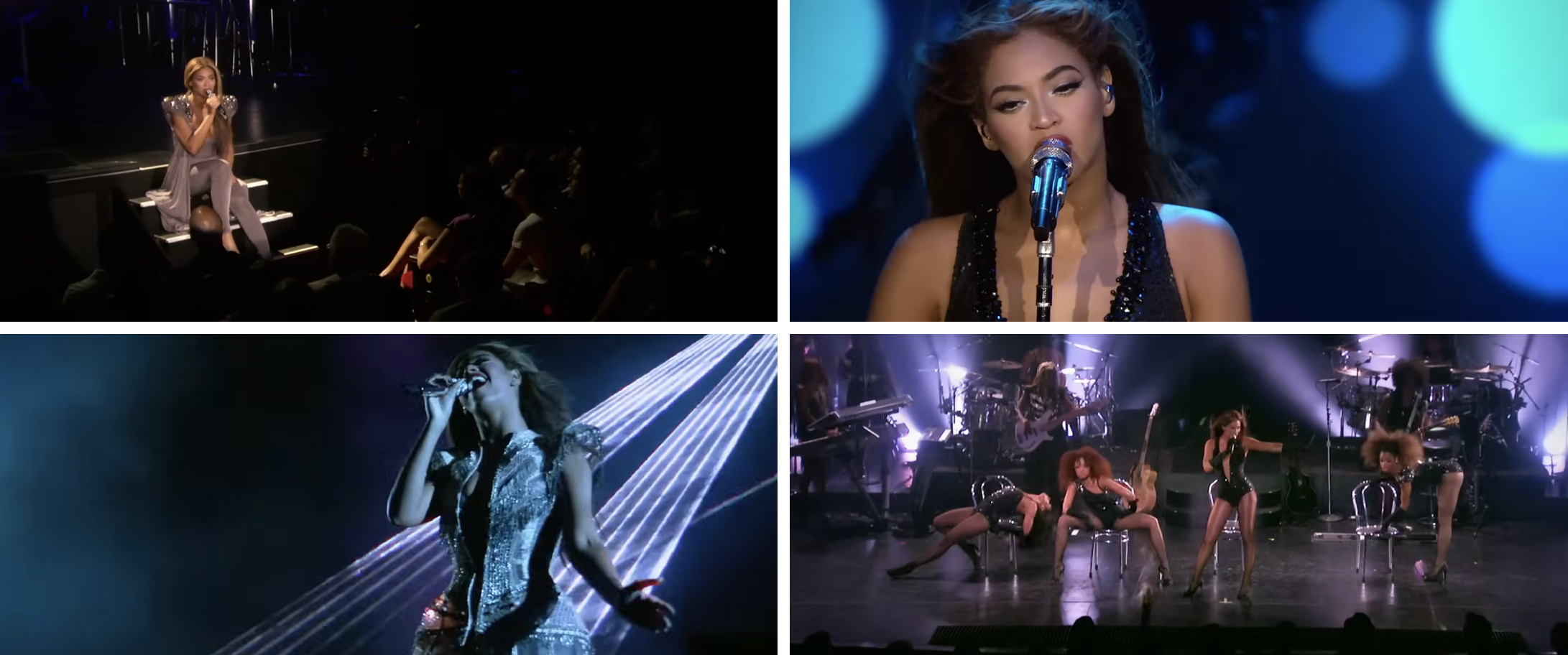
The film is also an excellent showcase of Beyoncé in mythmaking mode, since she literally narrativizes her career. Along the way, she embellishes and she omits: Austin Powers in Goldmember (2002) becomes her first movie; her label is nervous about the hit potential of Dangerously in Love (2003) not because “Work It Out” flopped in the US but because they’re going out of their way to doubt her; and the story conveniently ends three years early, which means that she doesn’t have to include her wedding.
“One day, I woke up and said, ‘I got it. I’m gonna tell my story,’” she explains in the second project included on the DVD, a documentary called What Happens in Vegas (2009). The 25-minute film was co-directed by Beyoncé and Ed Burke, marking the first non-music video project on which Beyoncé ever had a directorial credit. We see how her team is using their soundchecks on the I Am… World Tour to put a whole other show together, and we feel everyone’s stress as opening night approaches and it isn’t ready to have an audience.
While previous documentaries had given us glimpses of tension between the star and, say, the VMAs crew, this was the clearest look we’d gotten of her being exacting and even annoyed with her own team. We’ll be coming back to that a little later, but for now: there was an uptick in what you might call Shadiest/Diva Moments as Beyoncé began directing her own making-of content. In a film career that’s been defined by careful brand management and sometimes caginess about her personal life, her industriousness and authorship have instead always been played up. She could insist to however many interviewers she wanted that she was the main driver of her career—as she’d noticeably started doing around B’Day—but it was another thing to have hard evidence.
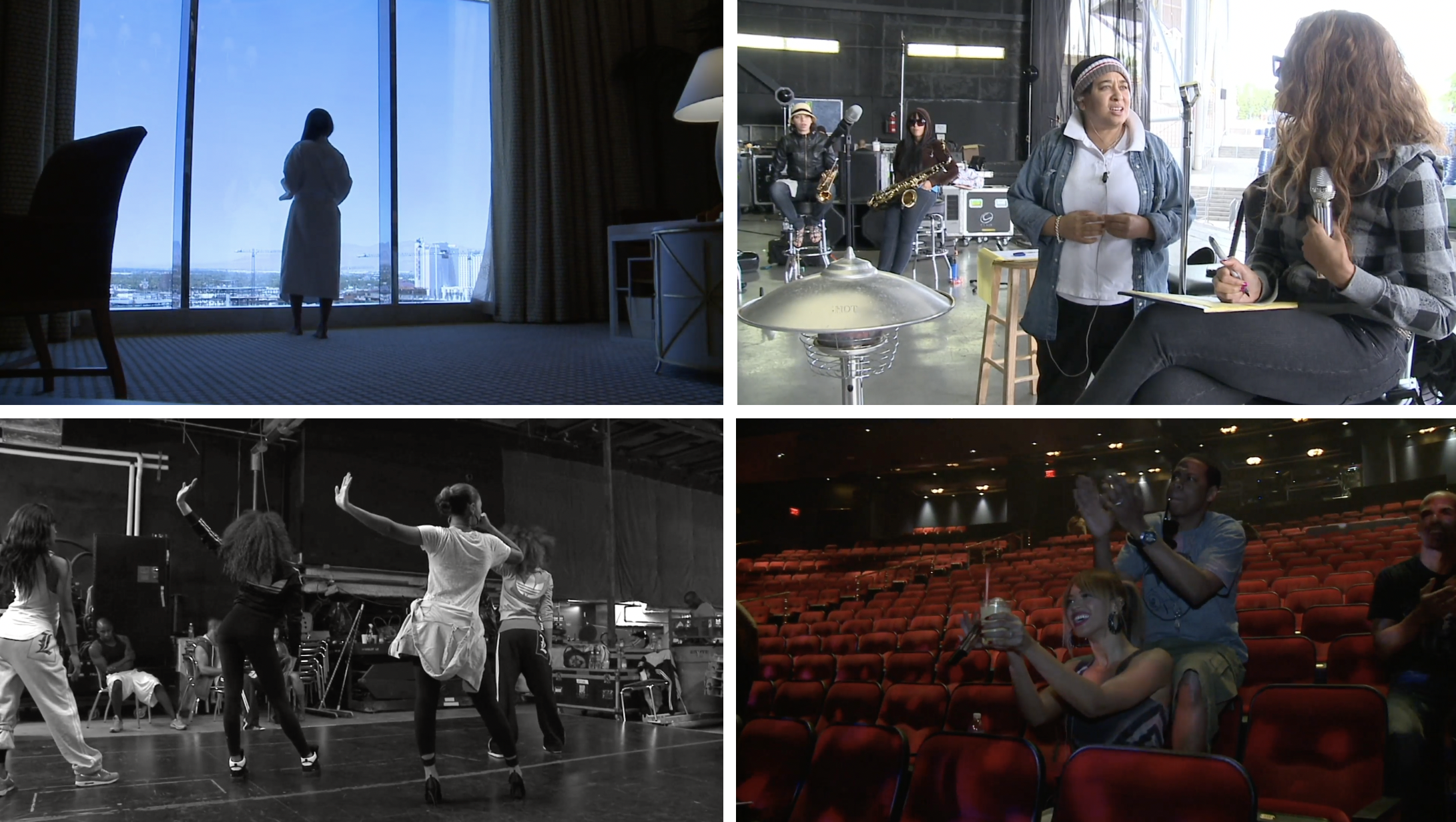
Despite anything that may have been happening with the Knowleses, the film wisely includes a quick cameo from Mathew as he checks in on rehearsals back in August. At the same time, the appearance is so brief that he can’t realistically be playing any kind of creative role in this show. So at least as far as his daughter was representing him onscreen, he’d become ancillary to her whole operation.
Before 2009 came to a close, the women of the Knowles family filed two important documents. Ms. Tina filed for divorce. Beyoncé filed for the trademark for Parkwood Pictures.
In the new year, the star announced that she’d be taking a bit of a work break after the Grammys in January and conclusion of the I Am… World Tour in March. She’d wind up cancelling her final two shows without explanation, ending things a whole month earlier, and wouldn’t even wait that long to figuratively murder Sasha Fierce: “I have used this person to take over when I’m too scared or too shy. The thing that’s interesting is I don’t need Sasha Fierce anymore, because I’ve grown, and I’m now able to merge the two. I want people to see me.”
Officially, this hiatus was being prompted by burnout, both physical and spiritual. “I’ve always worked hard, but I feel like I worked harder this past year than I have since I was just starting out,” Beyoncé said. And in fairness to her, she’d already spent two years of her life with I Am… Sasha Fierce. Unofficially, of course, there was everything going on with her family. We’d also learn in time that she and her husband experienced the first of multiple pregnancy losses somewhere around here. She clearly just needed a little R&R.
Among Beyoncé’s efforts to nicely set up her hiatus, she was interviewed by Steve Kroft for a 60 Minutes segment that aired the same day as the Grammys—where, in addition to being the most-nominated artist of the evening, she set a new record for the most wins by a woman in a single ceremony (six). As far as we’re concerned, the segment is interesting for two reasons.
First, it stresses that it was Beyoncé who ran her world. “While her career is still managed by her father, Beyoncé is the steam that drives the engine of this huge enterprise,” Kroft narrates. When we see footage of her wiping out in rehearsals for “Single Ladies,” he continues:
This rehearsal was shot by her private videographer, who records many of her offstage activities for documentaries and DVDs. She is very much the custodian of her own image, and this allows her to guard her privacy, keep outside camera crews and paparazzi at a distance, and control content for her own commercial use.
In addition to this quote actually acknowledging the existence of Ed Burke, a figure so low-key that most fans wouldn’t be able to pick him out of a lineup, it connects a few dots that it would take most people many more years to: that the videographer’s hiring led to self-produced movies, and self-produced movies led to control.
The second interesting thing is how the interview credits this desire for control in part to Barbra Streisand. Kroft himself argues off the top that Beyoncé is “well on her way to becoming the Judy Garland or Barbra Streisand of her generation,” quite the compliment for a star who grew up admiring both women. (We’ll get into Garland later.) But Beyoncé again indicates that Streisand—“another singer-turned-actress and director,” as Kroft says—was someone whose career she was openly modelling her own after. “I know that she does everything, and I know that it’s all Barbra Streisand,” she explains. “It’s not someone that’s telling her what to do, what to wear, what to sing. It’s her, and I respect those [types] of artists.”
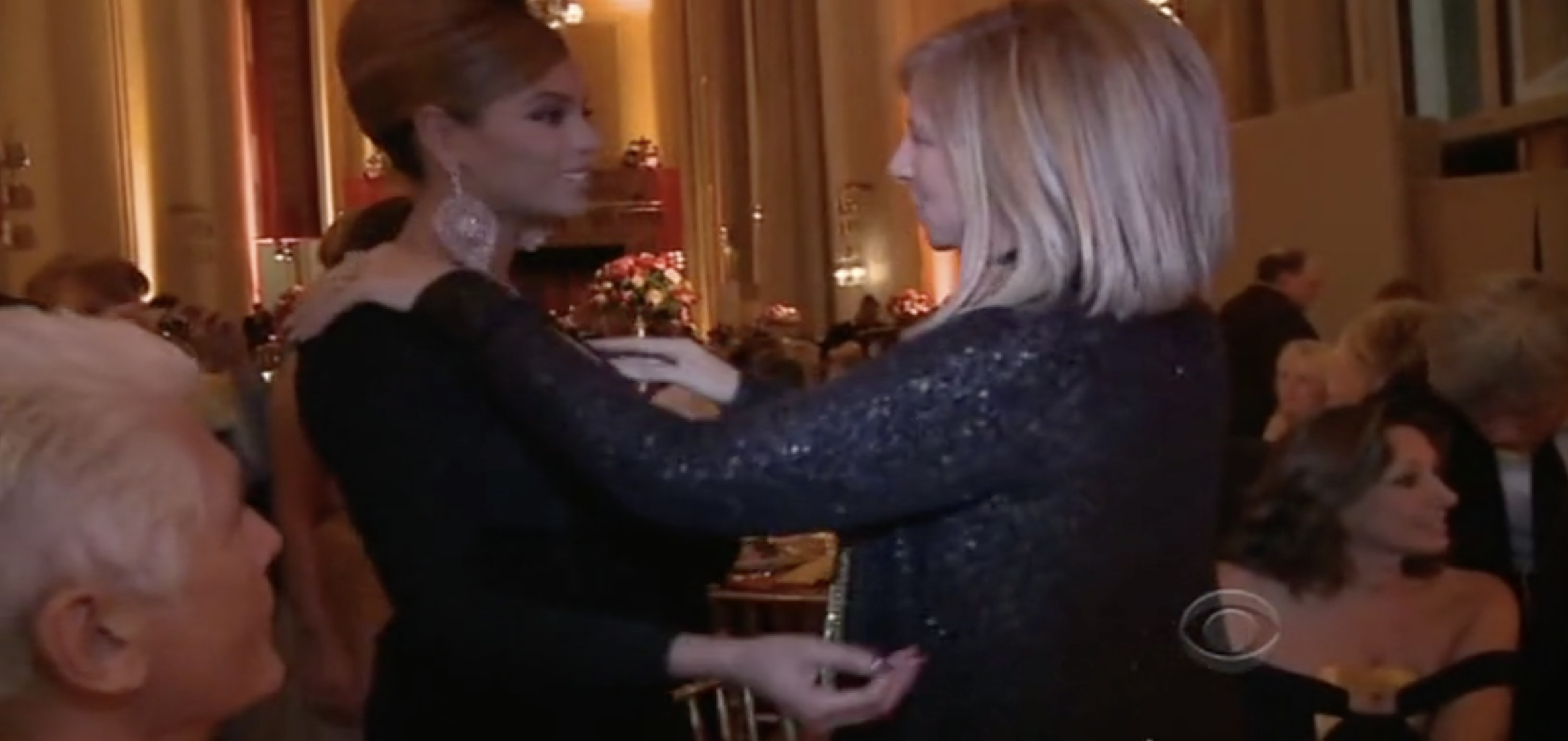
Streisand is a performer known for various projects, including films, where she proudly wore many hats; Yentl (1983), for instance, was co-written, produced, acted, directed, and soundtracked by Babs herself. Beyoncé, someone who’d later release enough projects in such a vein that she now jokes about it in her merchandise, clearly found this sort of thing aspirational rather than vain. As Kayleigh Donaldson recently wrote in an essay on Streisand’s directing, “[Her] work as a filmmaker is still frequently dismissed as a mere vanity project. Her music remains at the forefront of what fans love and expect from her, even as she has insisted for decades that she is more an actor and storyteller than a singer.” Though it would probably be wrong to call Beyoncé’s future self-directed films similar to Streisand’s, they too would sometimes be criticized as vanity projects.
Even without the tour, Beyoncé had several commitments to follow through on before she could officially clock out. One was opening an eponymous cosmetology training program at the Phoenix House in Brooklyn where she’d done Cadillac Records research. Another was filming the ten-minute video for “Telephone” (2010), the other half of the “trade” she’d made with Lady Gaga in the fall—this collaboration having appeared on Gaga’s The Fame Monster (2009).
“Telephone” was only really linked to “Video Phone” by its Tarantino references and Beyoncé’s Bettie Page wig. It was more obviously the sequel to “Paparazzi” (2009), a similarly long video that had ended with Gaga murdering her boyfriend and then calling the cops on herself so that she could be perp-walked in her choice of couture. “Paparazzi” had been Gaga’s first time working with Jonas Åkerlund, a director who’d appeared on the MTV scene around the same time as Beyoncé, quickly becoming a go-to collaborator of Madonna’s due to their shared knack for button-pushing.
Åkerlund was called back for “Telephone,” where Beyoncé (playing a character named Honey B) picks Gaga up from prison so that they can mass-murder a diner full of people. The iconography here drew vaguely from Tarantino’s work as well as Ridley Scott’s Thelma & Louise (1991), at one point recreating the shot where the titular women clasp hands before driving off together. (In an important twist, though, the video ends on a literal “To be continued…” note rather than having them die.)
Over lunch with Gaga, Tarantino himself had lent her and Beyoncé the Pussy Wagon from his Kill Bill films—making the video feel more like a tribute proper, but also saving them from having to use a convertible hearse.
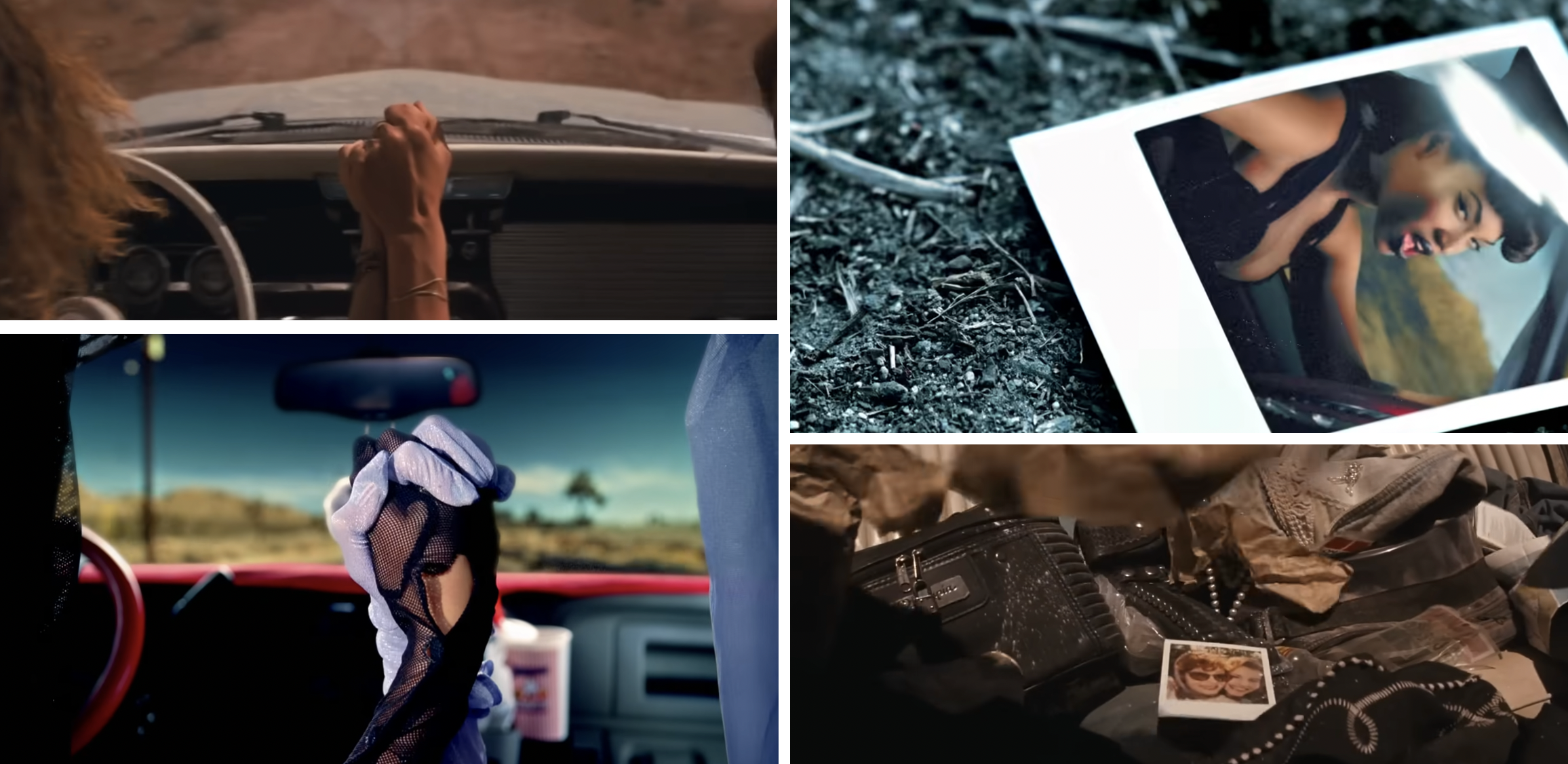
“When I put on the Bettie Page wig, I got into the character,” Beyoncé would say. “I started researching Bettie Page and tried to channel her pinups and poses.” Though best known as a model, Page also appeared in a number of films throughout her career, mostly of the sexploitation variety and for director Irving Klaw.
By all accounts, Beyoncé did not have much creative involvement in the “Telephone” video relative to Gaga; she seems to have tackled her scenes at lightning speed that January, and has only sparingly acknowledged the collaboration since. Which is not to suggest that she didn’t realize she was participating in a project defined by its queer subtext and potential nods to prison porn, just that it could all be blamed on the corrupting influence of Gaga if necessary.
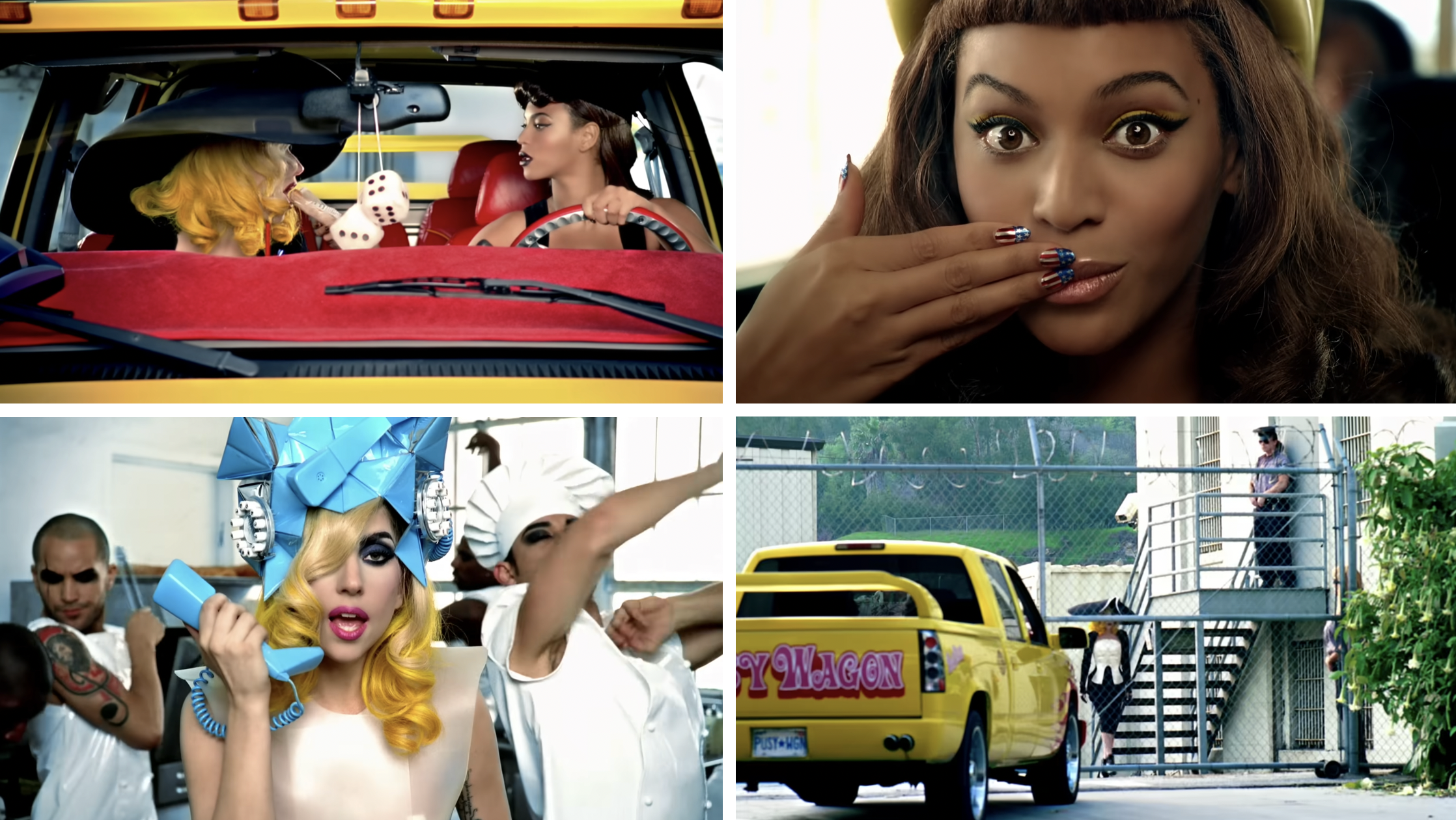
There was a sense that the straight-A student had befriended the new girl who liked to smoke up behind the bleachers, and the video itself had some fun with that: Beyoncé is the designated driver who scolds Gaga—the one who does all the poisoning and stranger-kissing—for being a “very, very, bad, bad girl,” and while both characters utter the word “motherfucker,” it’s only Beyoncé whose swearing is bleeped out (and who coyly covers her mouth afterwards).
“It was sort of a pop-art venture for me to bring her into my world,” Gaga would say. “It was something for me to kind of change the way that you see her for one video.” One clue as to how much Beyoncé enjoyed that experience is the number of times she’s hired Åkerlund since—but more on that in the next chapter.
On the fourth (!) of February, Alexsandra Wright gave birth to a baby boy, whom she named Nixon. Two weeks after the “Telephone” video premiered in March, TMZ reported that a DNA test confirmed Nixon was indeed Beyoncé’s half-brother.
Various sources, including a piece she’d write for Essence, have painted a picture of what the star got up to on her quote-unquote year off—consuming art of all kinds, being an aunt, visiting cities she’d only experienced out of the windows of cars and hotels. She spent more than a month just in Australia, eventually remembering:
It was a carefree existence for me. Next on my personal world tour was Japan, where it was my idea to go unrecognized as a Harajuku girl … to a couple of Tokyo clubs. In London I met Sade … In Paris my nephew Julez and I had escargot for lunch and it was actually tasty (though not as good as a funnel cake at the Houston Rodeo).
“In the end, my year off was more like nine months,” she’d admit, but even that might be a stretch given how much work she did in 2010; she was on the Coachella stage in the spring, giving interviews in the summer, and making surprise TV appearances in the fall. We’d later learn that she’d started recording new music as early as May, the same month that she released a video for “Why Don’t You Love Me” (2010), a bonus track from I Am… Sasha Fierce.
“Why Don’t You Love Me” was a relatively bare-bones affair where Beyoncé—co-directing with Melina Matsoukas, by this point a friend as much as a collaborator—poked some fun at the idea that she was supposedly taking time away to be a domestic goddess. Playing another new character called B.B. Homemaker, the video portrays her as a sexy but ditzy housewife, overwatering the plants and burning the roast. “I was still thinking about Bettie Page, and wanted to do something that was inspired by her,” she’d explain:
The video was a secret: I paid for and codirected it and didn’t tell my label or my management. The clothes and jewelry are from my closet, the wigs are mine, and I did my own makeup. We did eight looks in one day in this great house that belonged to a producer who worked with Dorothy Dandridge. He had pictures of her on the wall, so her spirit is in the video, too. I wanted Super 8 film and wanted to get those saturated colors. It’s a different drama—the tears and martinis and cigarettes. I wanted to channel the past for the present.
What Beyoncé doesn’t say here is that the video directly recreates several moments from Page’s sexploitation film work, including some of the shorter-form fetish stuff she and Irving Klaw used to make based on client commissions. (Here’s a handy edit.)
From the sexual overtones to the fact that the star had again loudly orchestrated a project behind her father’s back—the difference now being that the world was also seeing the headlines about his off-duty antics—something was clearly shifting at Beyoncé HQ. But I’d argue that “Why Don’t You Love Me” was also a signal moment for anyone following her evolution as a visual artist. Not only was she a year and a half removed from the release of I Am… Sasha Fierce, but she was also supposed to be on vacation; this was something she’d done purely for love of her craft, apparently needing little else but a buddy and some equipment to pull it off. And the implications of that were legion.
That Beyoncé struggled to take a vacation in 2010 came back to more than just willpower. Mathew’s own court filings would later reveal that in October, a law firm conducted an audit of him on his daughter’s orders. Apparently, Live Nation had told her that he’d “stolen money from Beyoncé on her most recent tour or otherwise taken funds that [he] was not entitled to.”
The next month, Beyoncé announced a new concert film called I Am… World Tour (2010), which she’d co-directed alongside Ed Burke and Frank Gatson—the first feature-length collaboration between Beyoncé and Burke as a directing duo, and the star’s first directorial credit on a feature, period. The press release noted that the film was being co-released, as usual, by Mathew’s Music World Entertainment. At the same time, it emphasized having been “produced, directed and edited by Beyoncé for her own Parkwood Pictures.”
In case “edited by” raises any brows, that messaging has remained consistent for a decade and a half; Beyoncé is credited as an editor on the film alongside Burke and Frederic T. Brehm. “I was very interested in filmmaking,” she recalled of this time in her life in 2021. “I learned how to edit the cut myself in Final Cut Pro, and it was the beginning of a newfound love and creative expression.” When a version of the film aired on ABC over—you guessed it—Thanksgiving in 2010, there was footage of her glam squad attempting to doll her up while she worked in the edit bay.
I Am… World Tour would be the final feature to come out of Parkwood under the name Parkwood Pictures, but it was arguably the start of many more things. The concert film cuts together multiple shows from the tour, actually labelling certain shots with their location and show number. As the New York Times wrote in its review of the special, half of which was turned over to Taylor Swift also having a Thanksgiving special: “The documentary quietly flaunted her consistency as a trouper in montages that segued multiple shows—supertitled in small type—with Beyoncé in the same outfit making the same moves, while the fans’ nationalities changed around her.” It was as if you took the “Man in the Mirror” opening of Michael Jackson’s Moonwalker (1988), a film I’ve mentioned previously, and stretched it out for an hour and a half.
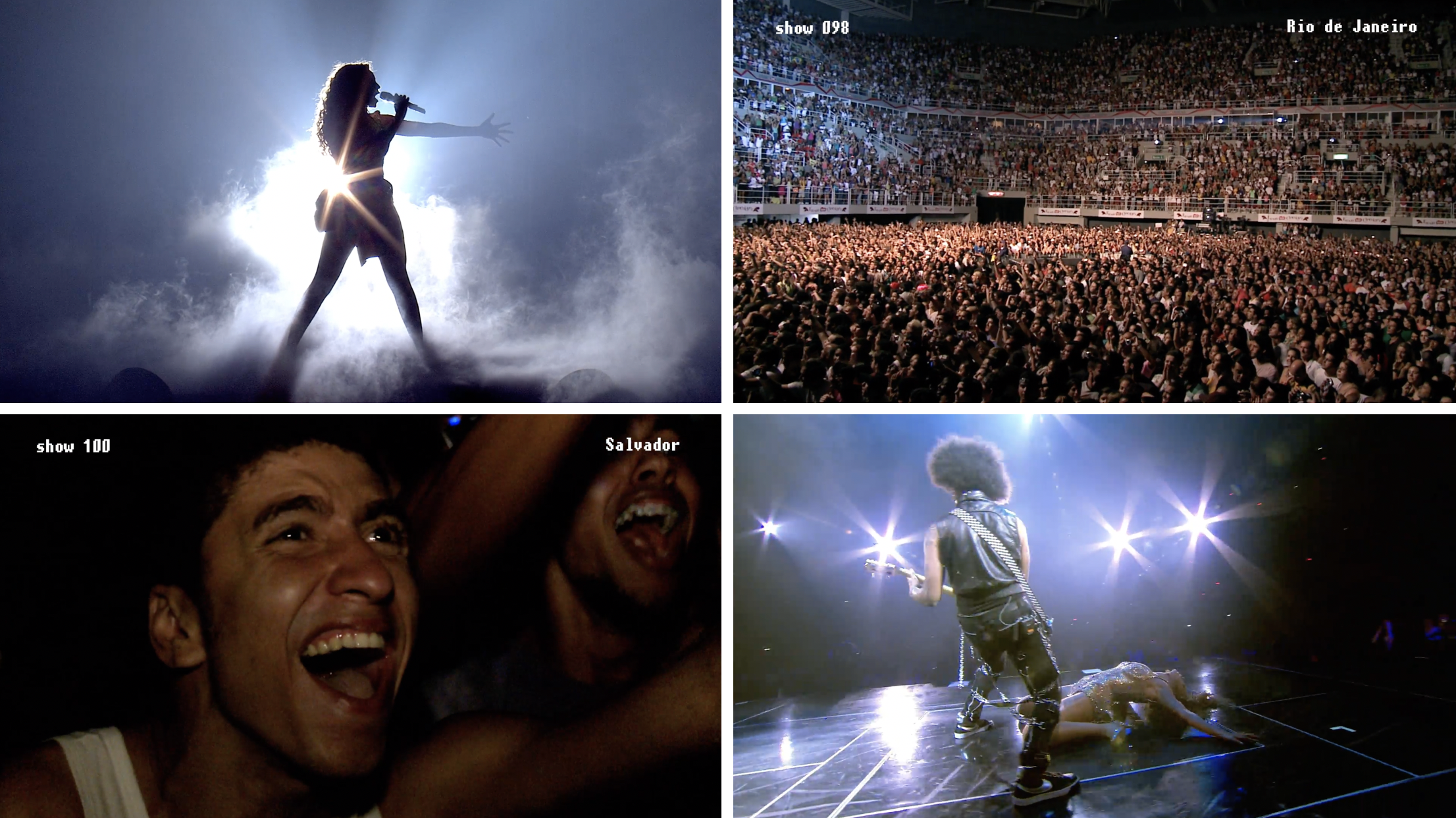
“This is my directorial debut,” Beyoncé told Extra at the premiere, which was true if we’re talking features. “The directing was really in the edit; it took me nine months to edit because I wanted to show a little bit of each show.” In other words, the star was perhaps the worst vacationer of all time.
If there’s a select group of popular musicians who’ve directed feature films, the group who’ve self-directed concert films (to say nothing of directing multiple) is considerably smaller. But the choice was at least partly explained by the wealth of personal footage woven throughout I Am… World Tour, much of it shot—in Beyoncé’s words—“in my little Mac computer, the same computer everyone iChats in.” Indeed, the film suggested that the “Why did God give me this life?” monologue we discussed last time, seemingly delivered on her 26th birthday in 2007, was just one of many vlogs that existed on her hard drive. There’s so much of this kind of material in the film that the star, alongside Burke, is credited as having provided “Additional Photography.”
Ten minutes into the show, we’re suddenly pulled out of the arena and into the star’s bed in New York City, where she’s recording a video diary dated March 25, 2009—the day before the tour began. “I’m in my favourite place in the world right now, which is my home,” she says, seemingly wearing nothing but a duvet. “Tomorrow, I am Sasha Fierce, and it’s no turning back. But I think I’m gonna be gone so long, it might be wise to start being Sasha Fierce”—and here, she flashes a mischievous look at us—“tonight.” Once again, there was a feeling in 2010 that her star persona was growing up a little. (We move from here right into “Freakum Dress.”)
While promoting the film, Beyoncé shared a story about feeling lonely one day in her hotel room in China, explaining, “I wanted to talk to someone so I opened up my computer and I just talked.” But the moment of her at home in bed indicated that she didn’t have to be starved for companionship to record this kind of thing; maybe, just maybe, she was already thinking ahead to the film she’d make a year and a half later. Either way, it’s understandable that she wanted final cut over material so intimate. “It’s a lot of things I reveal about myself that I could never give to [another] director,” she said, saying elsewhere, “I would never have gotten so open if someone else was in the room.”
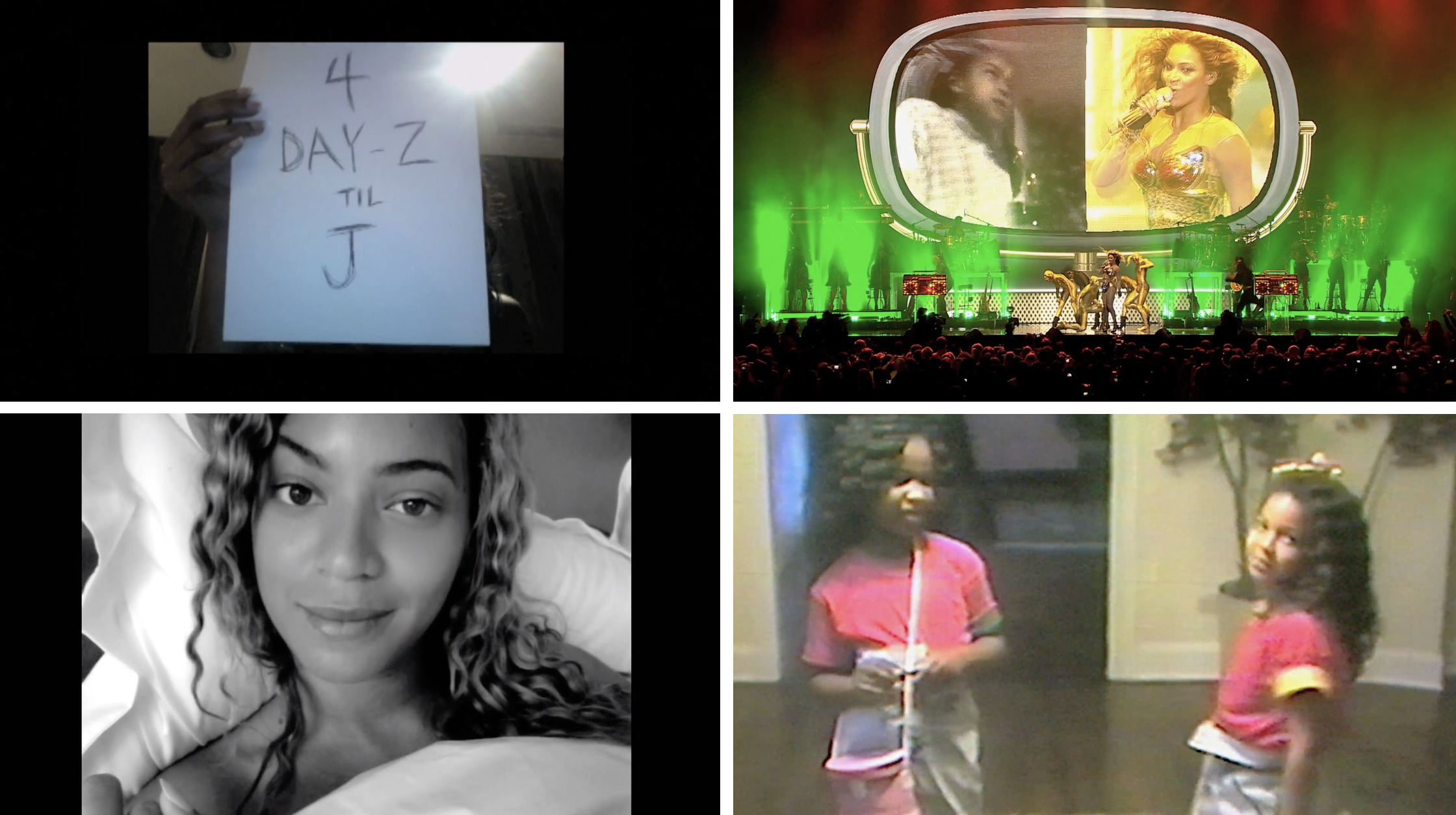
Unlike any concert film Beyoncé had made previously, this one relied heavily on doc footage of all kinds, and that was at least partly because doc footage had been built into the stage show in interesting ways—taking things up several notches from what we’d seen in The Beyoncé Experience Live. Towards the end of “Halo,” just before Beyoncé begins addressing the song to the late Michael Jackson, a home video of her heading out the door for a concert of his (the same one that had appeared in Beyoncé: The Ultimate Performer [2006]) plays behind her. During “Radio,” half of the jumbotron is occupied by a similarly tiny Beyoncé getting her groove on so that the 20-something star can dance with her childhood self.
But we’re more generally removed from the show all the time for quick doc stretches. During “Ego,” we spend a lot of the song not onstage with Beyoncé but in dance rehearsals for the tour. As “Halo” wraps up, the film gives us the group prayer from the July 13, 2009 show at the Staples Center—where Jackson had been rehearsing in the hours before he died, and where his memorial service had taken place days prior.
When it comes to this non-show material, a lot of fun was clearly had in the editing room. “I think because I don’t really know that much about the technical aspect, I took a lot of risks in the edit,” Beyoncé said. The film will give us a shot of Solange sitting in the audience at her sister’s show, and then we’ll cut to footage of baby Solange in a home video. There’s also a segment where the star is swarmed by people as she tries to go shopping in France, telling Burke’s camera, “[It’s] kind of like being in a fishbowl. And sometimes it feels like I have to walk with a permanent smile on my face because if I’m just normal and I just look around, then somebody might mistake me for a mean person.” Across the room, a self-described superfan then tells Burke that she’s a “bitch” for not looking at him in the Prada store. “She probably didn’t hear, she probably didn—” we hear the videographer start to respond before he’s interrupted: “She’s probably a bitch.”
It’s not immediately obvious why this moment has been included, and we go back to the show for “Broken-Hearted Girl.” But it turns out that the production team spotted this same superfan getting his life in the front row (perhaps after placing him there as a consolation), and the scene revels in the irony.
Not unusually, there’s also a splash of narrative tinkering in I Am… World Tour. During “Smash Into You,” we get a montage of the star counting down the days until she’s reunited with Jay-Z, making little videos on her laptop. A knowing viewer, however, will recognize that most (if not all) of this segment comes from the Beyoncé Experience in 2007, not the I Am… World Tour in 2009. She also reuses the “Why did God give me this life?” speech, but removes the beginning of it that grounds us in her 26th birthday.
There’s another interesting moment where she seems to blow off a bit of steam about her management. In the tour interlude that kicked off “Diva,” a career-highlight track where Beyoncé boasts about her hustle, Sasha Fierce had removed the mask of her robot suit to let a tear fall, complicating the song’s gloriously mercenary feel. For the film, the star overlays this interlude with one of the video diaries she recorded while on tour.
“I have been having a hard time sleeping,” she says, expressing frustration that she had to go into the studio on her day off. “It’s gonna be … almost nine days without resting my voice and my body and my mind. And I’m just really upset that I don’t have anyone that’s concerned about my body and my well-being.” Beyoncé had begun 2010 with an announcement that she needed a break after a year of overwork, and now there was an indication that this overwork wasn’t entirely of her own volition.
Just as fascinating is how Beyoncé presents some of her movie music. “This next song is from a film I did called Dreamgirls,” she says before we hear “Listen,” footage of Deena Jones playing behind her. “At Last,” on the other hand, has been fully removed from its Cadillac Records context. Initially, Beyoncé’s performance of the song is turned black-and-white to match a montage we’re given of the March on Washington in 1963. As it wraps up, the image then changes to colour as we jump to Obama’s inauguration; “At Last” was thus made not about Etta James but, perhaps, what James’s success represented in Beyoncé’s eyes. The 1963 footage is some of the first she ever wove into a film that didn’t involve her directly, and she also leaves herself out of the inauguration footage despite having been there. She wasn’t the point.
Before we move on, I’ll just quickly draw attention to how the three directors appear in the credits of I Am… World Tour. First comes a title card reading, “Directed by Beyoncé Knowles.” Second, there’s “Director Ed Burke.” And third: “Director Frank Gatson Jr.” Multiple names had presumably been credited to not only reflect the variety of footage but to give credit where it was due; at the same time, Beyoncé had been marked as the top dog here. It’s an atypical approach in the film world, but it’s one that she’d keep up with her features indefinitely.
“It was hard work,” the star said while promoting the film. “I have a new respect for directors and I think I would like to do more of it.”
Despite all the doc footage included in I Am… World Tour, the DVD still came with a separate short called Mic and a Light (2010), which Beyoncé had again co-directed with Burke.
This 23-minute film begins not unlike the more recent Renaissance: A Film by Beyoncé (2023), with the star emphasizing how big a production the show is, and how many different puzzle pieces have to be fit together in order to make it work—in the case of the I Am… World Tour, over and over, across six continents, for a year straight.
We then dive into some of those puzzle pieces, from the arranging of the music, to the filming of the video content, to the designing of the costumes with Thierry Mugler. But the film gets its title from a moment towards the end where Beyoncé suggests that these things are optional for her in order to put on a good show. “All I need is a mic… and a light,” she jokes, in that tone where you know she’s dead serious.
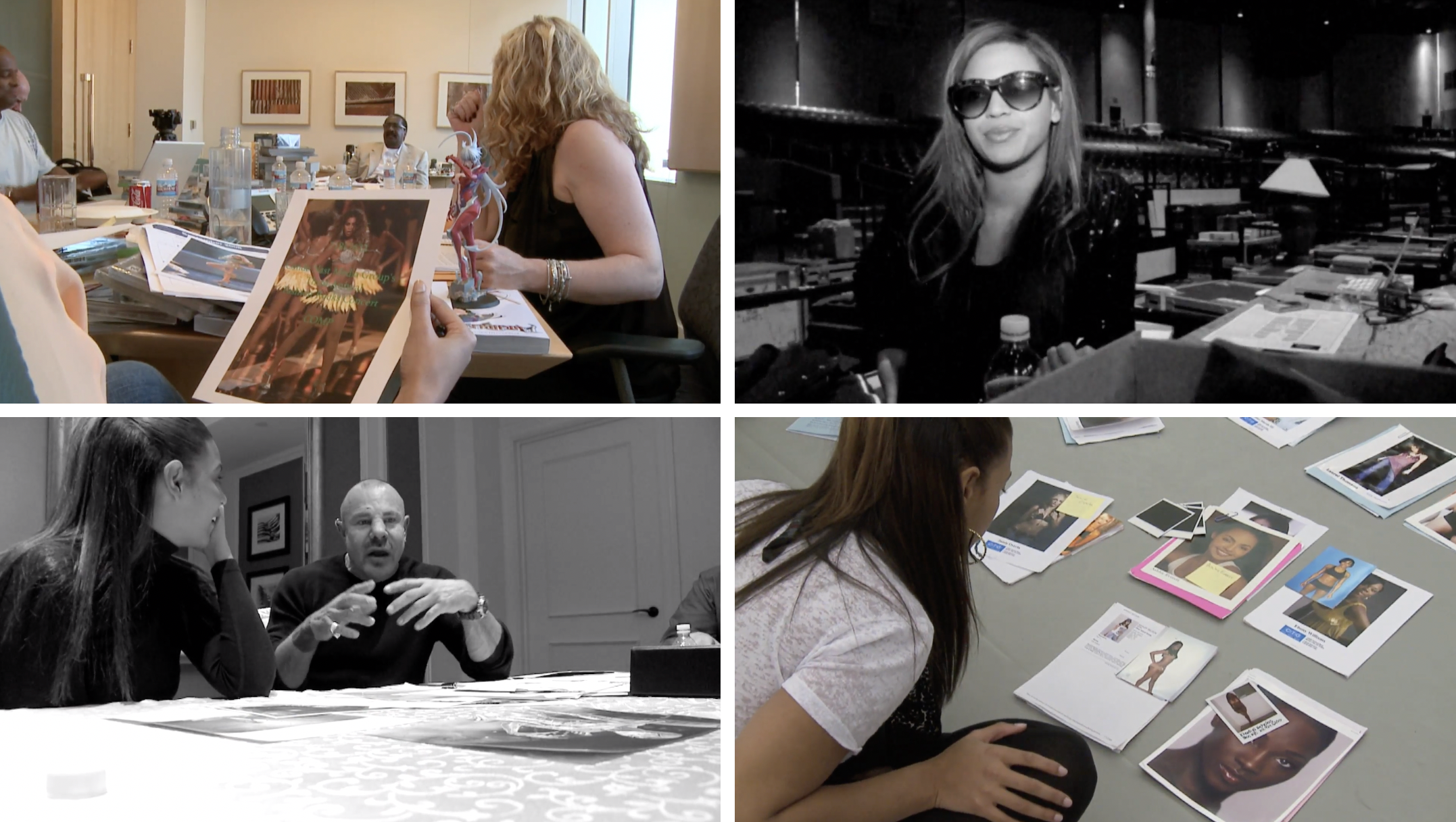
By the time we get to that comment, we’ve watched Beyoncé go through it mentally as well as physically in the lead-up to the tour; as in What Happens in Vegas, she’s frustrated that the dream show in her head isn’t translating to real life as fast as she needs it to, and we’re made privy to some of the tense moments that arise with colleagues before it quite comes together. “It was difficult because no one can tell me how I want my show,” she explains in her talking head. “I know exactly how I want the show.”
Again like the previous short, Mathew appears briefly in footage from a circa-2008 meeting but not otherwise; it’s his daughter whom we see fine-tuning the lighting and orchestration, and asking not to be interrupted by a team member mid-sentence, and getting herself dressed and to the pre-show prayer despite having not slept on the flight over. Not that she was necessarily trying to send a message here, it’s just true: her father had largely disappeared from her making-of releases at this point.
By late 2010, you could identify a pair of key principles about Beyoncé’s filmmaking, which have remained true ever since: in any moment that she’s onstage, you should assume she might be making a concert film, and in any moment that she’s sitting in a meeting or rehearsing choreography or even just flying somewhere on a plane, you should assume she might be making a documentary. With each year, these have become more and more likely to be the same, longer project that blends and blurs the two genres—but we’ll get to that.
It was also possible to start saying a few things about Beyoncé’s directorial style, though it’s important to acknowledge that she was developing it alongside Burke—two peas in a filmmaking pod that I’ve come to think of as B&B.
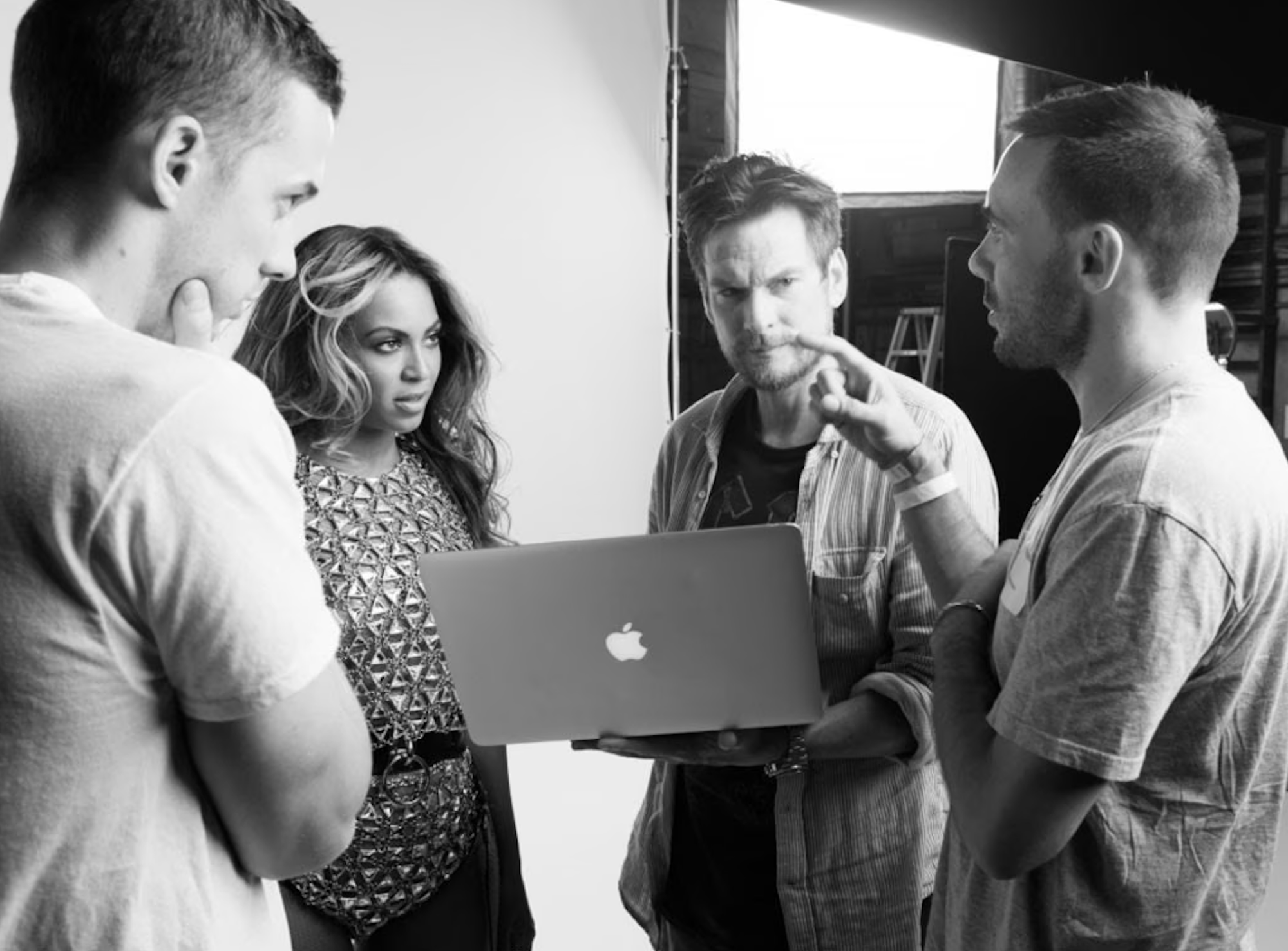
While we’ll be returning to a lot of the below, the Beyoncé Cinematic Universe is known for a number of visual quirks. There’s generally a healthy dose of footage shot on film—in I Am… World Tour, it’s 16mm—and a freewheeling between professionally recorded and more amateur (MacBook or iPhone, etc.) stuff. There’s also a pretty liberal jumping between colour and black-and-white, though more recent films tend to do this to help distinguish between onstage and offstage—not unlike Madonna’s better-seen concert films, whether that’s Alek Keshishian’s Truth or Dare (1991) or Jonas Åkerlund’s I’m Going to Tell You a Secret (2005).
What we see and hear in Beyoncé’s films overwhelmingly belongs to her, and we’ve talked about that being part of a presumed long game she’s been playing since the mid-’00s. (The only real exception so far has been the March on Washington footage in I Am… World Tour, plus any snippets from her star vehicles that have made their way into her live shows.) There will be projects in the next two chapters, however, that memorably include others’ music, poetry, speeches, and archival footage as Beyoncé’s work becomes more expressly grounded in politics and history. And if you could use a visual for this style section, virtually everything I mention appears just in the trailer for Homecoming: A Film by Beyoncé (2019):
Regardless of genre, the editing in these projects will also get more experimental. For concert films in particular, Beyoncé doesn’t seem interested in recreating live shows so much as exploding them into whole new experiences. She’s known as an editor to be percussive and even a little frenetic. She isn’t afraid to totally remove us from the stage with no notice and take us elsewhere (something she does to remarkable, sometimes frustrating effect in Renaissance). And things like slow-motion and match-cutting between different nights have become other trademarks of her performance sequences.
If there’s a single concept to take away from this section, it might be maximalism. In fact, Beyoncé’s films typically have a constantly changing aspect ratio that highlights, rather than disguises, the amount of disparate footage that’s been combined. “I love how mixing media can take you on a journey,” she said not too long ago. “I love combining doc-style footage with live performances and incorporating all aspects of my life on film.”
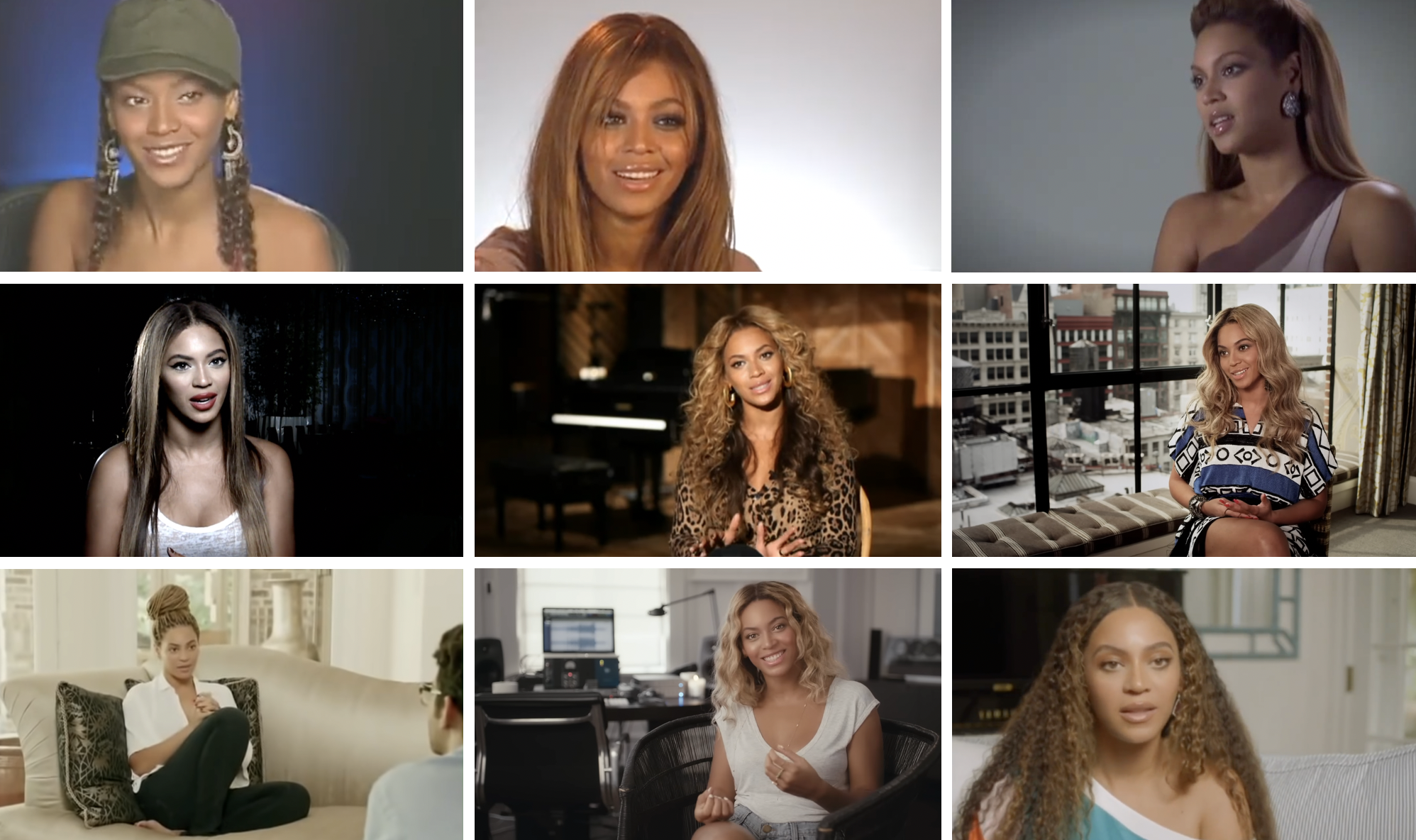
In the early days, Beyoncé would generally sit for a talking head (or multiple) that could be used to structure any doc material; in recent years, she’s become just as likely to record audio without an interviewer, speaking to us softly as if through a voice note at three in the morning. In any case, she tends to narrate, and almost always from a post-mortem perspective, looking back at a period of time that’s already been successfully navigated—the narrative deeply considered before it’s entered into the record. Later, other Carters (especially Jay-Z, but I’m not excluding the couple’s children) will start to play a bigger role in these films as cinematographers. If Beyoncé talking to her laptop was something she’d chalked up in part to loneliness, then it makes sense that we’ll also see less of that sort of footage as her family grows.
If you watch all of these films back to back, you’ll see lots of Beyoncé in the act of being Beyoncé—popping up from underneath stages, doing the choreo she’s kept pretty consistent for two decades, instructing crowds to “singitchall,” leading and being led in many prayers. No matter the genre, she has a knack for bringing us to bodies of water, whether that means staging underwater sequences, or floating in the middle of the sea, or jumping off a yacht. “From as early as 2003’s The Making of Dangerously in Love,” writes Larisha Paul in a 2023 Rolling Stone piece, “the ocean has frequently appeared in Beyoncé’s documentary releases as a place of peace and escape.” Somewhat differently, the star has also spent a great deal of her music-video career setting things on fire—a focus of Kevin Allred’s book, Ain’t I a Diva? (2019).
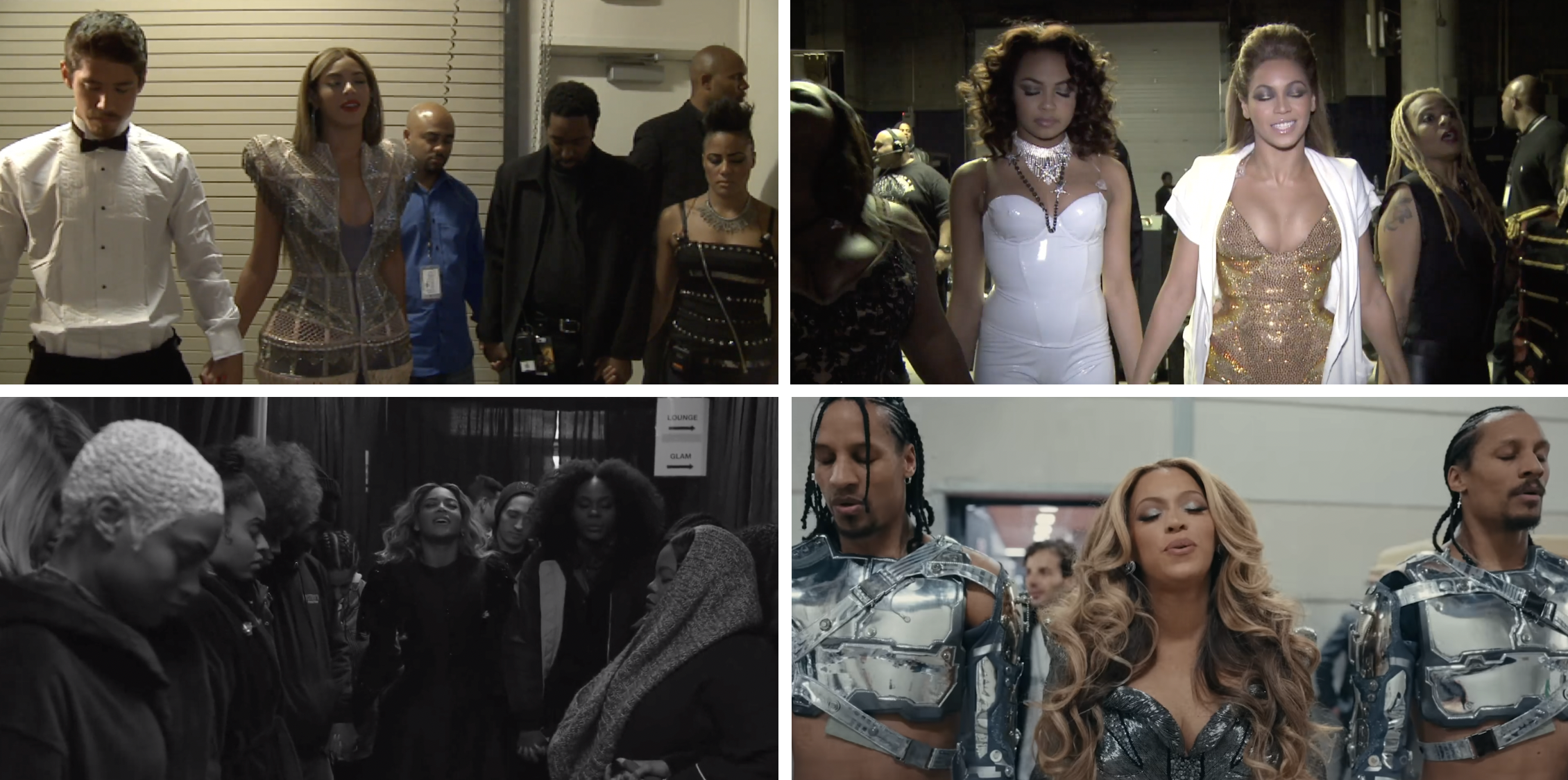
Finally for now, you’ll see a lot of the same faces over and over in these films, again regardless of genre—those of Knowleses and Carters and Beyinces, but also musical director Kim Burse, choreographer Frank Gatson, A&R executive Teresa LaBarbera Whites, hairdresser Neal Farinah, and more. There’s dancer Ashley Everett, almost always there at Beyoncé’s side for a decade and a half. There’s trumpeter Crystal Torres, who you can see cheerily show up to rehearsal in What Happens in Vegas and grow a baby over the course of Renaissance years later. In time, Burke himself would also become more of an onscreen presence, though not so much an actual character. And again, we’ll be coming back to a lot of this.
Separate to any distinct style that B&B would eventually be known for, there are the many narrative and thematic preoccupations uniting Beyoncé’s films. Since her debut, the star has made lots of music about…
- women’s—particularly Black women’s—empowerment (achieved in particular through financial independence) and sisterhood;
- God, faith, and spirituality more generally;
- being so in love—dangerously, crazy, drunk, blindly—that you might be losing your sanity;
- inheritance and legacy, and sieving the curses out from the gifts for the sake of your children;
- time being a finite resource that you’re actively running out of;
- being blessed with sublime looks and talent and, perhaps relatedly, getting slammed with some frequency in the backseats of cars…
…and all of these have at some point made their way into her visual work.
There’s another preoccupation, though, that seemed to travel in the opposite direction, spending years as a theme in Beyoncé’s films before it moved over to her music, where it’s now a pretty major one. And that’s the very biblical notion that you reap what you sow, that pleasure and freedom and beauty are wrought from hardship and discipline and “sacrifice,” a word the star used four times in the previous chapter and will use many more times before we’re through.
These days, this principle is almost par for the course in Beyoncé’s music—and if that doesn’t sound right to you, stick around for the next two chapters. But I’d argue that it only seriously started trickling in (though there had been hints of it here and there) with the album we’ll discuss next, 4 (2011), after which it skyrocketed with the ones she made in her 30s. A superstar can shamelessly tell the world to bow down because she spent her teens rehearsing while everyone else partied; a marriage is fulfilling because it was shattered and pieced back together; a young lion comes into his power because he experienced a grave loss. Again, you get to reap because you sowed.
But this kind of framing was part of the Beyoncé brand years before it became a bedrock of her music, and that’s because it had already spent at least half a decade crystallizing in her films, mostly documentaries that revolved to some degree around her work ethic.
“I could have drank and I could have smoked weed and done things that I’ve never done, but I didn’t want to because I wanted to be in this seat right now,” she’d said in BET Presents Beyoncé (2006). “And anybody can be in this seat right now, you just have to work hard and sacrifice and not let anybody steer you the wrong way.”
“I am constantly being tested,” she told Burke’s camera the next year while bruised and sleep-deprived in Anthology Behind the Scenes (2007). “Do you really want to be a superstar?”
Beyoncé’s three decades of constant and sometimes tedious work, which began when she was a preteen, have made her one of the most successful entertainers of all time. They’ve also come at certain costs—to her body, to her privacy, to her relationships, to those between her family members, to a traditional coming of age. This isn’t that up for debate; in recent years, she’s taken numerous opportunities to tell us this herself, and we’ll be coming back to it as she brings it up.
But because it took a while for her to noticeably sing about these things, film is the sole artistic medium through which we’ve gotten a real-time, since-day-one look at her processing them. In the next chapter and beyond, Beyoncé will produce a number of projects where she reckons with her twisted relationship to work—how it’s shaped her life, where she imagines she got it from, how she’d like to see it change. We’ll also see her struggle a bit to implement that last part; though motherhood seems to significantly up the stakes, old habits still die hard.
There will eventually be a shift that comes with the first several releases of her 40s, and when she tells us in Renaissance that she’s “transitioned into a new animal,” it’s the first time in her career that the film around the quote gives us reason to believe her.
For now, though, we’re still in her late 20s, when she remained relatively uncritical about her relationship to work, at least publicly; if anything, her “Puritan work ethic” (as several sources referred to it in my research) is what helped distinguish her in the industry. Around this time, Beyoncé sometimes played with the idea that some might think her robotic as she pursued her dreams, emerging from a robot suit every night on the Beyoncé Experience and playing around as a robot for much of the I Am… Sasha Fierce era. But the truth is that she sometimes described herself unironically in non-human, even mechanical terms. “When I work, I don’t eat, I don’t use the restroom,” she says in What Happens in Vegas. “I’m like a machine.”
Because Beyoncé’s early docs had overwhelmingly seen her recap the making of an album, performance, or tour that the world had already seen and loved, they were essentially close looks at someone deep in sowing mode, but narrativized by someone deep in reaping mode. Which means that we get the injuries and the insomnia and the sometimes heated exchanges with collaborators, but all of it implicitly justified by the applause and glory and culture-defining art we know all of this work leads to. And what makes these films especially interesting is that it’s Beyoncé herself who’s shaping them, reporting for duty as both producer and product.
Early films tended to include three major pillars, which I hinted at last chapter when we talked about Anthology Behind the Scenes. For one, we’re shown that divadom is hard fucking work. And because the star is not just a performer but the kind who’s an athlete, it’s work that’s often carried out physically, resulting in all manner of bodily distress. “Whenever I’ve had a video that’s great, I’ve definitely bled somewhere,” she once said, and her documentaries corroborate this—mostly through her voiceovers, but occasionally onscreen.
The star has released multiple clips of herself fully wiping out, whether that’s falling down the “Green Light” (2007) stairs or crashing into the “Single Ladies” ramp while channelling Shirley MacLaine. In the short about the making of her 2006 VMAs performance, we’d seen her show Burke the bruises she’d picked up in rehearsals. In Anthology Behind the Scenes, she remembers the brutal soreness and near-sleepless nights. In What Happens in Vegas, we see the scratches that her costume is leaving on her arms. In Mic and a Light, she describes losing hair from stress and going home “cut up.” (Renaissance, fascinatingly, would reveal that she’d actually omitted a more serious injury from Mic and a Light, one that may have been a bit trickier to narrativize—though she did actually mention it in her 2009 conversation with Steve Jones.)
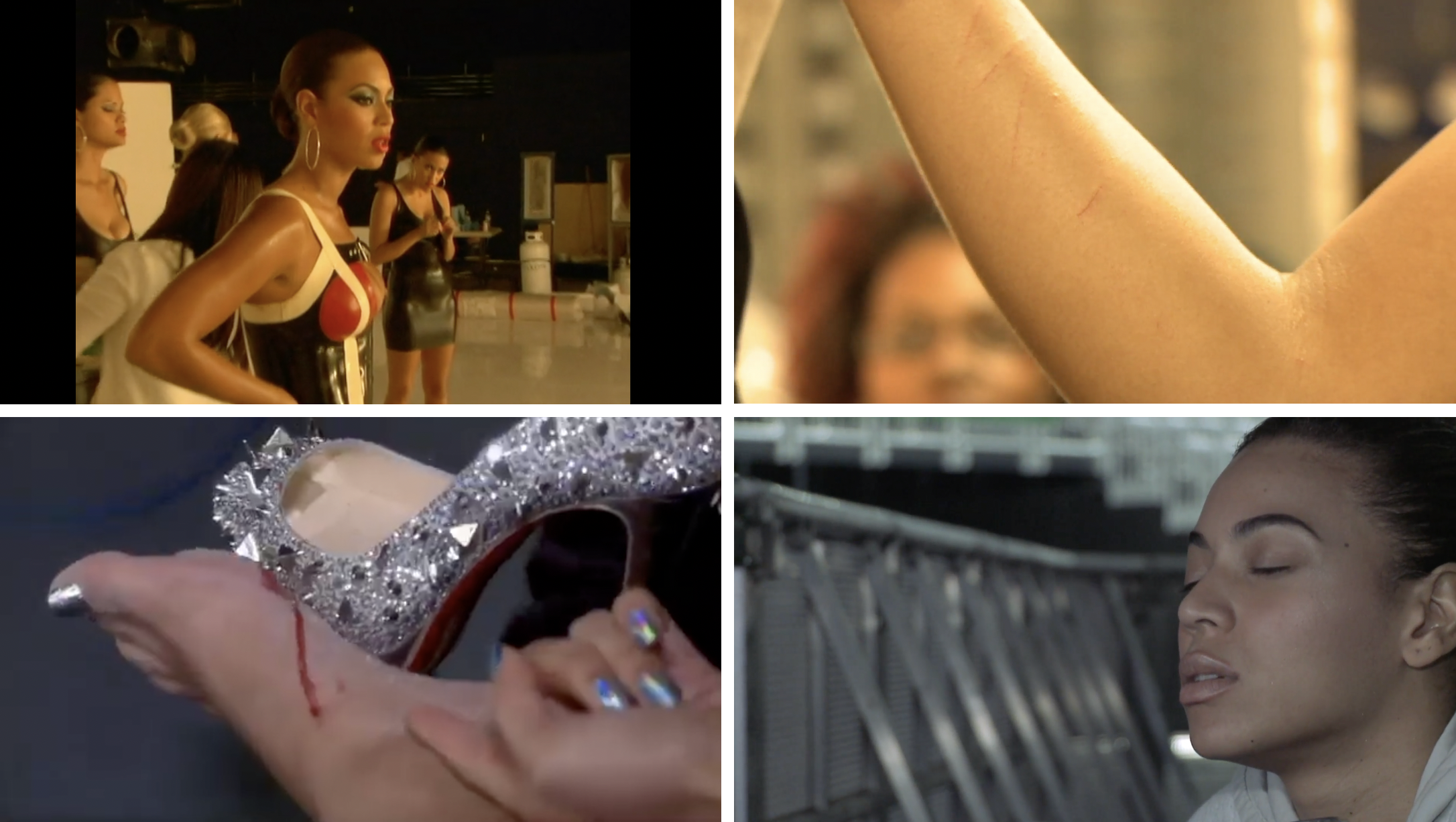
And this is all to say nothing of any other self-disciplining that might be happening offscreen; future films will more explicitly get into things like dieting and exercise, but it was mostly something she left to interviews in the meantime (which is not to say that it never popped up in behind-the-scenes content).
The second pillar is that while Beyoncé always bears the brunt of the hardship in these documentaries, she necessarily requires the labour of many others to see her projects through. “We couldn’t have done this show if everybody didn’t sacrifice sleep, sacrifice spending time with their families, sacrifice their days off,” she says in What Happens in Vegas. “I’m a person that’s willing to stay up 24 hours to make sure that it’s right, and I need a team that’s willing to do the same thing.” She even admits to downplaying her fatigue in the presence of colleagues: “I set the tone, so if everyone sees that I’m tired, then they have reason to be tired. So I always pretend that I’m completely fine.”
Another interesting quirk of these films is how, just as we sometimes see moments of Beyoncé frustrated with her team, they often show her team frustrated with her, whether because they’re tired or because they’re not understanding what she wants. Sometimes, they’ll take their frustration out on each other, and sometimes they’ll blow off steam right into the camera. There’s a moment in Mic and a Light, for instance, where Kim Burse pretends to be an abductee sending a desperate message about her living conditions, the rest of the crew (their boss included) cracking up around her: “We have to have people bring us stuff to eat … we don’t use the bathroom … somebody save us!”
But the final and crucial pillar is that there’s always a payoff, not only because none of this would fly with the public otherwise but because there has to be something that recasts all the pain and stress we’ve witnessed as a necessary evil on the road to greatness. As Beyoncé says in What Happens in Vegas, “I do have a vision, and though I know [my team] wanted to strangle me … the reward was so high.” Without a triumphant conclusion, these films wouldn’t have the reputation they do for inspiring those who watch them; a staple in any YouTube comment section is the person who’s looking for motivation during finals, or who’s in the thick of job applications, or who generally just needs a boost from one of our foremost workaholics.
A couple months after the release of I Am… World Tour, Deadline reported that Beyoncé was attached to the industry’s next production of A Star Is Born, the romantic tragedy that had already been made three times with that title—in 1937, 1954, and 1976. The film was at that point being helmed by Clint Eastwood, the spaghetti Western antihero-turned-action star-turned-Oscar-winning director. According to Nikki Finke’s report, the project did not yet have a male co-star; she suggested that the studio’s first choice had been Will Smith, and would later say that Eastwood then tried unsuccessfully for Leonardo DiCaprio, whom he directed that year in J. Edgar (2011).
“It’s not unfeasible that the film will rocket her acting career to new heights,” wrote Stephanie Rafanelli in a 2011 Harper’s BAZAAR UK profile of Beyoncé:
given Eastwood’s ability to attract attention of the Academy Awards, and her own genuine thespian talents. In both “Dreamgirls” and “Cadillac Records,” the latter of which she also executive-produced, Beyoncé’s turns shine, aided by her face’s natural expressiveness (those shining eyes, the quivering lips…) and an endless capacity for compassion.
A Star Is Born was reportedly being produced by Eastwood’s company, Malpaso, and we may never know whether Beyoncé had plans to co-produce through Parkwood. Regardless, it was an exciting opportunity on both the acting and soundtrack fronts, and Rafanelli was correct to suggest that Oscars attention was practically guaranteed. But there was more to it than that for Beyoncé: as a kid, her mother had shown her the 1954 version starring Judy Garland, making this yet another meaningful movie. “To play the Judy Garland role is such a huge honour,” she told Rafanelli, though she elsewhere admitted to being intimidated by the whole thing.
(Two days before her engagement in 2007, she’d performed “Over the Rainbow” for a CBS special dedicated to music in film, and the song was later included in the 2009 Oscars medley. There was also the matter of Liza Minnelli, the bestie of Michael Jackson and star of Cabaret whom Beyoncé had recently let cover “Single Ladies” for Sex and the City 2 [2010]. And let’s not forget “Naughty Girl” [2004] having paid tribute to Vincente Minnelli’s The Band Wagon [1953], either.)

It was only a year prior that Steve Kroft had compared Beyoncé to both Garland and Barbra Streisand in that 60 Minutes segment, the latter icon having starred in the 1976 version of A Star Is Born. In a different interview Beyoncé gave in 2011, it was instead Streisand’s version that Ms. Tina had shown her as a kid—“It’s when I became a fan of Barbra Streisand’s”—before she watched the Garland one.
Either way, she seemed to consider the gig a sort of swearing in: “I realized, every 20, 30 years, a new star is born, and a new talent … represents that generation and era,” the star said. “I met with Clint, and I was so nervous, and I know that it is the biggest opportunity of my life. And I will work as hard as I can.”
In all, the (super)stars had truly aligned with this next narrative project.
The A Star Is Born announcement, which arrived in January of 2011, bought Beyoncé a bit of time to manage some of the disarray in her life.
In J. Randy Taraborrelli’s Becoming Beyoncé, he writes of a strange few weeks at the star’s offices, when she apparently spent most of her time “sequestered with her attorneys and accountants in a conference room.” I have gripes with this book, so picture me gesturing towards a huge grain of salt. Nevertheless, the author invokes one interviewee who claims to have seen Beyoncé crying in her office in February; a second shared an elevator ride with her during which she reportedly said, “I’m protecting what it took me twenty years to build.” Taraborrelli concludes that all of this came back to the findings of the audit she’d ordered in the fall, but even putting that aside, he’s probably right to suggest that its being ordered in the first place would have compromised her relationship with her dad.
Beyoncé would announce in a March statement that she and Mathew had decided to part ways professionally:
He is my father for life and I love my dad dearly. I am grateful for everything he has taught me. I grew up watching both [him] and my mother manage and own their own businesses. They were hard-working entrepreneurs and I will continue to follow in their footsteps.
The message between the lines was that Beyoncé would be managing her own business going forward: Parkwood Entertainment, a natural progression of the seeds she’d been planting for half a decade. “There was a pivotal turning point in my life when I chose to build my own company many years ago,” she said in 2020. “To run my label and management company, to direct my films and produce my tours, that meant ownership: owning my masters, owning my art, owning my future, and writing my own story.”
It would take some kinks being ironed out for all of those things to happen, as Parkwood seems to have spent a little while as less a sophisticated corporate entity and more a long-term vision of Beyoncé’s. Nevertheless, her fledgling company would be helping her carry out her forthcoming album era, with 4 set for release as early as June. This may have seemed ambitious, but it’s unclear how much of a choice she had: she’d already signed on to do things like headline Glastonbury the same month as its release.
4 was aptly titled as Beyoncé fourth album, but perhaps you’ve gathered by now that the number also meant something to her: there was her wedding anniversary being on 4/4; there was Obama being the 44th president elected on November 4; and there was the fact that several members of her family had birthdays on the fourth of various months, including her husband, Ms. Tina, and herself.
The album had seemingly begun as a tribute to Nigerian Afrobeat pioneer Fela Kuti, whose name Beyoncé had been dropping since at least 2000, and she eventually broadened its scope to become—in her words—“a gumbo of all of the things I’ve learned from my travels.” If she’d used Deena Jones to explain away a lot of B’Day, and felt the need to play yet another character for half of I Am… Sasha Fierce, 4 opted instead to present a cohesive and complicated Beyoncé.
The version of the star we hear on the album is having lots of sex (“1+1”) and telling us outright that she hopes it leads to a baby (“Countdown”). She’s characteristically down bad (“Rather Die Young,” where she compares her man to James Dean) but not feeling reciprocated in that (“I Care”). She’s at once interrogating her past (“Best Thing I Never Had”) and imagining a world she’s already left (“I Was Here”). And still, she was crediting some of this lyrical content to Etta James. “It was a darker character,” she explained, “and I realized that if anything is too comfortable, I want to run from it. It’s no fun being safe.”
In April, Beyoncé filmed a video for the album’s lead single, “Run the World (Girls),” reuniting with director Francis Lawrence. While Lawrence is best known these days for directing most of the Hunger Games movies, he was previously a music video powerhouse who’d worked with Destiny’s Child on both “Independent Women Part I” (2000) and “Emotion” (2001).
“Run the World” didn’t really sound like anything else on 4 save for maybe “End of Time,” but it had lots to offer the star in terms of narrative. Put simply, the song is a Major Lazer-sampling women’s empowerment anthem, its refrain a cleaned-up version of Henry Hill’s “Fuck you, pay me” line from Goodfellas (1990). It was a strange choice as far as introducing the sound of 4, which was mostly R&B, but it was crucial that Beyoncé began her self-managed era with a bang.
Similarly, Lawrence’s video looked nothing like any that would follow later in the era (and we’ll be coming back to those). Set in a post-apocalyptic desert, “Run the World” sees Beyoncé lead an army of women against a throng of men clad in riot gear. (The only men on the star’s side are Tofo Tofo, the Mozambican dancers her team had tracked down with the help of “embassy people” because no one was able to replicate their choreography from YouTube. It would later win a craft VMA for Best Choreography.) Her “army” isn’t technically an army given that none of the women are armed; as per the song itself, their power comes from their feminine wiles and capacity to grind. The video was steeped in revolutionary aesthetics, but what it really promised was a girlboss takeover.
“Run the World” drew comparisons to two different action sequels that came out during Beyoncé’s childhood, each co-starring a musician she greatly admired: Conan the Destroyer (1984) and Mad Max Beyond Thunderdome (1985), where Grace Jones and Tina Turner respectively play the no-nonsense counterparts to Arnold Schwarzenegger and Mel Gibson’s titular characters.

In the video’s final frames, Beyoncé rips a badge off of one of her opponents’ uniforms before sticking it on her dress, bewildering him. It was a clear allusion to the power transfer that had just happened in her life.
One of Parkwood’s earliest priorities seems to have been creating some infrastructure for all that footage its founder had been lugging around. Sometime in 2011, a job posting was circulated among archivists and library science students at the request of Bill Kirstein, a producer at Beyoncé’s company:
Parkwood Entertainment is seeking a digital archivist interested in organizing and building an archive for a major pop star (Beyoncé) starting with approximately 130 TB of footage with an eye to expanding further in the future. Candidates should have experience with servers and enterprise class storage and be able to recommend hardware solutions. Looking for someone to start immediately, pay is negotiable.
Beyoncé’s “crazy archive” wouldn’t really become public knowledge for a couple of years, and we’ll get into it next time. But: 130 TB of footage. What on earth was she planning on doing with all of that?
A week after 4’s release, a 20-minute documentary called Year of 4 (2011)—co-directed by B&B—appeared on YouTube. (Snippets would later be built into ITV’s A Night with Beyoncé [2011], another Steve Jones-hosted special that was filmed in July but not aired until December.)
The short begins with Beyoncé drawing a “B” in the sand at the beach—shot on film and potentially by her husband, who’ll emerge as one of her most interesting cinematographers. “I’m always happy when I’m surrounded by water,” she narrates:
The ocean makes me feel really small, and it puts my whole life into perspective … And it humbles you, and it grounds you. And it makes me feel almost like I’ve been baptized, and I’m born again when I get out of the ocean. Am I the same Beyoncé? Absolutely not.
She then tells us about her so-called hiatus through a talking head that she’s filmed in Manhattan. The star describes being busy to the point of not really being able to absorb the awards she was winning or the meaningful things fans would tell her on the street. She explains that it was her mother who “almost harassed” her into taking a break, and we get a montage of her travels—tobogganing on the Great Wall of China, scuba diving in the Red Sea, picking Julez up from school. “It gave me time to reflect,” Beyoncé says, “and it gave me time to really think about my life.”
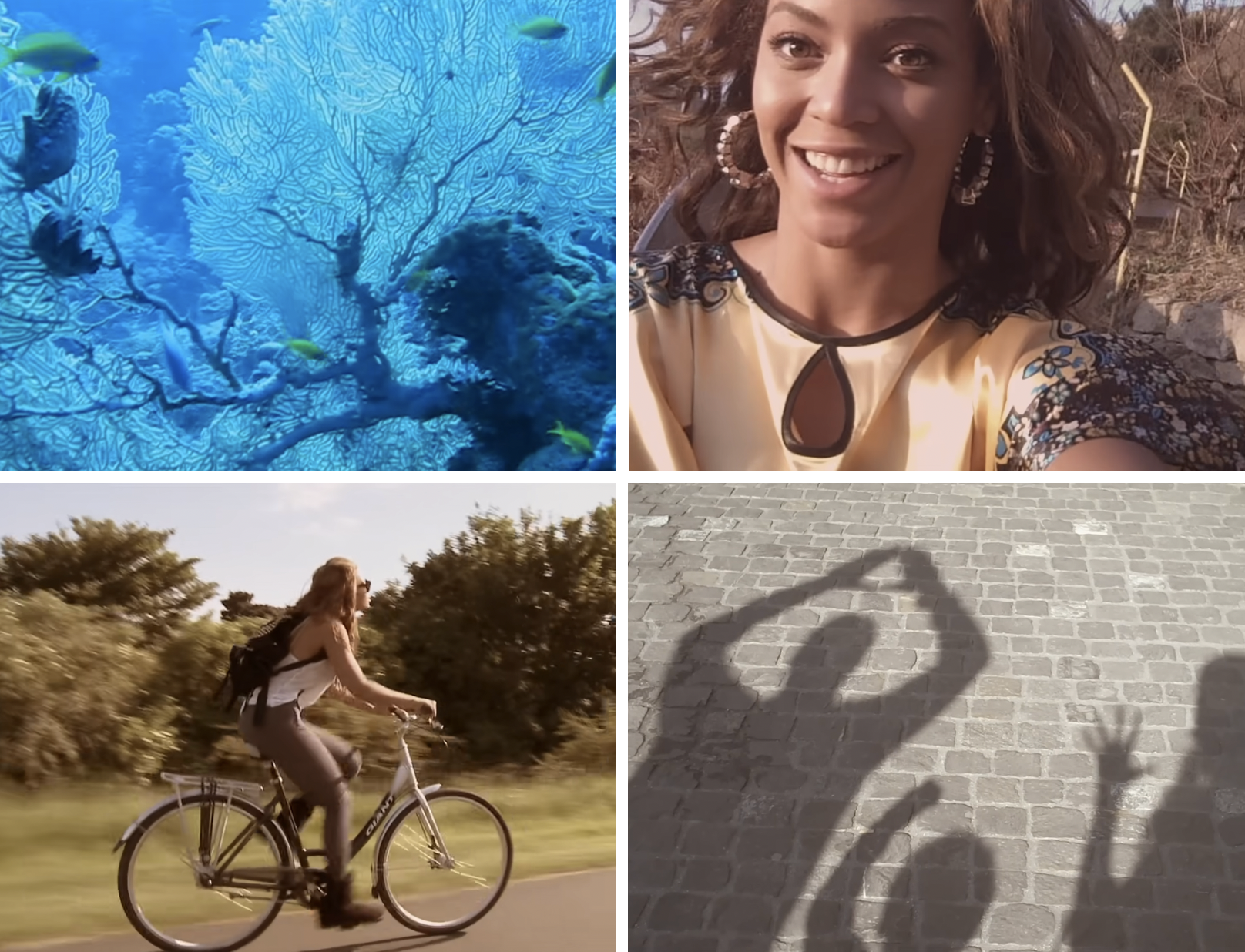
It’s all that reflection, she suggests, that led to a realization, which she explains as we see home-video footage of her and Mathew in the ’80s:
Now that I’m older, there are things that I want to say in my art, but that meant I had to make a very tough decision. I’ve been managed by my father for a very long time, and [it’s been a real change] separating from him … Being a young woman, I want to set the example that it’s possible for us to own our own businesses and own our own record labels. And sometimes we don’t reach for the stars; sometimes we are satisfied with what people tell us we’re supposed to be satisfied with. And I’m just not going for it.
Beyoncé has never named a lone reason behind her professional split from her dad; the story has changed a little each time she’s told it, and it’ll be rawer the next time she does so in a documentary—not that there can’t be truth in all of the variations. (Importantly, though, none have ever come back to his personal life.) In Year of 4, the narrative was thus: Mathew’s presence had somehow been preventing her from saying certain things in her art, and she’d been looking to have her own empire anyway.
From there, most of what we see has just been shot in the past few months, as Beyoncé prepares 4 and puts together the “Run the World” video. We get a lot of our usual beats: “I am a workaholic, and I don’t believe in ‘no.’ I don’t believe in ‘I need to sleep.’ If I’m not sleepin’, nobody’s sleepin’.” “It was very ambitious and very risky to try to achieve what we achieved, especially with the amount of time we had.” There’s also a moment where the album’s two creative directors, Melina Matsoukas and Jenke Ahmed Tailly, butt heads a little, and Beyoncé essentially tells them to take their conversation outside.
One of the more fascinating things about Year of 4 is how its makers were openly admitting to the pandemonium that had followed Mathew’s firing. “I got budgets to approve and people to hire and a million things going on in the same week,” the star says while rehearsing choreography. “Independence is not easy, but it’s gonna get easier. As I get my team, it’s gonna get easier.” Later: “It’s very difficult managing myself. Every night when I go to sleep, I ask hundreds of questions … And I’m making mistakes, and I’m learning from them.”
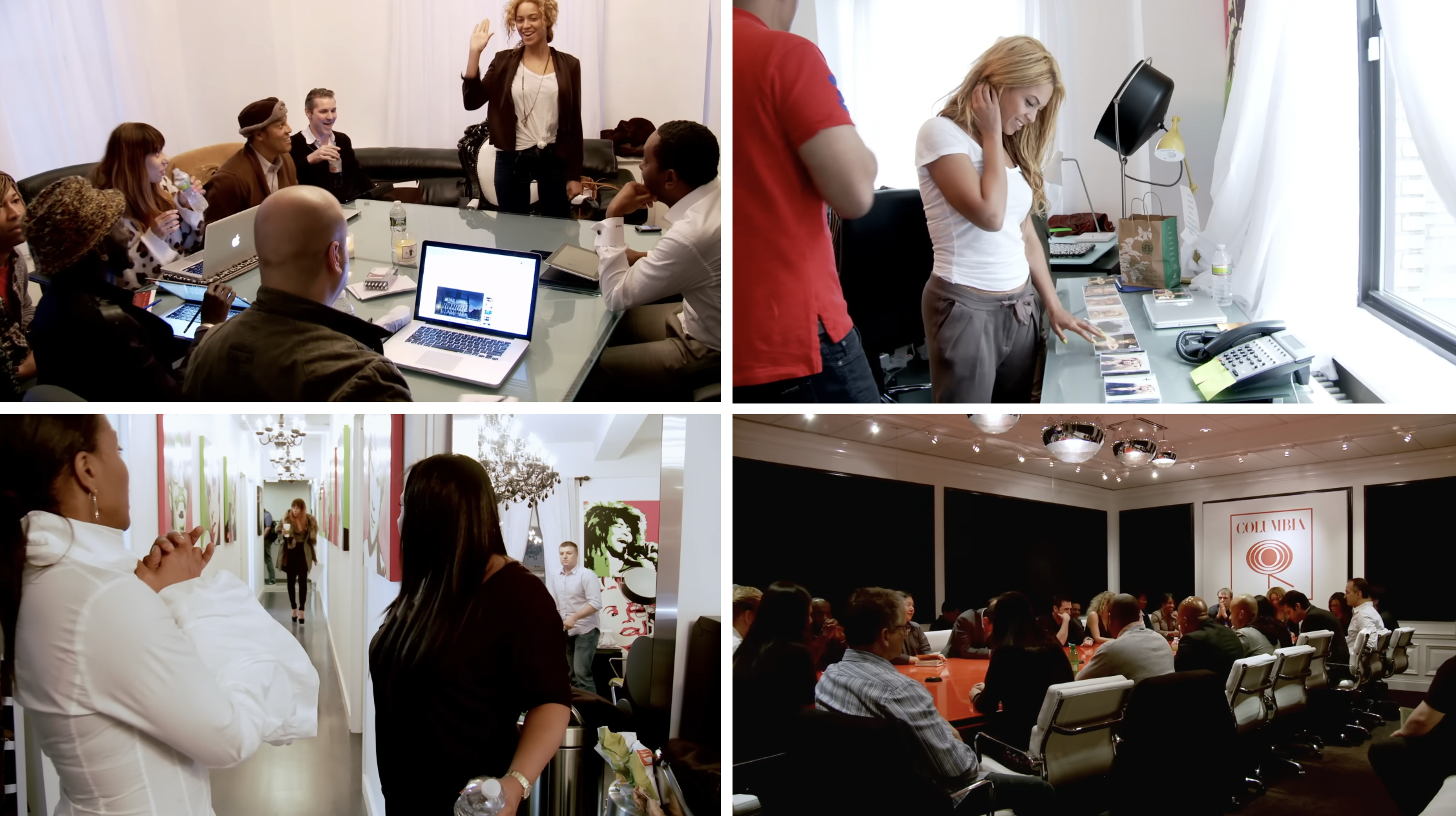
Though Year of 4 is about Beyoncé flying solo for the first time in a business sense, Parkwood isn’t ever mentioned by name in the film. Nevertheless, we can see that it already had some kind of office space in New York City, decorated with Pop Art-y portraits of icons like Tina Turner and Marilyn Monroe. In the years to come, the star would describe populating her company with “underdogs,” people who’d lost out on jobs elsewhere because of sexism and racism. But a lot of the initial team was simply carried over from the Mathew days: Burke, but also publicist Yvette Noel-Schure, business manager Lee Anne Callahan-Longo, stylist Ty Hunter, and more.
Despite all of this, the Beyoncé we see in the film is still notably beholden to other corporations. We hear talk of the album cover being due to Target that Friday despite not being confirmed. She also has to present 4 to a room full of Columbia Records executives; if this is something she’d have to do in the future, we’d never be shown it again.
“What did you do on your vacation?” asked Complex in a July 2011 profile of Beyoncé. “Well, the hardest working woman in entertainment started a production company and learned how to edit movies.”
Though it would take most of the world until around Lemonade (2016) to wake up to the idea of the star being a serious filmmaker, one of the more interesting aspects of this research project has been seeing just how long before then Beyoncé had started courting that kind of respect. Though the work itself did not begin in 2009, that was arguably the year she really started dialling filmmaking up in her branding—taking interviews to highlight her recent producing and directing, excitedly detailing the films she wanted to make next, and (as always) emphasizing this work’s centrality to the music we were hearing from her.
As we approach the end of this chapter, then, there’s a disappointing and revealing sense that we haven’t moved too far past base camp. Perhaps not helped by the star’s own tendency to keep making new “directorial debuts,” I Am… World Tour had seemed to reset her production record as far as the public went. The many music videos and documentary shorts, the several earlier concert films, the two narrative features she’d executive produced through Parkwood Pictures—all of this work had dissolved into the background for many people. So as far as 4-era media coverage of Beyoncé went, Parkwood had appeared out of thin air in 2010.
But anyway: Year of 4 was the first film release from her new company, and it would help steer the narrative of one of her messier rollouts, plagued as it was by behind-the-scenes question marks and unfortunate leaks. 4 ultimately garnered zero top-ten singles in the US—a career first—but the documentary had conveniently presented an artist who didn’t really care about that sort of thing, who’d had enough of a blast just putting the project together. “My focus is not bigger, it’s quality,” she says, “and I want to make sure that it’s something I’m proud of years from now.”
The film also meant that Beyoncé had already said all she may have wanted to when, a week after its release, Mathew filed legal papers against Live Nation, inadvertently alerting the world that he’d been fired in the aftermath of an audit. He insisted to the New York Post that he didn’t believe it was the reason for his dismissal, saying, “[Beyoncé] changed almost every aspect of her business.” And if true, that would mean she hadn’t necessarily lied about the changeover in Year of 4. Taraborrelli’s biography traces the legal paper trail to October of that year, when a Texas courthouse apparently denied Mathew in his ask to have Live Nation executives deposed. “As of this writing, [he] has not proceeded with any sort of lawsuit against Live Nation Entertainment,” the author writes.
By this time, Beyoncé was keeping a much happier secret: in April, pretty much exactly as she released a single about being strong enough to bear the children, she’d become pregnant herself. As a result, she’d been navigating 4’s rollout with a gradually growing bump and apparently awful morning sickness; friend and Goldmember co-star Gwyneth Paltrow, who watched her Glastonbury set from the VIP section with Jay-Z, would later suggest that the star had puked through it… adding a new dynamic to her all-timer performance of “The Beautiful Ones” from Purple Rain (1984).
If a world tour had been anywhere on the horizon, one would not be possible indefinitely. So Beyoncé booked herself in for another residency: 4 Intimate Nights with Beyoncé, to be performed at New York’s historic Roseland Ballroom in August. The format of the show was the reverse of her Vegas one in 2009; the star devoted the first half to telling her story, then took the second to run through her newest album in full.
She and her mother did what they could with costuming that week to conceal her pregnancy, but it was only days later that she decided to throw in the towel. Beyoncé arrived on the VMAs red carpet with her bump fully on display, and pointedly rubbed her belly during a performance that night of “Love On Top,” one of several reaping/sowing songs on 4 (“Nothin’s perfect, but it’s worth it / After fightin’ through my tears / And finally, you put me first”).
Minutes after this news, Deadline’s Nikki Finke reported that Warner Bros. might need to delay production on A Star Is Born, which had been hoping to start as early as February: “That will give the studio more time to settle on a male co-star for the singer/actress.”
Two days later, Ms. Tina filed for divorce for the second time, her initial case having been dismissed when nobody appeared in court the year prior. A few weeks after that, the now 30-year-old Beyoncé filed for the trademark for Parkwood Entertainment.
In time for Thanksgiving, Beyoncé had a new DVD ready for fans: Live at Roseland: Elements of 4 (2011), which appropriately came with four components. First, there were the seven videos the star had made for her album, and second, there was an 18-minute short about them called Behind the Camera (2011)—jointly helmed by B&B. “Music has definitely become more of a visual expression,” Beyoncé says at the top of the latter. “People not only want to hear, they want to see, they want to touch, they want to feel.”
The videos from 4 were a real mixed bag, their strongest through-line probably being Beyoncé’s presence as a co-director on all but two (“Run the World” and “Best Thing I Never Had”). “I felt that I was ready to take control of the creation of my videos from beginning to end,” she explains. “You have to … have your own eye, and not be a product or a robot or a Barbie.” That said, she also managed to do a lot of film referencing with the album. For “1+1,” which she directed with Burke and Laurent Briet, she channelled Romy Schneider as the actress appeared in L’Enfer, Henri-Georges Clouzot’s never-finished mid-’60s film, down to the cinematography.
Beyoncé fashioned herself as a ‘40s noir femme fatale in “Dance for You,” a video she directed with her future (and no longer) brother-in-law, Alan Ferguson. In behind-the-scenes footage from the shoot, which drags into the early hours of the morning, Frank Gatson says that they’re trying to achieve “that Marlene Dietrich feel,” and it seems Dietrich was someone the Parkwood team was generally thinking a lot about around then. For L’Uomo Vogue in the summer, Beyoncé had explicitly been made up as Dietrich in a shoot photographed by Francesco Carrozzini, who’ll become a director of the star’s in the next chapter.

“Countdown,” for which Beyoncé reunited and co-directed with Adria Petty, nodded to Funny Face (1957) among its many references to bygone-era glamour and modern dance. (Whitney Houston had herself referenced the Audrey Hepburn musical in “I’m Your Baby Tonight” [1990], which not only saw Houston play all three Supremes but mount her own tribute to Dietrich—interestingly, recreating everything about the scene in Morocco [1930] where the German actress kisses a woman except for the kiss itself.) Petty would suggest to MTV News that a lot of the video album had been shot with urgency: “Beyoncé brings in a number of her own people … Our video was the fourth they had shot in five days.” (“Countdown” would later win its own craft VMA for Best Editing.)
In Diane Martel’s “Best Thing I Never Had,” Beyoncé marries the love of her life (Juan Antonio) in a present-set timeline while looking back at the disappointing prom night she shared with an ex. These flashbacks are presented in faux camcorder footage, sort of like the kind the star was always putting in her projects. But it seems that only some of what was shot for them actually made it into the video; Behind the Camera shows us Beyoncé getting ready for her imagined prom in a bedroom decorated in ’90s-appropriate posters, including those for the Janet Jackson-starring Poetic Justice (1993) and the cult classic Cruel Intentions (1999).
One of 4’s best videos happened to be completely free of film references, and that was “Party,” where Beyoncé and Ferguson directed a bunch of special guests—including Solange, Kelly Rowland, and model Shaun Ross—as they let loose in a trailer park. But in the behind-the-scenes segment, there’s this unexpected flash of darkness that comes out in the star’s narration. “Growing up, I had really amazing parents and I had a great childhood,” she says:
We went from nicer homes to being in apartments with our lights cutting off. It didn’t matter where we were ‘cause we had love and we had so much fun, and it’s great when you don’t have as much how you improvise and you have more fun … It’s all about the people you’re around, and the good music, and good food. That’s what makes a party.
Now this was intriguing. That the Knowleses had struggled financially during Beyoncé’s youth, so much of their savings having been sunk into her burgeoning career, was a bit of lore that came up regularly in the Destiny’s Child days but then more or less stopped coming up. And by 2008, the star was saying things in interviews like, “I grew up upper-class … Private school. My dad had a Jaguar. We’re African American and we work together as a family, so people assume we’re like the Jacksons. But I didn’t have parents using me to get out of a bad situation.”
It's true that Beyoncé was born into comfort, living in a nice house on Houston’s Rosedale Street as a little kid before moving five minutes away into an even nicer one on Parkwood Drive—“this beautiful living space,” as a teenage Solange remembers in a VH1 Driven episode about her sister’s girl group. But when Mathew left corporate America to devote all his energy to what was then called Girls Tyme, and the group was signed but subsequently dropped by Elektra Records, things changed for the Knowles family. “He and Tina both put everything they had into Girls Tyme,” says Angie Beyince in the same episode. “Money, time, their house … Tina had to take care of everything, so she worked and she ran her salon, and the family survived off of what Tina was making.”
From there, Ms. Tina mentions having to sell their house and cars, and Solange remembers moving into a two-bedroom apartment with her mother while her father moved into a different one. (The couple had separated at the time, as they told VH1.) In a deus ex machina, the group is eventually signed to Columbia, and the rest is music history. “Nothing worth anything comes without a cost,” says the family’s longtime pastor, Rudy Rasmus, sounding not unlike Beyoncé in many of her films.
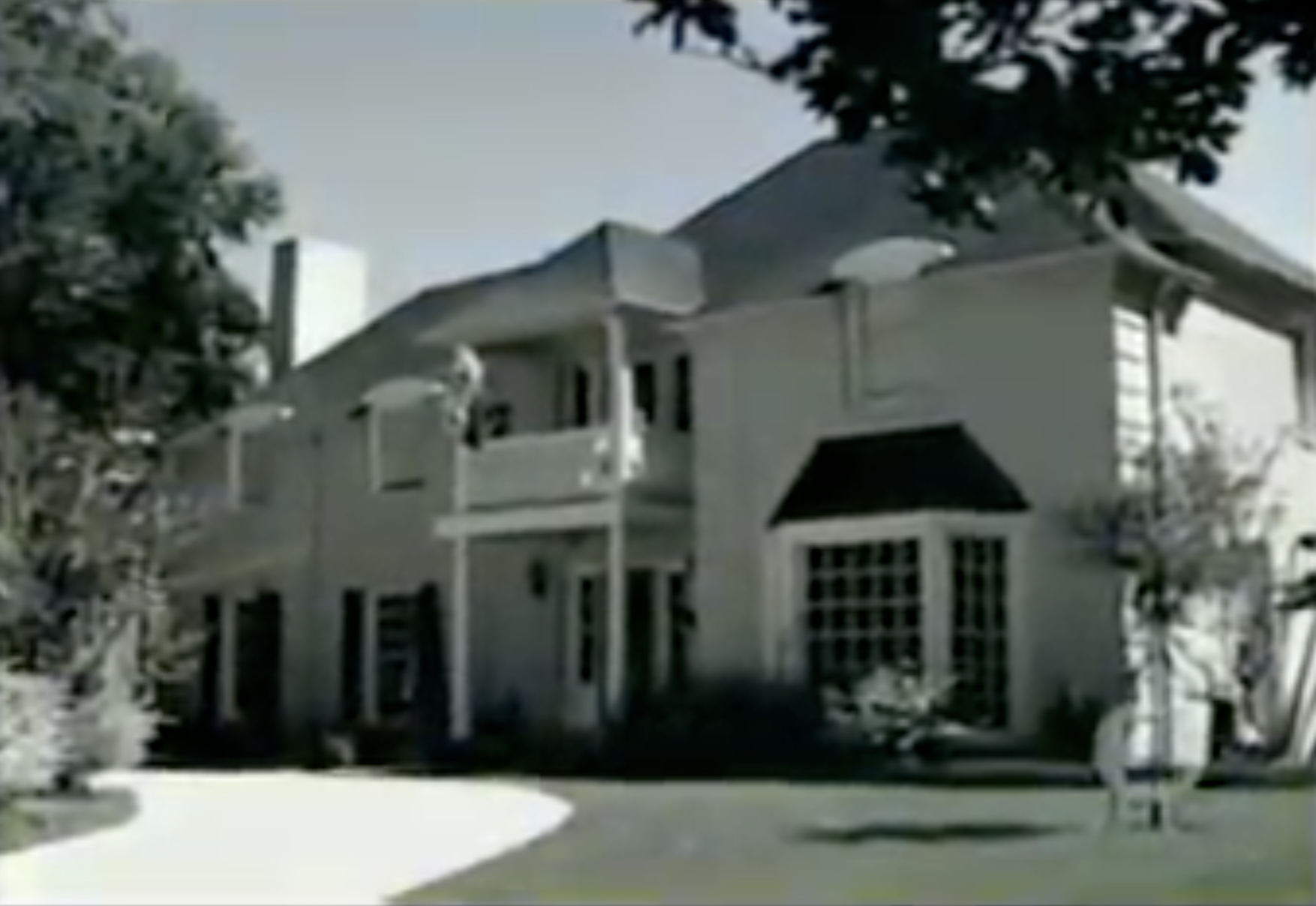
In any event, the star seemed to carry that cost with her, so much so that she’d one day name her company after that beautiful living space at 3346 Parkwood Drive. And for her to allude to the loss of the house on the set of “Party” was curious, as if the 4 era had found her thinking a lot about the past—referencing movies and music videos from her childhood, envisioning the prom she never attended, and making something from nothing with Kelly and Solange.
“You know it costs to be the boss,” Beyoncé sings on “Schoolin’ Life,” a song from her album’s deluxe edition. “One day, you’ll run the town.”
Because Beyoncé has released so much behind-the-scenes content in her career, her films have by default become about her directing journey, just as they have her evolving relationship to work and development as a musician, mother, wife, and person.
“What’s funny is how much she actually knows about direction and … lighting,” we hear J. Cole say in the Behind the Camera segment on “Party.” But the star herself felt she still had lots to learn. “I need to understand lenses,” she thinks out loud on the set of “Love on Top.” “It’s just as important as lights.” (A little over a decade later, Renaissance would memorably highlight her now-fluency with both.)
The “Love on Top” video, which Beyoncé co-directed with Ed Burke, featured a detail that’s interesting for all of these reasons and more. Much of it is a direct nod to New Edition’s “If It Isn’t Love” (1988), but where the star and her dancers’ get-ups change with the song’s key changes. At the very end, though, just after she hits that final note and freezes in place, she reveals herself to be the video’s director.

“Cut!” she yells, then exits the frame as if headed to see playback. If the messaging of 2011 was that it was Beyoncé who now called the shots, the “Love on Top” video totally literalized that idea.
The third piece of the DVD was Live at Roseland (2011), the concert film of Beyoncé’s August residency—co-directed by B&B, plus Anthony Green, who’d been credited as “Interview Co-Director” on Year of 4. As the press release read, “The concert documentary is filled with never-before-seen footage that captures Beyoncé’s life from eager five-year-old music fan to a consummate entertainer who is in control of every inch of her life and career.”
“Never-before-seen” wasn’t just PR-speak: while the star is a filmmaker who’s often reused and reinterrogated the same bits of footage over and over, Live at Roseland feels almost like she’d recently located a long-lost hard drive; the project contains quite a bit of material that had never appeared before in a film, and some that’s never appeared since. “My life goes by so fast,” she narrates as we open on a sequence where she’s playing around with a camera in a hotel bed. “My idea of success has completely changed. Whatever I do, it has to be something that’s gonna teach me something about myself, teach me something about life.”
Once the show begins, she again recounts her journey through song and dance, a lot of the script kept identical to that of the 2009 Vegas residency. (Even the “Mein Herr” chairs are there.) Now, though, the Girls Tyme/Destiny’s Child segment is scattered with archival stuff of the group in the ’90s and early ’00s. When Beyoncé alludes to getting into her romantic relationship in 2002, we actually see Jay-Z driving her around in a convertible. When she mentions playing the role of her life in Dreamgirls, there’s rare footage of her on set in her Deena costume.
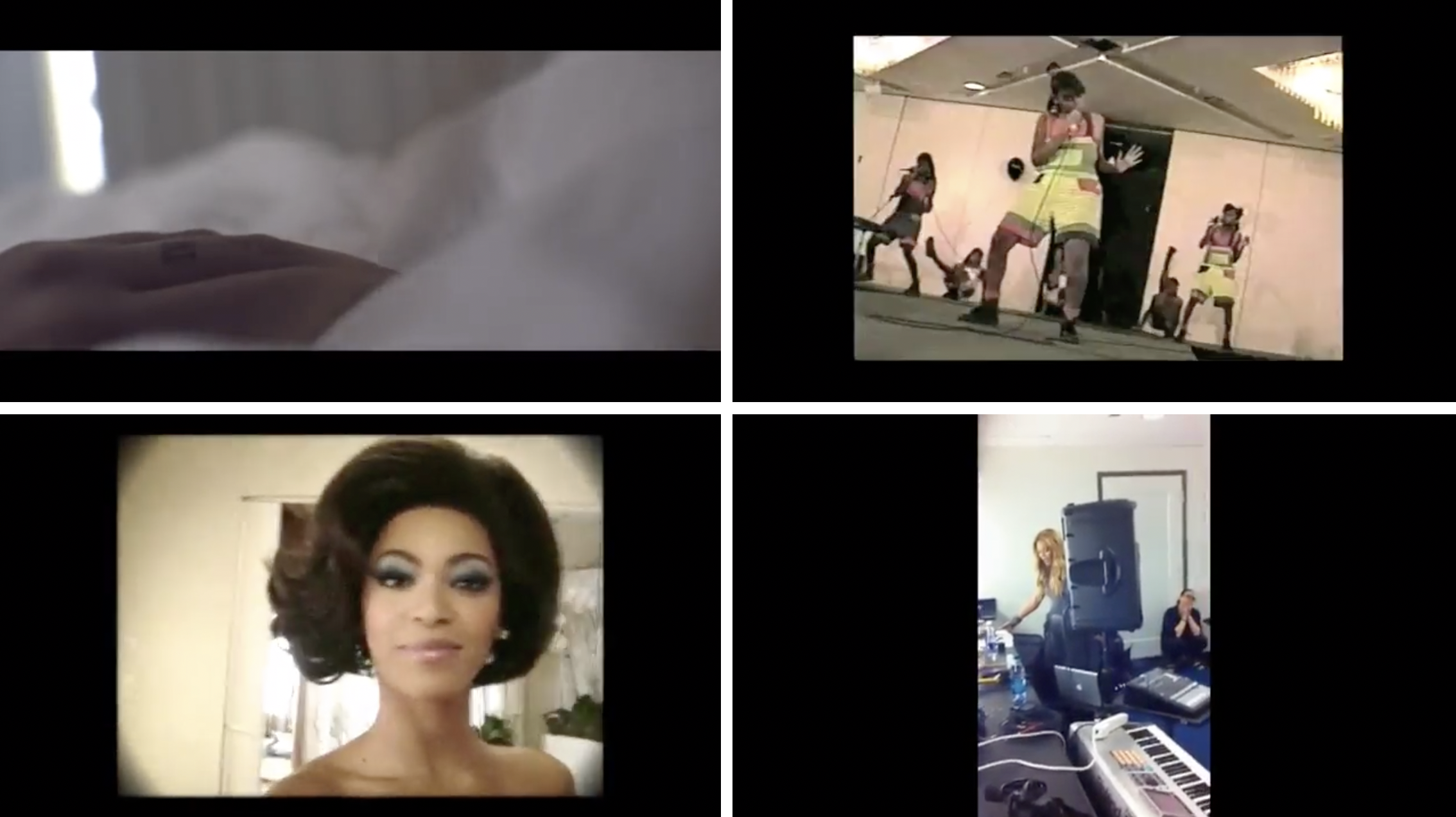
“Being cast as R&B legend Etta James was definitely one of the most challenging roles for me emotionally,” she says when she reaches 2008. “But all the hard work, it paid off. Because it honoured me my second Golden Globe nomination.” (In truth, it was her third, and had of course been for “Once in a Lifetime.”) Overall, the biggest difference between the Vegas and Roseland sets was that this one actually felt up to date, acknowledging that she had a husband and properly contextualizing the album she performs for the other half of the show: “What do you do after 16 Grammys and millions of records sold? Whatever makes you happy.”
The 4 portion of the film is equally bolstered by doc footage. What we see in “I Miss You” is tied together by the presence/absence of Jay-Z, depending on the shot; there’s also Beyoncé playfully strutting around with her growing bump. During “End of Time,” the sequence jumps between three different performances of the song from that year—the residency’s, Good Morning America’s, and Glastonbury’s. “1+1” is largely replaced by Beyoncé rehearsing the song before her American Idol performance, as shot by her husband on an iPhone; I believe it was the first time she’d ever built vertical video into one of her films.
“This vision does seem to be hers, as it’s too idiosyncratic a mesh of tastes and textures to reflect some timid P.R. plan,” observed Sasha Frere-Jones in the New Yorker. And indeed, it comes back to what I described earlier as maximalism; there’s an offbeat, borderline collagist sensibility to Beyoncé’s visual work that one might consider added “evidence” that it’s “really” her authoring it. The concert film’s “Rather Die Young” sequence features some of her most bizarre MacBook material ever, where we see that she’s done herself up as Charlie Chaplin, nailing the silent film star’s mannerisms, as well as some sort of doll. (Eventually, she smears her makeup all over her face with her hands, because why not.)

The real centrepiece of Live at Roseland, though, is “I Was Here,” which is turned almost entirely over to a quarter-century’s worth of personal footage. “It’s taken a lot of hard work to get to where I am,” Beyoncé says. “I searched all around the world and I found myself.” As she performs what’s arguably the ultimate reaping/sowing song on 4, about desperately wanting to leave behind a meaningful legacy, we get a sort of visual summary of this series so far—the music and movies, the many legends who’ve embraced her (and even the ones who were a bit more stubborn), the history she’s started to make. Some of this footage actually bears a date and location, adding an interesting layer to the song itself; Beyoncé was here, and here, and here.
As with I Am… World Tour, the concert film is less a filmed concert than it is live and archive working in tandem; Live at Roseland didn’t really aim to replicate the experience of being in the Roseland Ballroom. Future concert films from Beyoncé would often exist in a similar vein, where “concert film” sometimes feels like an insufficient label. And in hindsight, we were very clearly looking at the work of someone who’d recently been revisiting and archiving a lifetime of visual material.
The fourth and final piece of the DVD was a seven-minute documentary called Behind the Stage (2011), which plays like an extended trailer for the concert film. The short was co-directed by B&B, plus Bill Kirstein, the producer who’d circulated the digital archivist posting. You don’t learn that much from this one aside from the fact that Beyoncé’s collaborators find 4 to be her most mature album, and that legends like Ginger Rogers and Madonna have previously performed here. If only there were a way to somehow integrate a making-of short into a concert film.
To promote the release, a very pregnant Beyoncé sat down with Katie Couric for a 20/20 segment on “her new production company.”
Noting that Parkwood was named after one of the streets she grew up on, Couric characterized the whole operation, interestingly, as “a reminder of the lessons from home.” Citing Ms. Tina’s drive and balance when she was a kid, the star herself says, “I hopefully can inspire other women to continue to write and produce their own songs, and direct their videos, and have their brands [that are] really them; it’s not something that somebody is telling them to be.”

“You actually have been editing yourself, right?” Couric asks during their sit-down.
“Yeah, well I learned how to edit, for the last DVD, [in] Final Cut Pro,” Beyoncé responds. “And I make all my selects, and I sit in the same chai—”
“Listen to you, ‘I make all my selects,’” Couric interrupts, coming off more condescending than probably intended.
“I mean, I am an editor as well,” the star says, laughing but shrugging. “I have great editors, thank God. But it is a lot of work, especially when I’m trying to tell stories that are from so many different eras or moments of my life.”
Beyoncé then brings Couric into Parkwood’s editing suite, where she explains, “It’s like a puzzle. It’s like a baby, you know. You have this idea in your head, and you have to work so hard, and it’s very painful, but in the end you have this amazing thing that lives forever.”
A few weeks after the interview aired in December, TMZ reported that Ms. Tina and Mathew’s divorce had been finalized sometime in November.
A couple of weeks after that report, in early January, Beyoncé gave birth to a daughter named Blue Ivy—her second name a phoneticism of the roman numeral IV. “Her birth was emotional and extremely peaceful,” Blue’s parents wrote in a statement. “We are in heaven.”
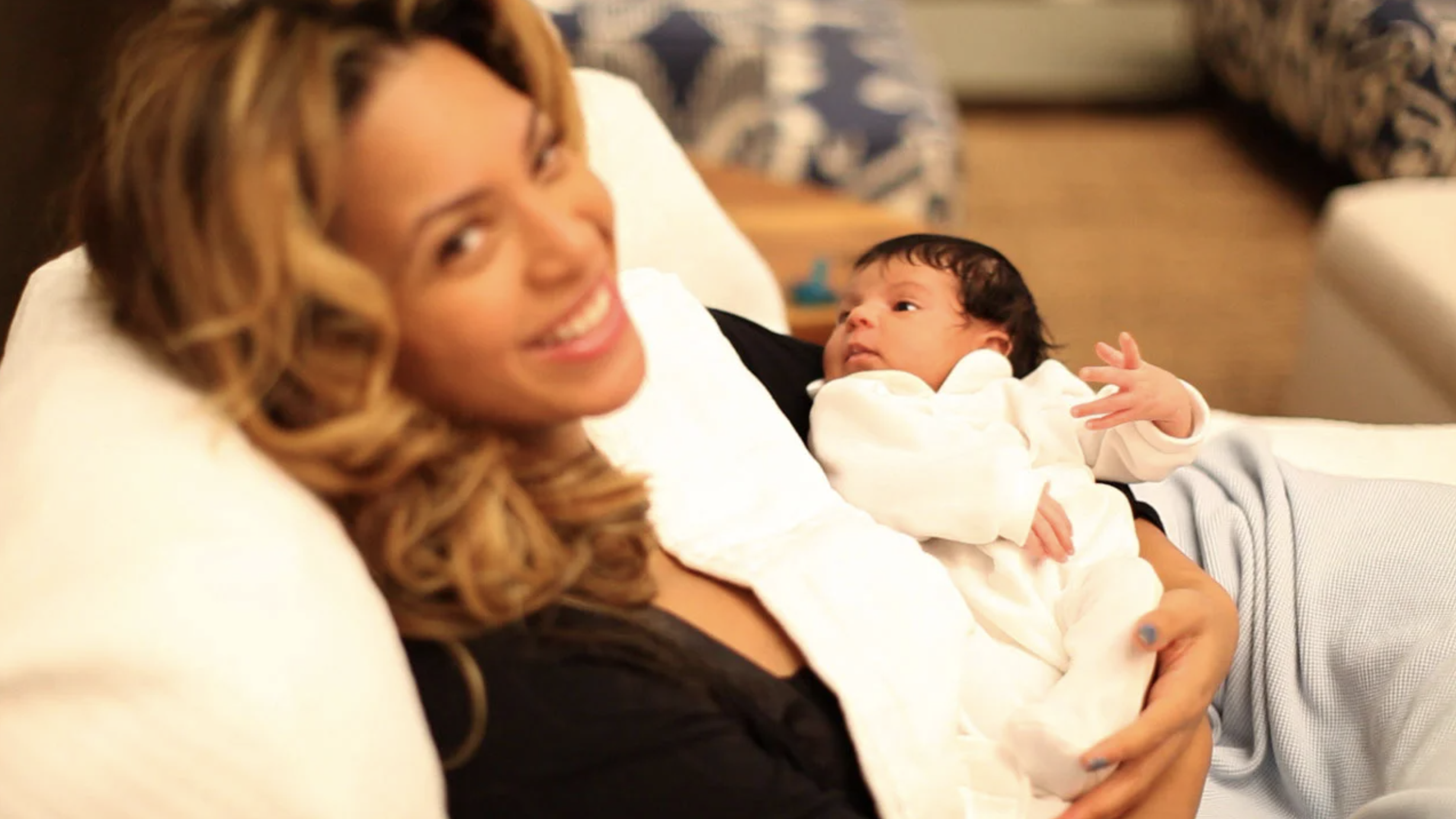
A couple of weeks after Blue’s birth, Etta James passed away from leukemia, one of numerous health conditions she’d been battling over the previous several years. According to her son, treatment for one of these had led to “drug-induced dementia,” which he credited with some of her comments about Beyoncé. The star issued another statement that was nothing but complimentary: “Playing Etta James taught me so much about myself, and singing her music inspired me to be a stronger artist.”
A few weeks after James’s death, Whitney Houston died by accidental drowning in her hotel bathtub; the coroner’s report attributed the incident to a mix of “heart disease and cocaine use.” The loss of another music great, and in such quick succession, cast a pall over the 2012 Grammys, which took place the very next day. In yet another statement, Beyoncé ‘painfully’ recalled meeting Houston for the first time as a teenager and praised her singular vocal talent.
In all, it had seemed a physically and emotionally taxing winter for the new mom, characterized as much by closed chapters as by new beginnings.
There was still more taxation to come, though it was the kind Beyoncé excelled at.
As it turned out, she’d done something to herself that was both evil and entirely on-brand, booking herself in for another four-night residency as early as May. The show was titled Back to Business, in a reference to the album era cut short by her pregnancy. Put differently, this was her chance to practice everything she’d preached on “Run the World.”
In 2018, Beyoncé would reflect on this moment more critically, telling Vogue:
I believed in the things society said about how my body should look. I put pressure on myself to lose all the baby weight in three months, and scheduled a small tour to assure I would do it. Looking back, that was crazy. I was still breastfeeding when I performed the Revel shows in Atlantic City in 2012.
Closer to this time, however, Beyoncé made her postpartum body—and especially the idea that she’d gotten it back, in a move other mothers might find empowering—a focus of her brand messaging. “It’s important that you don’t lose yourself, [that] you still have your own passions,” she explains in a ten-minute short called The Making of a Concert (2012), uploaded directly to the Revel Casino YouTube account the week of the shows. Produced by Parkwood but lacking credits, it’s exactly what it sounds like: the star and her team conceptualize, then build, a Beyoncé comeback show.
Parkwood appears a much more sophisticated operation than we’d seen a little less than a year prior in Year of 4; it now has a new—or at the very least, upgraded—office space complete with kitchen and pool table. There’s an air of self-sufficiency, that most of the short has actually been filmed here, which had not been true of the previous one. It’s also noticeable that Burke’s role has evolved beyond simply videography: in Behind the Camera, we’d gotten a clear look at him co-directing “1+1” and “Love on Top” with his boss, other team members serving as videographers instead. Similarly, in The Making of a Concert, Burke is probably the second-most central character, since we spend a lot of the short watching him and Beyoncé conceptualize the show’s LED screen content.
And as always: “This is why I didn’t sleep last night. This is why I slept at 5:30 in the morning.” “The whole reason for this shoot today is to have a good blueprint so we know what to choreograph with the lights… and I don’t know if everyone understands it like I understand it.” “We usually have two months to do what we’re doing in two weeks. But what is new?” Motherhood, it seems, had not so far changed the general thrust of the star’s documentaries.
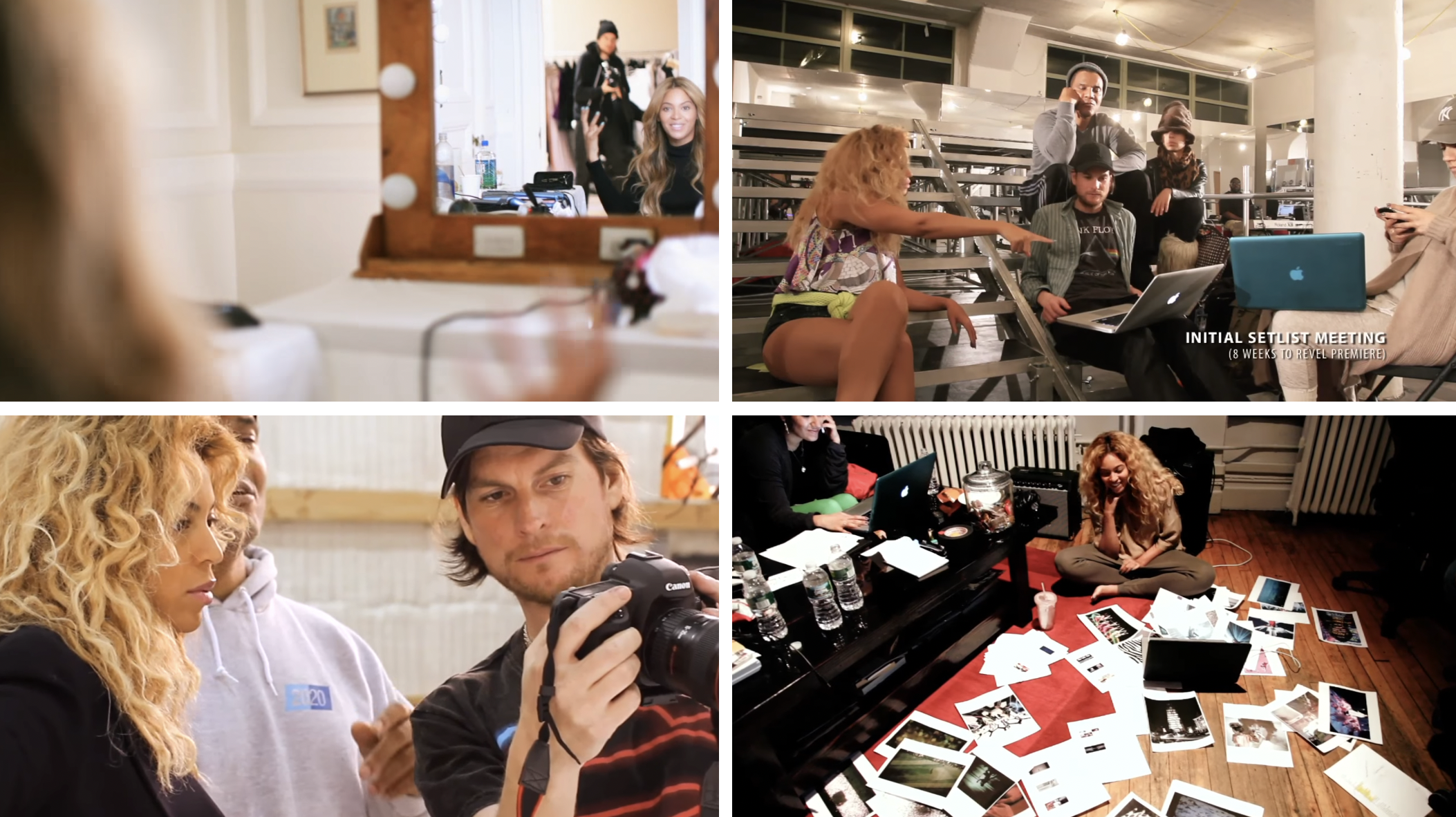
“For me to do all of this four months after giving birth,” she concludes, “I feel like I went from zero to ten, and it was really hard but I did it, so I’m hoping that somebody out there can be inspired by that.”
After Revel, Beyoncé moved her growing family to the Hamptons to begin work on what would be her most important album yet. According to her go-to engineer, Stuart White, “She rented a mansion with 40 bedrooms, and brought many of the world’s best producers out there so everyone could live in the house for a month.”
Melissa Vargas, another longtime colleague of Beyoncé’s, would describe the environment as akin to an episode of Survivor or The Real World. “There was only a certain number of people that could come, so if you were vibing with her and everything was going great, you would stay for longer.” Sounding a bit more idyllic, the star herself has explained, “We had dinner with the producers every day, like a family. It was like a camp. Weekends off. You could go and jump in the pool and ride bikes… the ocean and grass and sunshine … it was really a safe place.
It seems that when she wasn’t cuddling her baby or popping in on her producer-contestants in the studio, Beyoncé had started seriously pursuing the dream she’d shared almost three years prior, of making a documentary feature about her life. (This isn’t the most scientific way of doing things, but it was in July of 2012 that she was walking around with the same braids she’d eventually be wearing in the film’s main talking head.)
The good news was that she’d recently been given some reason to believe she could pull it off.
For one, I Am… World Tour had been among the nominees for Best Music Film at the Grammys in February. The project lost to James Moll’s Foo Fighters: Back and Forth (2011)—we’ll talk more in future chapters about the kinds of projects the award favours—but it was another important milestone for Beyoncé on her filmmaking journey; she’d never previously been Grammy-nominated for her visuals, and these days is the most-nominated artist in that category.
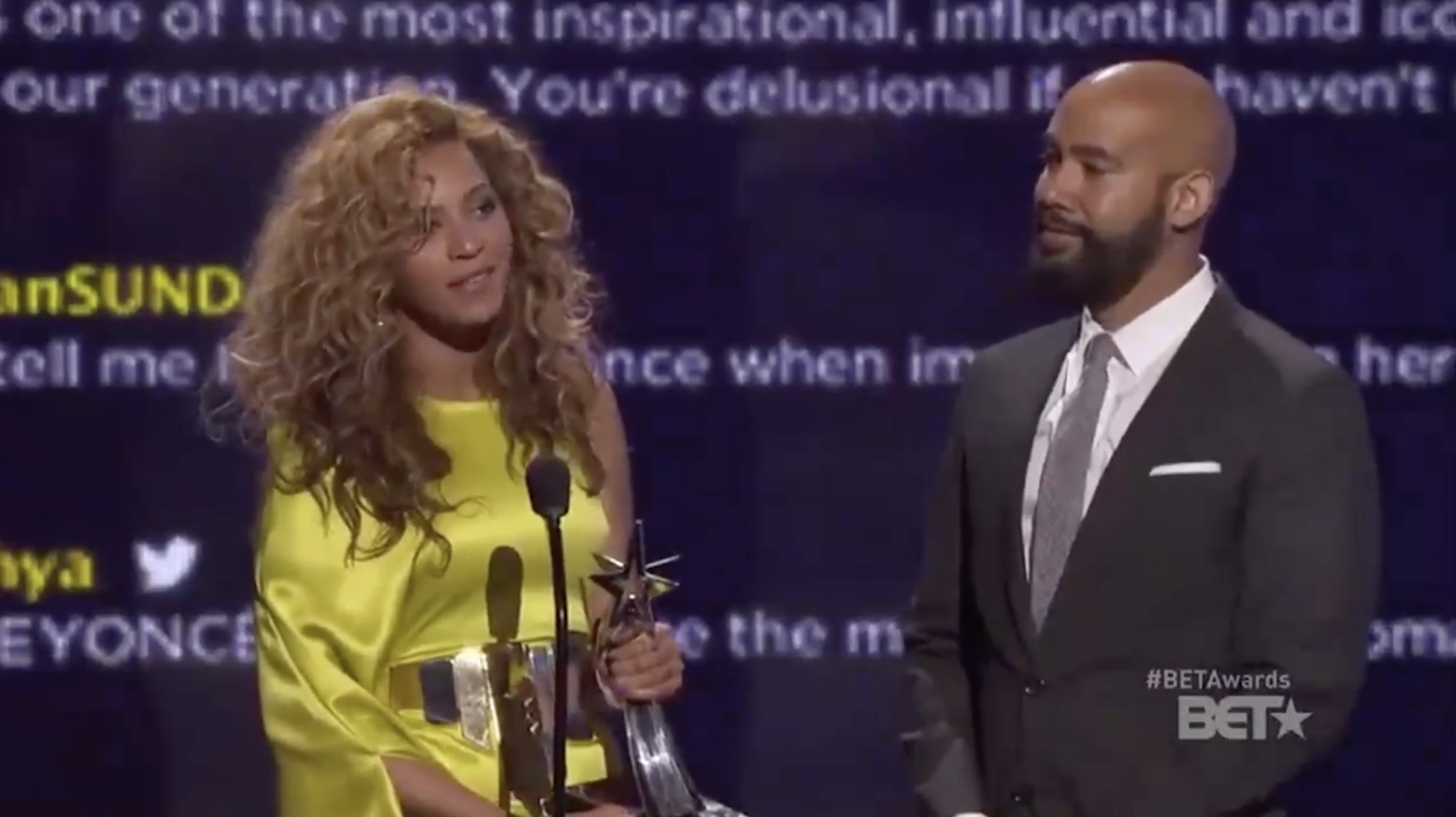
In July, she and Alan Ferguson had also co-received the BET Award for Video Director of the Year; prior to Lemonade, BET was the only organization that ever recognized Beyoncé as a director, and it would actually do so more than once. “Thank you for teaching me and my team so much about directing,” the star told her sister’s future husband during their acceptance speech, “and I’d like to thank Parkwood and all of the people that were involved in the two videos we made together. It was such a great opportunity to direct.”
The last few months of the year brought several Beyoncé-related announcements, all indicating that the star had big plans for 2013.
In October, it was reported that she’d pulled out from A Star Is Born, citing scheduling issues. “I was looking forward to the production … and the opportunity to work with Clint Eastwood,” she wrote in a statement. “For months we tried to coordinate our schedules to bring this remake to life but it was just not possible. Hopefully in the future we will get a chance to work together.”
She’d soon be starring in a new movie regardless, playing Queen Tara in the animated children’s film Epic (2013), which she seems to have completed work on by the end of 2012. “I’ve always imagined being in an animated film,” she says in the cast featurette, where she has the bangs she was walking around with in November and December—again not so scientific, but it works in a pinch.
Days after the A Star Is Born news, it was reported that Beyoncé would be headlining the Pepsi-sponsored Super Bowl halftime show in February. The gig would later be revealed as part of a $50 million deal she’d signed with the company, exceeding the bounds of your typical celebrity spokesmanship gig. “She agreed to be in a commercial,” Lee Anne Callahan-Longo would say, “but what was more important was creating … a content development fund to try to do more interesting things together.” As the New York Times put it, Pepsi had essentially agreed to foot millions of dollars’ worth of bills “to indulge Beyoncé’s creative whims, [which] might well have no explicit connection to Pepsi products.”
Finally, a month after the Super Bowl announcement—and a few weeks after Barack Obama was elected to a second term—it was reported that HBO was set to air Beyoncé’s forthcoming documentary the same February. The film was still untitled, but promised a wealth of revealing footage that was at least partly “captured on her laptop.”
Programming director Michael Lombardo had apparently been skeptical upon hearing that she’d self-directed it, citing the network’s credibility in the documentary space: “The notion of any person of note being responsible for the editorial choices in a story about themselves is something I approach with some degree of cynicism.” But he’d nevertheless found himself won over, explaining to GQ, “I was entranced. I couldn’t get it out of my head.”
At the top of this chapter, 26-year-old Beyoncé was still spending an awful lot of time chasing legends, just as she had all through the previous one. But much happened over the next five years—to the media landscape, to her life and family, to her sense of artistic adventure—that may have revealed a couple of cracks in the foundation on which she’d been building her career.
It had served her well to study the greats and receive blessings from so many, not just because it was flattering but because it cast a sheen of old-school glamour and perhaps respectability over her image. But she was now 31, having grown up and cleaned house, and there were things she wanted to say and do that may not have read as “smart” or “safe” to some of those forerunners. How do you honour history while still making it? At what point do you have to decide to be the legend yourself? ●
You can read the next chapter here.
PROJECTS DISCUSSED IN THIS CHAPTER*
*Directors are listed only on Beyoncé HQ-produced projects to visually distinguish those entries (all directors are listed somewhere in the text above). Projects on which Beyoncé herself had a locatable directorial credit are in bold.
Walmart Soundcheck: Beyoncé (2008) — directed by Mark Ritchie
Cadillac Records (2008) — directed by Darnell Martin
Obsessed (2009) — directed by Steve Shill
Above and Beyoncé: Video Collection & Dance Mixes (2009) — directed by Beyoncé, Philip Andelman, Melina Matsoukas, Sophie Muller, Jake Nava
Behind the Scenes: The Videos (2009) — directed by Ed Burke
Beyoncé: For the Record (2009) — directed by Tim Van Someren
I Am… Yours: An Intimate Performance at Wynn Las Vegas (2009) — directed by Nick Wickham
What Happens in Vegas (2009) — directed by Beyoncé, Ed Burke
“Why Don’t You Love Me” (2010) — directed by Beyoncé, Melina Matsoukas
I Am… World Tour (2010) — directed by Beyoncé, Ed Burke, Frank Gatson Jr.
Mic and a Light (2010) — directed by Beyoncé, Ed Burke
Year of 4 (2011) — directed by Beyoncé, Ed Burke
Elements of 4 (2011) — directed by Beyoncé, Ed Burke, Laurent Briet, Diane Martel, Alan Ferguson, Adria Petty, Francis Lawrence
Behind the Camera (2011) — directed by Beyoncé, Ed Burke
Live at Roseland (2011) — directed by Beyoncé, Ed Burke, Anthony Green
Behind the Stage (2011) — directed by Beyoncé, Ed Burke, Bill Kirstein
The Making of a Concert (2012) — director unknown/unlisted
Mononym Mythology is a newsletter by me, Sydney Urbanek, where I write about various intersections of popular music and moving images. If you got something out of this issue, feel free to share it with a friend or pick up one of the cappuccinos—I’m drinking cappuccinos now—I’ll need to finish the next issue. You can reply directly to this if you received it in your inbox, and otherwise my email is here. I’m also on X and Instagram.
